Invested Offers a New Way Forward in Used Vehicles 8 Jan 1:40 PM (2 months ago)
Today’s an exciting one—we’re officially announcing the release of my seventh book, Invested: The New Science, Strategy and System of Used Vehicle Investment Management, at the NADA Show this month in New Orleans.
My work on Invested, along with co-author Lance Helgeson, 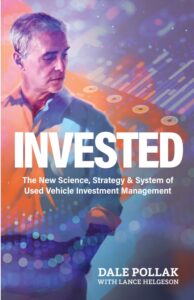 began about a year ago after we hosted vAuto’s Access: Innovation event in Chicago. While there, we talked about how the used vehicle market is returning to the levels of price and value efficiency that we saw in the years immediately preceding the pandemic. I’m sure many readers felt this reality in their financials for 2024—you probably sold more used vehicles than you did in 2023, but the net profit those vehicles delivered to the bottom line of your used vehicle department likely looks more like it did in 2019.
began about a year ago after we hosted vAuto’s Access: Innovation event in Chicago. While there, we talked about how the used vehicle market is returning to the levels of price and value efficiency that we saw in the years immediately preceding the pandemic. I’m sure many readers felt this reality in their financials for 2024—you probably sold more used vehicles than you did in 2023, but the net profit those vehicles delivered to the bottom line of your used vehicle department likely looks more like it did in 2019.
Invested examines some of the root causes of this dynamic, which we discovered by applying predictive data science to help us understand where common inventory management practices may fall short and how they might be improved. The data science revealed a few surprises, two of which I’ll share here:
- Dealers often manage used vehicles as merchandise, not investments. We came to this conclusion after using data science to help us know a) the investment potential of every used vehicle is unique and b) dealers often treat every vehicle the same, despite the inherent differences in each vehicle’s ROI potential. This “sameness” manifests as dealers apply the same mark-ups as they price vehicles and they often give distressed inventory too much time to find a buyer, resulting in less-than-optimal ROI outcomes. At the same time, dealers tend to short-sell their best investments, which is something the best financial advisors and investment portfolio managers avoid.
- Individual beliefs and biases play an outsize role in used vehicle decision-making. Invested reveals how the absence of a dealer-established investment strategy, across acquisition, appraising and pricing decisions, gives decision-makers a lot of latitude to do what they think is right for each vehicle. The book details how such latitude tends to serve the best interests of the individual, not the bottom line of the used vehicle department or the dealership.
I devote the bulk of Invested to helping dealers understand how they can turn the power of predictive data science to their advantage. In short, the book serves as the operations manual for dealers to establish and execute their preferred investment management strategy. The book also details how the vAuto team and I have built and enhanced our ProfitTime GPS solution to help dealers execute this strategy, and measure/monitor its effectiveness in real time, with every acquisition, appraising and pricing decision.
My work on the book, and the success I’ve seen with dealers who’ve fully adopted an investment management strategy to guide their used vehicle departments, leaves me convinced that this new approach will serve as a kind of Great Divide: If you’re on the investment management path in used vehicles, you trust the predictive data science that drives it and you follow the principles, you’ll sell more and make more than tradition-minded dealers, who’ll remain trapped in today’s ROI spiral.
Stop by vAuto’s booth at NADA (#2506) where you can pick up your copy of Invested and chart your own new way forward. See you in New Orleans!
The post Invested Offers a New Way Forward in Used Vehicles appeared first on Dale Pollak.
A Good News Story for Dealers Heading Into 2025 20 Dec 2024 7:39 AM (3 months ago)
Every person who purchases a vehicle eventually arrives at a point of recognition: Now’s the time to pull the trigger and buy the car.
Perhaps the best news for dealers as we head into 2025 is that  a confluence of conditions has flipped a switch: There are a lot of reasons why consumers, in this moment, appear to believe that it’s better to buy a vehicle now rather than delay their purchase.
a confluence of conditions has flipped a switch: There are a lot of reasons why consumers, in this moment, appear to believe that it’s better to buy a vehicle now rather than delay their purchase.
On an industry call this week, which I’d encourage every dealer to check out, Cox Automotive chief economist Jonathan Smoke summed the situation this way: “Buy now or at least buy sooner rather than later seems to be the new marching cry.”
If we think about this past year, vehicle buyers had a lot of reasons to hold out. At various times, vehicle affordability, credit availability and the relatively steady decline in new/used vehicle prices were factors that suppressed retail sales. Right now, consumer concerns about rising inflation, the prospect of tariffs raising vehicle purchase costs and new federal fiscal and tax policy (including a possible sunset of tax credits that have spurred EV sales) serve as key catalysts for the current buy sooner rather than later mentality.
Smoke and others see sales momentum building in the market as we head into the new year. “The sun appears to be coming out, but there’s always a twist,” he shared on this week’s call. The optimism squares with what I’m hearing in my conversations with dealers. They’re feeling pretty good, even if profitability isn’t where they’d like it to be.
Generally speaking, the outlook for used vehicles is positive for 2025. Cox Automotive forecasts overall retail sales will grow 1.2 percent to 20.1 million next year. Analysts also noted a couple areas of potential pain or opportunity I thought I’d call out here:
CPO supply pressure. Cox Automotive forecasts that overall certified pre-owned retail sales volumes will be lower next year compared to this year—2.5 million total, down 1.6 percent. Constrained supply is the primary reason for the expected shortfall. The upshot for dealers: If you want to maintain or strengthen your CPO game, you’ll need to be ever-more proactive about sourcing the inventory outside of auctions, especially since they’re currently the go-to source for many dealers.
EVs. I was asked the other day how I’d describe dealers’ prevailing regard for used EVs. The answer: They’re wary, for a lot of good reasons, not the least of which is price volatility in the new EV market. Even so, you can’t deny that the market for used EVs is on the rise, especially as we face the prospect that EV tax credits might go away. I recognize that it can be hard for dealers who have avoided EVs, and don’t have a history of sales, to know how many to stock and how best to price them. If I fit this description, I’d be leaning into the live market data I get in my inventory management system for the answers. In many cases, dealers will find opportunities to step into, and build, their used EV sales share.
The Cox Automotive call also included another nugget about dealers being increasingly concerned about “competition.” To be sure, it’s a lower-level concern than the economy or interest rates. Still, I found myself scratching my head. Why would dealers be worried about the competition when sales volumes are good, the pool of potential buyers is growing and the number of dealers is basically the same?
I concluded the sentiment might be a form of projection—more revealing about the operational inefficiencies dealers know they should fix than anything else. If that’s the case, there’s no better time than right now to get on it.
Happy holidays and my best, warmest wishes to you/yours!
The post A Good News Story for Dealers Heading Into 2025 appeared first on Dale Pollak.
When the Right Money Goes Wrong in Used Vehicles 13 Dec 2024 8:54 AM (3 months ago)
Let’s imagine your appraiser valued a trade-in at $15,500—smack dab in the middle of a range your inventory management solution recommended as the “right money” for the vehicle.
Your inventory management solution arrived at the right money recommendation  by assessing the vehicle’s investment return potential and the dealer’s strategic gross/volume objectives, the vehicle’s competitive appeal and price sensitivity in the retail market, the appraiser’s reconditioning estimates, the vehicle’s cost and any other costs (i.e., a pack) the dealer typically adds to vehicles they intend to retail.
by assessing the vehicle’s investment return potential and the dealer’s strategic gross/volume objectives, the vehicle’s competitive appeal and price sensitivity in the retail market, the appraiser’s reconditioning estimates, the vehicle’s cost and any other costs (i.e., a pack) the dealer typically adds to vehicles they intend to retail.
At this point, there should be no debate or discussion that the appraiser did a good job. The $15,500 appraisal offer landed the vehicle. The dealer now owns it the “right money” as defined by their strategic objectives and the system’s recommendations. The customer’s happy with the trade-in value and transaction.
But as I noted in an earlier post, and write about in my new book, Invested: The New Science, Strategy and System of Used Vehicle Investment Management*, there are often times that the right money, in this case $15,500, can go wrong. Let’s examine a few:
A manager bumps the trade-in value to make the customer’s purchase of another vehicle work. Maybe the customer refused to buy the other vehicle unless the manager discounted the purchase price by an additional $500. The manager says “yes” and decides to bump the customer’s appraised trade-in value by the same amount. Suddenly, the right money of $15,500 becomes $16,000. It’s an example of the right money going wrong for what might be a good reason.
A manager decides to override the retail price range recommendation the inventory management system calculated to achieve the dealer’s desired volume or gross objective. In this hypothetical, the system advised a retail price recommendation around $18,000, which would translate to a $2,500 front-end gross profit potential based on the appraiser’s $15,500 valuation. But the manager has a different idea, maybe because of an appraisal bump or maybe because they are feeling pressure to make gross. Whatever the case, the manager decides to price the vehicle at $19,000, a decision that means the right money has gone wrong again.
A week after the vehicle’s been in inventory, the reconditioning RO clears. The appraiser’s original estimate wasn’t as accurate as everyone thought. The car had a mechanical issue that cost an additional $1,000 to fix. Now, instead of owning the vehicle for $15,500, the dealership owns the vehicle for $16,500, another instance where the right money goes wrong.
Collectively, these scenarios represent a breakdown of the retail exit strategy the dealership determined for the vehicle at the time of acquisition/appraisal. In my view, the retail exit strategy you determine at the time of appraisal must extend through its pricing and its eventual retail sale, even if its cost basis has changed for less-than-ideal reasons.
Unfortunately, dealers and used vehicle managers often aren’t aware that when you alter the retail exit strategy defined during the appraisal, you’re overlooking the fact that it’s the same car in the same market. The only thing that has changed is that the right money for a vehicle has gone wrong. If you pretend otherwise as you price and sell the vehicle, you’re inviting risk that the wrong money will go really wrong by the time you move the car,
* Invested will be available at NADA 2025 at vAuto’s booth (#2506). Stop by to get your copy.
The post When the Right Money Goes Wrong in Used Vehicles appeared first on Dale Pollak.
A Heartfelt Thank-You and a Clarifier 22 Nov 2024 7:27 AM (4 months ago)
My heartfelt and sincere thanks for the outpouring of love and support following yesterday’s announcement that I’ll be leaving Cox Automotive at the end of 2025.
My wife, Nancy, captured the feeling I felt through the  day: “It’s like you get to hear all the wonderful things people say and think about you, even though it’s not your funeral.”
day: “It’s like you get to hear all the wonderful things people say and think about you, even though it’s not your funeral.”
With the hundreds of comments and likes across my social media pages, I’m not able to respond to everyone individually. But, make no mistake, you all mean the world to me. I’m truly blessed to have such deeply felt, industry-wide recognition and respect.
This moment seems right to call out two things:
First, I’m not retiring. I know. That’s the road many travel when they reach my age. But I’m as committed and excited as ever to join the Cox Automotive team at NADA 2025 in New Orleans and through the year ahead. As the announcement notes, I’ve spent the past two decades pouring myself into my mission of helping dealers and achieving success for vAuto and Cox Automotive. Along the way, I’ve parked some ideas and opportunities—things I’ll revisit and explore as 2026 unfolds.
Second, so many of yesterday’s comments and conversations brought me to a passage I wrote for the preface of my next book, Invested: The New Science, Strategy and System of Used Vehicle Investment Management, which will be available at NADA:
“When I first set foot in this industry, I was driven by a desire to innovate, to create solutions that would not only streamline operations but also transform how we perceive value and success for used vehicle departments.
The years that followed were marked by challenges, triumphs, and an unwavering commitment to excellence. Each innovation, each step forward was an investment in a vision I believed could redefine our industry.
Now, as I anticipate the future, I am filled with excitement and curiosity. As I think about what’s to come, it brings a profound contemplation of what it means to invest a lifetime into something greater than oneself. While I have witnessed the tangible returns of my efforts in the form of appreciation and the respect of the industry and the people I have had the privilege to serve, there is a lingering question: How will I continue to realize the investment return from my work as I have in the past?”
I’ll be working to answer this question in months and years ahead. In the meantime, my deep gratitude goes to all of you. My experience yesterday is proof positive that when you give yourself to serve others, you get way more in return than you can imagine.
The post A Heartfelt Thank-You and a Clarifier appeared first on Dale Pollak.
How to Define the “Right Money” for Any Used Vehicle 20 Nov 2024 7:14 AM (4 months ago)
An age-old and elusive question in the used car business is, “what’s the right money for a car?”
I would submit that, in most dealerships and used vehicle departments, no one has a good answer. When I ask the question of a dealer or used vehicle manager, the answer I get most often is, “it depends.” It’s rare to find anyone who can clearly articulate what the right money for any vehicle should be.
departments, no one has a good answer. When I ask the question of a dealer or used vehicle manager, the answer I get most often is, “it depends.” It’s rare to find anyone who can clearly articulate what the right money for any vehicle should be.
Over the years, I’ve come to understand that our inability to answer the right money question leads to a lot of sub-optimal outcomes. If no one has a clear understanding of what the right money for a vehicle should be, chances are better than good that your appraisers and buyers are acquiring used vehicles for something other than the right money. In effect, they decide what the right money should be, based on whatever approach they use to define it for themselves. This is why dealers often worry that appraisers put too much into vehicles they acquire and too little into vehicles they miss.
This dynamic leads to the high degree of variability we see in the performance metrics dealers typically use to measure appraiser performance. Their Cost to Market and Look to Book averages are often all over the board. It’s only on occasion that reconditioning estimates captured in appraisals accurately reflect the work a vehicle needs. It’s why some dealers hold save-a-deal meetings, where they make a second or third attempt to get the money right for a vehicle.
I’ve given our industry’s collective difficulty in answering the right money question a lot of thought. I’ve made it a central topic of conversation with dozens of dealers, and I’ve come to a singular conclusion: We don’t know what the right money for any vehicle should be because of an inability on the part of dealers to define it, based on their strategic retailing objectives, and bring this insight to every appraiser in every appraisal situation.
But now, there’s a better way.
My next book, Invested: The New Science, Strategy and System of Used Vehicle Investment Management, which I’ll be releasing at the upcoming NADA convention in New Orleans, details how dealers can use a new appraisal system inside ProfitTime GPS to define the right money for any vehicle and make sure appraisers know the right money whenever they evaluate a vehicle.
A big part of this story is the system’s use of data science-driven insights that tell you the quality of a vehicle as an investment at the time of appraisal. The system also knows the dealer’s strategic objective, whether they are going for gross, volume or a combination of both in a given month, and whether you need the vehicle or you don’t. With all that, the appraisal system inside ProfitTime GPS offers up a recommended appraisal range to help appraisers bring in the vehicle for what the dealer has defined as the right money. The system also gives appraisers flexibility to make deals, while letting everyone know when a vehicle has been acquired for something other than the right money the dealer defined and desired.
As I write about in the book, the system’s a game-changer for dealers because their new-found ability to define the right money for any vehicle, based on their strategy, means appraisers bring more vehicles into their used vehicle inventories for the right money. In turn, there’s less variability as appraisers evaluate vehicles, and less likelihood that someone will price a vehicle incorrectly because the money you paid for it wasn’t right.
Therein lies a topic I also address in Invested and will share in an upcoming post—how to prevent the right money from going wrong once you own a vehicle.
The post How to Define the “Right Money” for Any Used Vehicle appeared first on Dale Pollak.
A Current Events-Minded View of Vehicle Affordability 11 Nov 2024 7:49 AM (4 months ago)
It’s encouraging to see some OEMs reduce MSRPs on incoming 2025 models to help address one of our industry’s top challenges—with an average transaction price for a new vehicle north of $47,000, it’s difficult for a large swath of would-be buyers to afford a new vehicle.
But analysts and observers don’t think the MSRP reductions 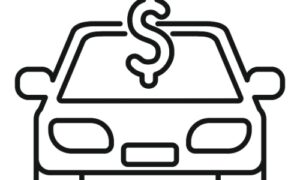 will have a significant impact on the affordability challenge, especially as they expect OEMs to diminish incentive spending in kind. This fall, incentive spending has averaged more than 7 percent of transaction prices (about $3,500) in recent weeks. At the same time in 2019, incentives were running nearly 10 percent of transaction prices.
will have a significant impact on the affordability challenge, especially as they expect OEMs to diminish incentive spending in kind. This fall, incentive spending has averaged more than 7 percent of transaction prices (about $3,500) in recent weeks. At the same time in 2019, incentives were running nearly 10 percent of transaction prices.
“I’d expect to see incentives to remain high on 2024 models as OEMs help dealers clear the inventory,” a new vehicle analyst shared. “But we’ll probably start the new year with lower levels of incentive spending than we’ve seen lately.”
Such dynamics mean the average transaction price for buyers will effectively remain the same—and the pressure on dealers to move aging or excess new vehicle inventory will continue.
Meanwhile, the Federal Reserve’s decision last week to cut interest rates by another quarter percent is also expected to ease the affordability challenge. But the impact will take time. So far, we haven’t seen auto loan rates shift significantly from the Fed’s rate-cutting this fall. The big question is whether the Fed will continue down this rate-cutting path to provide more tangible relief.
Therein lies a big unknown. At the Fed’s meeting last week, chairman Jerome Powell noted that with a new president and Congress taking office in January, it’s difficult to chart a course forward.
“We don’t guess, we don’t speculate and we don’t assume,” Powell said. “We don’t know what the timing and substance of any policy changes will be. We therefore don’t know what the effects on the economy will be.”
Some of the uncertainty owes to a promise President-elect Donald Trump made on the campaign trail to increase tariffs on imports to spur domestic manufacturing, a policy that many believe would lead to higher vehicle costs. There’s also uncertainty around how President-elect Trump will treat current tax credits for EV purchases, which has helped spur demand and sales for dealers, particularly with used EVs.
In the end, time will tell whether we see vehicle affordability improve and become less of a headwind for vehicle sales than it is today. In the meantime, it’ll be important for dealers to do what you do best—stay attuned to your market, your inventory and your customers to capitalize on the opportunities that will inevitably arise on the road ahead.
The post A Current Events-Minded View of Vehicle Affordability appeared first on Dale Pollak.
A Disturbing Trendline in Used Vehicle ROI 5 Nov 2024 9:26 AM (4 months ago)
Across the country, most dealers have seen their used vehicle gross profits decline this year to essentially land where they were in 2019, before the pandemic.
Back then, the front-end gross profit average for public dealer groups was about $1,430. Today, the front-end gross profit average for public dealer groups  through the third quarter runs about $1,600.
through the third quarter runs about $1,600.
Some might see these numbers and think: Well, that’s not so bad. It’s five years later, and the data shows the groups are making more gross on a per-car basis.
But this quick assessment only scratches the surface. Yes, the gross profit in pure dollars might look better, but are dealers today realizing a richer Return on Investment for used vehicles than they did in 2019?
To answer this question, I asked CoPilot, Microsoft’s generative Artificial Intelligence tool, to help paint the comparative ROI picture in used vehicles in 2019 compared to today. I primed CoPilot with a couple data points that are necessary to calculate ROI—the average cost of investment, the average amount of time it takes to sell the investment and the gross profit the sale of the investment produced.
For the average cost of investment, I used Manheim’s average MMR for 2019 ($12,848) and its current year to date average ($18,928) as proxies. (Note: The average investment cost for many dealers currently runs closer to $25,000; the MMR average doesn’t capture any additional costs dealers typically ascribe to individual vehicles.) For the time it takes to sell an investment, I used 45 days. I drew the gross profit averages from public dealer group financials. Here’s what CoPilot produced:
2019: The annualized ROI for a $12,848 investment that sold in 45 days and generated $1,432 in front gross is 135.6 percent.
2024: The annualized ROI for for a $18,928 investment that sold in 45 days and generated $1,600 in gross profit is 82.9 percent.
This decline in used vehicle ROI signals a disturbing trend: Dealers must pay ever-higher amounts to acquire and retail used vehicles, while the front-end gross profit averages they achieve for selling these higher-cost investments isn’t significantly different. We can also reasonably presume that the average used vehicle investment cost in the future will be higher, and the ROI you achieve will be lower, assuming you do nothing different.
As I’ve shared this portrait of used vehicle ROI in decline with dealers, it often catches them by surprise. Many judge the strength and success of their used vehicle departments based on the average gross they produce and the number of vehicles they sell. They don’t consider ROI as they manage each retail used vehicle investment to its sale. They don’t judge an individual used vehicle deal based on the ROI it produced. They don’t evaluate ROI as they assess the financial performance of their used vehicle departments.
I consider the near-total absence of ROI awareness among dealers as a significant problem and opportunity. It’s a problem if you don’t do anything different in the way you acquire, manage and retail vehicles. Over time, as investment costs grow and market conditions put pressure on gross profits, some dealers will find themselves exactly where they were in 2019—moving a lot of used vehicles but not making any money.
The opportunity rests with tackling the ROI trend head-on. If you understand how to manage each used vehicle to achieve its optimal ROI outcome, you’re doing everything you can to proactively maximize the money you make for each investment and the used vehicle department. That’s exactly why the vAuto team and I developed ProfitTime GPS and the ROI-focused Variable Management strategy it supports.
My next book, Invested, goes into greater detail on how dealers can seize their own ROI opportunity. The book will be available at the upcoming NADA convention in New Orleans.
In the meantime, I’d encourage dealers to evaluate how your used vehicle ROI has changed over time. While your numbers might be different than those I’ve shared here, I think you’ll agree that the analysis and findings are cause for concern and perhaps a catalyst to find a new way forward.
The post A Disturbing Trendline in Used Vehicle ROI appeared first on Dale Pollak.
A Taste of Autonomous Driving Proves Profound 26 Oct 2024 2:11 PM (5 months ago)
This past week, my wife Nancy and I were in San Francisco for a conference and had the opportunity to use Waymo’s autonomous ride service several times in the downtown area as we moved from place to place.
The ride struck me as both coincidental and profound. Just a week earlier, I’d marveled at the way an autonomous vehicle, without anyone inside, maneuvered through traffic in Austin. A few days later, I was in the back seat, marveling at how well the vehicle navigated its way through the winding hills and streets of San Francisco.
Just a week earlier, I’d marveled at the way an autonomous vehicle, without anyone inside, maneuvered through traffic in Austin. A few days later, I was in the back seat, marveling at how well the vehicle navigated its way through the winding hills and streets of San Francisco.
Overall, my sense is that while Level 5 autonomous driving is limited to specific areas, the technology has most certainly arrived. I was impressed when I heard a siren and the car moved to the right to let a fire truck pass. Same for when a vehicle was double-parked and blocked our path on a street. The car slowed down to let oncoming vehicles pass, and then went around the obstacle. When we were heading up a hill, the vehicle did the equivalent of hitting the gas to make the climb. At stop signs behind other vehicles, the car inched forward, just like most drivers do as they approach an intersection.
Beyond the human-like nature of the vehicle’s driving ability, Nancy and I appreciated the human touches the vehicle offered as we used the Waymo app to unlock the door and get in. A voice welcomed us by name. It played music, and gave us the option to speak to someone if we needed it.
To be sure, the experience was a bit creepy. But, in the end, it was more cool than creepy.
I also couldn’t help but think that at its most basic level, the vehicle’s human-like driving ability boiled down to a bunch of code. Pretty amazing.
I left town know I have no qualms about taking another ride in a fully autonomous vehicle, and that while the pandemic may have stalled efforts by Waymo and other providers to scale their services, it’s only a matter of time before they do.
The post A Taste of Autonomous Driving Proves Profound appeared first on Dale Pollak.
Reflecting on Cars and Mobility Moments 18 Oct 2024 8:03 AM (5 months ago)
On our way home from dinner the other night in Austin, TX, my son, Samson, and I did a double take as we stopped at a red light along Cesar Chavez Street.  A car pulled up alongside us that made us both wonder: Are flying cars next?
A car pulled up alongside us that made us both wonder: Are flying cars next?
The odd vehicle sighting, which I’ll explain more in a minute, got me thinking about all the different vehicles that have been memorable throughout my life. They include:
A white Buick Estate Wagon: This car’s memorable because its inaugural journey took the entire Pollak family—my Mom, my Dad, my three brothers and me—and all our luggage to Monterrey, Mexico. We probably spent close to 25 hours driving to get there. At the time, I remember thinking, why are we here? We were staying at a Ramada Inn in what appeared to be an industrial town.
A Navy Blue Opel Kadett: As the son of a Buick dealer, I could have chosen just about any vehicle as the first one I owned outright. I liked the Kadett. It wasn’t anything special as a car, but it was special to me. My Kadett represented freedom.
A Chevrolet Volt: We were among the first in the Chicago area to own a Chevrolet Volt when it debuted in late 2010. At the time, gas prices ran close to $3 a gallon in our area—a catalyst for the Volt’s “Revolt” vanity plates. I remember being impressed by the Volt battery’s staying power. I certainly didn’t miss trips to gas stations.
A Tesla Model X. Almost a decade ago, Tesla located one of its service centers in the Chicago suburbs. A former colleague and friend who worked for Tesla arranged to have a Model X (and a driver) pick me up from my house. I was curious about the vehicle’s self-driving capability. On the highway, we let the car drive itself. It was a little unnerving for me to know that the car was driving itself, even though I knew the driver had his eyes on the road and hands close to the wheel. I was also impressed by the vehicle’s head-snapping power.
The autonomous vehicle ride brings me to the stoplight the other night in Austin. The car on our left at the light was empty. No one in the front or back seats. When the light turned green, the car hit the 35 mph speed limit fairly quickly, and we noticed all the sensors/other equipment on the roof. A few blocks later, the vehicle turned left and drove off.
My son and I figured the vehicle must be part of some company’s autonomous vehicle testing program. Whatever the case, we agreed it was a spooky mobility moment that seemed appropriate for this time of year. It also led to reminiscing about past vehicles and wondering how long it’ll be before flying cars dot the skies.
The post Reflecting on Cars and Mobility Moments appeared first on Dale Pollak.
Can We Stop the “Chase” in Our Used Vehicle Pricing? 16 Oct 2024 8:04 AM (5 months ago)
As I talk to dealers week after week about their aged and distressed inventory, it doesn’t take long to uncover a distinct pattern: Someone is pretending the vehicle deserves a shot to make gross despite all signs suggesting otherwise.
I see the pattern in the inventories of ProfitTime GPS dealers,  where the system recommends a move-it-quick pricing recommendation on Day 1 for a Bronze vehicle (i.e., a unit with the least ROI or profit potential). Even so, the vehicle’s been priced significantly higher than the recommendation, either becomes someone didn’t see or ignored it. We all know what happens next. The vehicle doesn’t sell. After 30 days or more, someone finally decides to price the vehicle to move. Unfortunately, by this time, the price required to move the vehicle results in a low-gross or net loss when it sells.
where the system recommends a move-it-quick pricing recommendation on Day 1 for a Bronze vehicle (i.e., a unit with the least ROI or profit potential). Even so, the vehicle’s been priced significantly higher than the recommendation, either becomes someone didn’t see or ignored it. We all know what happens next. The vehicle doesn’t sell. After 30 days or more, someone finally decides to price the vehicle to move. Unfortunately, by this time, the price required to move the vehicle results in a low-gross or net loss when it sells.
The other day, a friend observed that the behavior of pricing a vehicle that’s in distress as if it isn’t in distress is the equivalent or at least a close cousin of the “chase” in poker. That’s where a player has a weak hand and believes they can improve it through subsequent draws and bets. By the time the dealing’s done and the cards are on the table, the player would have been far better off if they had folded right away, and didn’t pretend their hand was something that it wasn’t.
The problem with used vehicle pricing and poker is that both have been built on the tempting prospects of hope and possibility. With a used vehicle, you might get lucky and find a buyer willing to pay more than the vehicle’s worth. In poker, you might get lucky and land the card that turns a weak hand into a winner.
As humans we’re wired to remember the situations where a positive outcome, either in used vehicle or poker, defied the odds—which is exactly why we seem so ready and willing to defy them again, even if the evidence in front of us indicates the outcome won’t be good.
My next book, Invested: The New Science, Strategy and System of Used Vehicle Investment Management, discusses how the long-standing beliefs and biases of used vehicle managers continue to contribute to sub-optimal profit or ROI outcomes for dealers. It highlights how it’s often difficult for dealers and their managers to accept that pricing a vehicle for a loss on Day 1, the equivalent to folding a weak hand in poker right away, is truly the best thing to do from an investment perspective.
The book also details what happens when you avoid the chase in used vehicle pricing. You sell your Bronze vehicles faster, typically for a higher gross or ROI than you’d achieve if you held them longer. Your overall volume improves because you’re not sitting on vehicles that are priced not to sell. In addition, your overall profitability improves because, as you move Bronze vehicles faster, there’s less need or temptation to short-sell your best cars (i.e., the ones ProfitTime classifies as Platinum and Gold) to achieve your volume targets.
The book will be available at the upcoming NADA convention in New Orleans. Until then, I’d suggest that dealers take a moment to see how often their used vehicle pricing amounts to a chase to achieve a result they’ll never realize. In the end, the faster you put an end to the chase, the better off your investment returns will be.
The post Can We Stop the “Chase” in Our Used Vehicle Pricing? appeared first on Dale Pollak.
Assessing Your Used Vehicle Acquisition Proficiency 9 Oct 2024 7:53 AM (5 months ago)
This week, Cox Automotive reported that retail sales of used vehicles, while trending above last year’s sales volumes, have tapered off in recent weeks. The report also notes that the days supply of used vehicles on dealers’ lots is running close to 45 days, a few days less than the same time in the past two years.
Perhaps most important, the report notes that supplies  of used vehicles are expected to remain tight through the end of the year.
of used vehicles are expected to remain tight through the end of the year.
Such circumstances will put dealers to the test, particularly for those where “go get some cars” is your typical MO when you need inventory. The fact is, given the variability and value volatility across vehicle model years, segments and powertrains, many dealers need to sharpen how they think about stocking inventory and how they can most efficiently acquire it.
Below, I’ve distilled some of the key principles I’ve gleaned from top-performing dealers as it relates to vehicle acquisition. These principles, and the extent to which they exist in your dealership, offer a way for you to check your acquisition proficiency. They also serve as the foundation of a fresh approach to acquiring inventory that I write about in my upcoming book, Invested: The New Science, Strategy and System for Used Vehicle Investment Management. The principles also shaped the tools we’ve built inside ProfitTime GPS to help dealers consistently maintain the right number and mix of vehicles in inventory.
Do you have a stocking strategy? For some dealers, the stocking strategy is pretty simple: We want to sell 80 units a month, so let’s stock between 80 and 100 or so to meet our sales goals. While this approach can work, it’s not likely to work as well as a strategy that accounts for the specific types of vehicles you should stock, and how many of them you should stock at any given time. The best stocking strategies break down a dealer’s inventory by vehicle segments (i.e., compact, mid-sized SUV, pick-up, etc.) and price points (i.e., <$10,000, $10,000-$15,000, $15,000-$20,000, etc.). From there, dealers determine how many vehicles to stock in each segment, based on an analysis of their segment-based sales in the past, and current sales by segment in the current market.
When’s the last time you updated your stocking strategy? It wasn’t all that long ago that dealers tended to follow a “set it and forget it” approach to their stocking strategies. It would be many months, or even a year or two, before someone took a moment to review the strategy and see how well it compared to current market sales trends. Today, I’d recommend that dealers conduct this review on at least a quarterly, if not monthly, basis, given how quickly market conditions can change.
Where do you plan to acquire the vehicles? In the past two to three years, as used vehicle supplies have been constrained and one-to-three-year-old vehicles have become harder to acquire, the best dealers have added another layer to their stocking strategy. That is, they’ll forecast the volume of vehicles they expect to acquire from individual sourcing channels, such as auctions, trade-ins, service lane, lease returns, off-street, etc. Such channel-specific objectives work best when they’re based on an honest assessment of what you can reasonably expect to acquire, not what you aspire to acquire from an individual channel.
What are your profit or ROI objectives for vehicles you acquire from each channel? Not long ago, we weren’t asking this increasingly important question. We typically acquired vehicles from auctions, trade-ins or lease returns, and we pretty much expected the same front-end gross or profit outcome with every vehicle we acquired—even if we knew we paid up to acquire an auction vehicle. Today, we know better. When dealers track the profit or ROI potential by sourcing channel, it becomes clear fairly quickly that your average Cost to Market or ProfitTime investment score varies by channel due to the unique nature of customer needs and available vehicles in each channel.
How are you addressing your performance improvement opportunities? The best dealers have long made it a daily practice to start each business day with a review of the prior day’s trade-ins to affirm or update an appraiser’s assessment of the vehicle and its optimal exit strategy. But I’d submit that such discussions rarely extend to vehicles you acquire in other channels and the performance of the individuals you’ve tasked with acquiring vehicles in a specific channel. For many dealers, such next-day discussions and ongoing channel-specific reviews offer a management opportunity.
I should note that while this acquisition proficiency check isn’t an end-all, be-all, the elements I’ve outlined here all point to an outcome we all know to be true—the dealer with the best cars in stock to sell is the one most likely to win a buyer’s business.
The post Assessing Your Used Vehicle Acquisition Proficiency appeared first on Dale Pollak.
Keeping An Eye Out for Opportunity and Showing Compassion 4 Oct 2024 7:27 AM (6 months ago)
If you haven’t read former dealer Todd Caputo’s post on how the confluence of Hurricane Helene, the longshoreman strike (which, thankfully has been tentatively resolved), the escalating conflict in the Middle East and the upcoming presidential election may  affect the car business, I’d encourage you to do so.
affect the car business, I’d encourage you to do so.
Caputo offers a thoughtful, prescriptive take on how the combination of these headline-making events may shape consumer interest in purchasing vehicles and how dealers might move forward. The piece underscores why I have long considered Caputo one of the most savvy and smart operators I’ve met in all my years in the car business.
Here, I thought I’d take a moment to drill a bit deeper into a couple points Caputo makes in his piece:
Exercise caution at auction. Caputo rightly says that the extensive loss of vehicles due to Hurricane Helene will further tighten the supply of vehicles in the wholesale market and spur inflated prices at auctions. As Caputo notes, the best way to avoid the risk is to do everything you can to acquire the inventory you need in non-auction channels. That means now’s the time to put an even greater emphasis on making sure you aren’t losing trade-in or other customer vehicle acquisition opportunities due to a sub-optimal experience for the customer or a less-than-fair offer.
Expect higher demand for lower-cost used vehicles. Cox Automotive data shows that the mix of inventory dealers carry has shifted a bit to older, higher-mileage vehicles. The average age of vehicles in dealer inventories is approaching six years, and the share of 10-year-old-and-older vehicles is up to 16 percent. The shift owes to dealers’ need to retail vehicles today’s budget-minded buyers can afford. In the weeks and months ahead, however, demand for these vehicles is likely to increase, putting pressure on your ability to buy them as cost effectively as you have in the past. The key here is knowing that when you must step up to acquire the unit for retail, you treat it with the understanding that you stepped up, which means you’ll likely see less ROI than you’d prefer when you retail it.
Mind the live market data. Caputo advises that dealers should be conservative with large expenditures as the remainder of the year unfolds. But, he also notes that, despite the uncertainty and volatility in the market, it might still present an opportunity. He’s right. I’d also add that such opportunities will arrive and pass unnoticed for dealers who aren’t paying attention to consumer interest in their vehicles and shifts in the Market Days Supply and Price to Market positions of individual vehicles and their inventories.
Caputo closes his piece with a profound bit of advice and wisdom that’s worth repeating here:
“Keep in mind that many customers affected by Hurricane Helene have lost everything. These are people who aren’t coming to your dealership because they want to, but because they have to. As dealers, it’s our responsibility to treat these individuals with care and compassion, helping them navigate one of the most challenging times of their lives. Let’s ensure we’re providing the best possible service, not just making a sale.”
The post Keeping An Eye Out for Opportunity and Showing Compassion appeared first on Dale Pollak.
A Closer Look at Unit Cost Variability in Used Vehicles 27 Sep 2024 11:18 AM (6 months ago)
Since the dawn of the used car business, it’s been true that dealers make their money when they buy a car.
This enduring truth was the first bit of advice my Dad passed onto 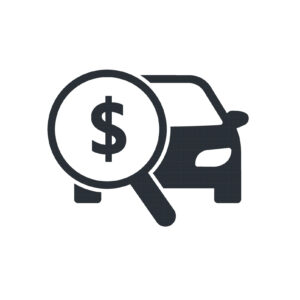 me when I took over the used vehicle department at our Cadillac store outside Chicago. “It’s the money, honey,” he told me.
me when I took over the used vehicle department at our Cadillac store outside Chicago. “It’s the money, honey,” he told me.
One would think that this understanding of the importance of each used vehicle’s unit cost’s influence on each vehicle’s profit potential would translate to a sort of cardinal rule. That is, it’s imperative that everyone gets each unit’s cost right, at the moment the vehicle is appraised and acquired. Maybe the rule would trigger some kind of consequence when someone gets it wrong.
But that’s not how it works in many dealerships today. Consider some of these findings from separate studies of vAuto dealers’ appraisal-related performance in the past year:
41 percent of dealers allow default reconditioning estimates on over 80 percent of the vehicles they appraise and take in. Nearly 70 percent of dealers allow default estimates on at least 50 percent of the vehicles they appraise and acquire.
80 percent of appraisals include reconditioning estimate misses that average $1,600. The misses can be due to over- or under-estimating the actual cost of getting a vehicle retail-ready.
70 percent of the vehicles dealers hold in their inventory see at least four adjustments to individual ACVs during a vehicle’s time in inventory. There are a multitude of reasons someone might adjust an ACV after they own the vehicle, but a prominent reason for the adjustments goes back to reconditioning—the accuracy of the initial estimate as well as the timing of when recon-related invoices (i.e., dent removal, glass/tire repair, etc.) and ROs hit the books.
Now, let’s go back to the age-old rule that you make your money when you buy a car. I’d submit that when a dealership appraises and brings in a vehicle, the initial unit cost likely shapes the collective sense of the vehicle’s profit and retail potential. The unit cost also likely plays a role in establishing the retail pricing strategy for the vehicle.
If that’s the case, what should one make of the data points above that suggest how you buy the car doesn’t really reflect the true cost of many vehicles you acquire?
To me, the findings suggest a glaring need for dealers to tackle an issue that many are likely aware of but haven’t addressed with the force and intention that they should—capturing a more accurate and thorough understanding of each vehicle’s condition, which can lead to a more accurate and true estimates of what it’ll take to make a vehicle retail-ready, should you choose to keep it.
I would also add that a greater level of unit cost accuracy is even more essential in today’s market than it has been in the past. Dealers everywhere are sensing, if not directly seeing, that used vehicle profitability is once again under pressure. I don’t think anyone would disagree that if you don’t have an accurate and clear understanding of a vehicle’s cost on Day 1, you’ll have a far more difficult time achieving the profit or return on investment potential a vehicle could command and you might reasonably expect it should command.
To borrow a line from singer Billy Joel, “get it right the first time, that’s the main thing.”
The post A Closer Look at Unit Cost Variability in Used Vehicles appeared first on Dale Pollak.
Why Retail Used Vehicle Prices Won’t Rise Like Wholesale Values 6 Sep 2024 12:45 PM (6 months ago)
Last week, I shared a post that outlined a somewhat odd moment in the used vehicle market, wherein wholesale values have risen steadily for the past two-plus  months while retail prices have declined. It’s an odd moment in the market because you’d normally expect to see retail prices follow the trendline of wholesale values in roughly similar fashion.
months while retail prices have declined. It’s an odd moment in the market because you’d normally expect to see retail prices follow the trendline of wholesale values in roughly similar fashion.
Since last week, though, we saw retail asking prices for used vehicles rise ever so slightly, to the tune of one-tenth of a percent. This rise begs a question: Does it mark the start of retail price appreciation?
The answer is a firm “maybe, but wait.”
On the “maybe”: The slight rise in retail prices could signal that dealers are now accounting for the rising wholesale costs they’ve been paying for vehicles, particularly for one to three-year-old units, where recent wholesale value appreciation has been steepest due to reduced supply and resilient retail demand. Such a dealer response is exactly what you’d expect.
On the “but wait”: Analysts or observers, including me, don’t think retail price appreciation, if it continues, will be as significant as the wholesale value appreciation we’ve recently seen. Why? The main reason is that the current new vehicle market is effectively keeping a lid on how high retail prices for used vehicles might go.
If we flash back to 2021 and 2022, when retail prices appreciated 30 percent to 40 percent overall, there weren’t many new vehicles available in the market. The absence of those vehicles buoyed new vehicle prices and effectively offered clear sailing for dealers to price used vehicles as high as they wanted.
Today, it’s a far different story in the new vehicle market. Incentives have been growing with days supply, and transaction prices have been on the decline for much of the year. These trends put downward pressure on retail asking prices for used vehicles.
Here’s how a Southeast dealer summed the situation: “While we are certainly seeing the rise on the wholesale side, I don’t think we will see an equal increase on the retail side. With new car inventory where it’s at, and OEMs increasing incentives each month, the pre-owned market will need to keep separation from the new car transaction number. Meaning, used car prices cannot rise at the same level because if they do, they’ll get too close to new car numbers and then no one buys used cars. Dealers know this, so we aren’t seeing the adjustment on the retail side. We are just seeing margin compression.”
The dealer went a step further. He used ProfitTime GPS to analyze recent pricing trends of roughly 50 random one-to-three-year-old vehicles of various brands in two states. His take: “The result was inconclusive. It was pretty evenly split, where some went up in recommended price while others went down. I really couldn’t even find a pattern like some brands went up while others went down.”
To me, the dealer’s findings and perspective affirm two take-aways:
The first take-away is that margin compression in used vehicles is back. The typical relationship between wholesale values and retail prices appears to be challenged by current conditions. Looking ahead, it’s reasonable to expect wholesale values, particularly on near-new vehicles, will continue to appreciate. In turn, retail prices may rise, but the increase won’t be as significant as historical trends suggest it could or should be.
The second take-away is that, as margin compression continues, it’ll be incumbent on dealers to have a clear understanding of how to properly acquire and price every used vehicle. As the dealer’s findings affirm, the movement of retail prices in today’s used vehicle market isn’t monolithic. Rather, it happens on a car-by-car basis. Therefore, if you’re not acquiring and pricing your used vehicles with a clear understanding of each unit’s unique profile of investment opportunity and risk, you’re far more likely to under- or over-price a vehicle, which leads to a sub-optimal ROI outcome.
The post Why Retail Used Vehicle Prices Won’t Rise Like Wholesale Values appeared first on Dale Pollak.
An End of the Month Gross Profit Reckoning in Used Vehicles? 30 Aug 2024 11:01 AM (7 months ago)
I have a suspicion that the month of August will look pretty good for dealers as far as used vehicle sales volume, but their month-end gross profit tally will likely be  less-than-satisfying if not distressing.
less-than-satisfying if not distressing.
My suspicion flows from dealer conversations in the past two weeks where the No. 1 topic of conversation was concern over declining front-end grosses. The concern struck me as similar to the moment when you’re not feeling quite right and you think a cold, or something worse, might be coming on.
This view squares with fresh Cox Automotive data on the current market:
Retail used vehicle sales have been strong over the past week or so. In fact, the weekly pace is the strongest it’s been since 2021, when everything was off the charts for dealers.
Wholesale values have appreciated over the course of the past eight weeks. The overall rise appears to owe to supply/demand dynamics in near-new vehicles. Cox Automotive data shows three-year-old vehicles have appreciated 2.4 percent; two- and four-year-old vehicles are up 1.6 percent. The explanation here is that buyers are likely looking to replace older-age vehicles with near-new used vehicles that are in short supply.
Wholesale conversion rates are running near 60 percent—about 10 percent higher than we historically see this time of year. The upshot: Dealers are buying auction vehicles to meet the brisk retail demand they’ve been seeing lately in their showrooms.
But here’s the part of the picture that doesn’t quite add up, and may well lead to a gross profit reckoning as dealers view their financial statements for August: Retail prices have been on the decline in recent months. With wholesale values on a sustained, two-month rise, we’d normally expect to see retail prices follow suit. Why? Well, as dealers pay more for vehicles, they tend to ask more. Right now, though, we haven’t seen retail price appreciation, which is a bit of a mystery.
The combination of all these factors suggests to me that August will look OK in terms of retail volume but not so good in terms of gross profit. In response, I suspect some dealers will likely take steps to offset the $500 and $600 declines in front-end gross averages they’ve been experiencing. In turn, we may well see a subsequent rise in retail pricing, or at least a plateau in the pace of retail price declines.
As I’ve shared this view of the current market with dealers, I’ve outlined two cautionary points that seem relevant to share here:
First, it’ll be incumbent on dealers and managers to closely track where the market’s moving. The current moment suggests a potential near-term opportunity to raise retail prices, especially on your best vehicles, which would be Platinum and Gold vehicles for ProfitTime GPS dealers.
Second, it’ll be critically important to lean on live market data to make pricing decisions. While the current market dynamics aren’t as dramatic as the sustained periods of wholesale value appreciation we saw in 2021 and 2022, they are similar. Back then, dealers who relied on and trusted the data science-driven pricing recommendations in ProfitTime GPS had a distinct advantage—the system automatically guided them to the proper pricing decisions for individual vehicles. Meanwhile, other dealers were still trying to figure out what to do.
The post An End of the Month Gross Profit Reckoning in Used Vehicles? appeared first on Dale Pollak.
An Empathy-based Approach for Customers with Negative Equity 22 Aug 2024 6:25 AM (7 months ago)
One of the most persistent topics of conversation with dealers of late has been the difficulty they experience working with customers who want to trade or sell 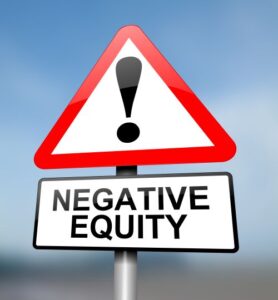 a vehicle that’s saddled with an out-size level of negative equity.
a vehicle that’s saddled with an out-size level of negative equity.
I’ll get to some pointers for dealers to best help customers find a way out of their current vehicle and situation in a moment. First, though, let’s take a quick look at Cox Automotive data that underscores why negative equity has become such a pain point for current vehicle owners:
- Customers who purchased a used vehicle in the first quarter of 2022 had a negative equity of $4,232 after 12 months. That figure compares to the pre-COVID average of roughly $2,900 in negative equity on used loans after the first year.
- Customers who purchased a used vehicle between the fourth quarter of 2021 and third quarter of 2022 now have an average negative equity that runs two to three times higher than the long-term average for the industry of $1,550 for loans after two years.
- Meanwhile, the share of new vehicle loans that include negative equity has risen to 39 percent from its long-term average of 33 percent. The current share of 39 percent has diminished by roughly 3 percent since the beginning of last year, likely due to lenders tightening their requirements. There’s a similar story for used vehicle loans—the current share of used loans with negative equity is 58 percent, which is below the long-term average of 63 percent. However, the share has grown by 2 percent since the beginning of last year.
The dollar averages here pale in comparison to some of the anecdotes that dealers share—the woman whose husband purchased a new $65,000 Mercedes for $80,000 two years ago, and had to pay off $17,000 in negative equity to sell the car when her husband passed away; the customer who paid $9,000 to resolve negative equity for a three-year-old Audi after the selling dealer refused to make an offer on the vehicle; the pick-up owner who couldn’t get out of their vehicle due to more than $20,000 in negative equity.
Best I can tell, the rise in negative equity owes to the combination of sky-high values for new and used vehicles between 2021 and 2023 that have since depreciated rapidly, the practice on the part of some dealers to sell new vehicles for significantly more than MSRP and lenders’ loan requirements, which allowed customers to purchase vehicles at elevated prices and roll over pre-existing negative equity into their new/used vehicle purchase.
But I would add that the negative equity for some dealers isn’t as dramatic, a difference that seemingly owes to their decision to not sell new vehicles over MSRP at a time when they could.
“We’re seeing negative equity, for sure,” says Adam Arens, dealer principal for a four-store group that includes Acura, Subaru and Nissan stores in Maine, Massachusetts and New Hampshire. “But as a brand and group, there’s probably less impact of the negative equity that we’re seeing across the industry.”
Arens is among dealers who decided not to sell new vehicles above MSRP or sell a new vehicle outside their primary market area unless it was for a previous customer. “I don’t know if it was the right thing to do, but it was the right thing for us,” Arens say. “The net result is we continue to do business with those customers. Our new car volume is somewhat dictated by availability and our used car volume continues to go up and set records. And our parts and service volume continue to set records.”
He adds: “We also had no employee turnover and continue to have no turnover. With downturn of gross, turnover’s pretty high in this business and we’ve been able to avoid that.”
During the NADA convention in 2022, I noted the decision Arens and other dealers made to not sell new vehicles above MSRP. At the time, they viewed the practice as a near-term opportunity that might seed longer-term harm for loyalty and satisfaction among their customers and employees.
Today, it seems like the concerns Arens and others shared in 2022 have arrived for the broader industry: Dealers are seeing customers who are often surprised, and less than happy, to learn how negative equity from a vehicle purchase decision a couple years ago means they can’t get out of their current car without paying a significant price.
I asked Arens and others for pointers on how to address the situation:
Show empathy. It’s important to take the time to hear a customer’s situation and story. After all, they came to you for help, often after they may have tried to sell the vehicle on their own. It doesn’t strike me as good business to refuse to at least make an offer on a customer’s vehicle, especially if you’re the one who sold the vehicle to them.
Educate but don’t point fingers. “We let them know we can maximize the value of the vehicle and take care of the other part of their problem,” Arens says. “However, there is a math equation that has to be done where they take responsibility. We outline their options. We also can track the trajectory of that car and let them know if it’s going in a positive or negative direction. The reality is almost everything is going negative, so waiting doesn’t solve the issue. In the end, you can’t point fingers. It doesn’t help.”
Arens uses vAuto data to show customers a 12-month valuation trendline for a vehicle in three-month segments. For almost every vehicle, the trendline shows vehicle values have and continue to head south. “Then, you can discuss how the ‘situation’ will not correct itself and offer to go over the options today,” he says. “Education has proven very good for relationship building.”
Give them your best offer on their current vehicle. vAuto Lead Performance Manager Dee Harris says it’s important for dealers working these deals to keep the focus on the customer’s current car and its value. Then, “only give them your highest number,” Harris advises. “Later, when their negative equity situation changes and they’re able to buy, what will they remember? Your trade allowance and how you treated them.”
The post An Empathy-based Approach for Customers with Negative Equity appeared first on Dale Pollak.
Pointers to Help You Play in Today’s Challenged CPO Market 15 Aug 2024 6:04 AM (7 months ago)
A recent report from Cox Automotive highlights a pain point many dealers will know all too well—if you want to stock one- to three-year-old vehicles, it’s almost impossible to acquire them without stepping up to a price point you may find uncomfortable.
The high cost of near-new vehicles owes to the drop in  new vehicle production and lease deals that largely occurred in 2020 and 2021. The report quotes Cox Automotive analyst Jeremy Robb outlining how these conditions are likely to persist:
new vehicle production and lease deals that largely occurred in 2020 and 2021. The report quotes Cox Automotive analyst Jeremy Robb outlining how these conditions are likely to persist:
“We are just beginning to see lower lease maturities for the key 3-year-old segment, and that impact will be felt over the rest of this year and into 2025 and 2026. As supply tightens for this key segment for the used vehicle market, we expect to see variances from historical average depreciation rates.”
Such market dynamics have contributed to an overall softening of certified pre-owned (CPO) sales by dealers for the past three months. The Cox Automotive report notes that while July’s CPO sales tally increased 1.4 percent compared to June, July’s total came in 6 percent less than total CPO sales in May, and 8.5 percent less than in July 2023.
In my conversations with dealers, some believe that the CPO programs they relied on in pre-pandemic years to attract near-new-minded buyers are a non-starter in the current environment. If you can’t acquire the vehicles for less than you expect to retail them, what’s the point?
It’s understandable that some dealers may prefer to sit on the sidelines, but the fact remains that while new vehicle affordability remains challenged for many buyers, the next-best alternative for many is a near-new vehicle that offers buyers the confidence and trust that many CPO programs offer. From my perspective, however, it seems that the reluctance on the part of some dealers to pursue CPO vehicles creates an opportunity for dealers who know how to source these vehicles and treat them once they arrive in inventory. Here are pointers to help on both fronts:
Mine your service drive for CPO-eligible units. Dealers who take service lane acquisition seriously report that a decent share of the vehicles they take in qualify for their factory CPO programs, even if they all don’t fall in the one-to-three-year-old sweet spot. Better still, service drive sourcing, if done right, can lead to CPO-eligible vehicles with a higher ROI potential than if you acquired them in the wholesale market. What’s the key to doing them right? It’s a blend of dedication and discipline, wherein your sales and service teams understand the important role that CPO vehicles play for the entire dealership. In addition, your service drive acquisition process and related payplans must minimize the friction points between the teams that have historically derailed many dealers’ efforts to acquire vehicles directly from their service customers.
Recognize the investment distress on Day 1. For many ProfitTime GPS dealers, the share of Bronze vehicles, or the units with the least ROI potential, runs close to 40 percent of their overall inventories. No surprise, a sizable share of the Bronze units are CPO vehicles, which dealers often paid up to acquire and recondition to make them CPO program-eligible. Top-performing dealers recognize the risk these vehicles hold and price them to move quickly on Day 1 to realize whatever gross or ROI potential they offer. A far larger share of dealers, however, subscribe to “hope,” wherein they price the vehicles to achieve the gross or ROI they expect, and end up retailing the vehicles for far less than they would have achieved if they’d been priced correctly on Day 1.
In the current CPO-challenged environment, it’s also important for dealers to remember why CPO sales played such an important role in your used vehicle departments in years past, when acquiring and selling CPO vehicles was much easier: Every CPO sale holds the potential to help you secure a satisfied customer, an F&I opportunity, additional gross in service for reconditioning and a trade-in, all of which seeds the ground for future business.
The post Pointers to Help You Play in Today’s Challenged CPO Market appeared first on Dale Pollak.
How “Variable Management” is Moving to New Vehicles 9 Aug 2024 7:11 AM (7 months ago)
Regular readers of my blog know I’ve embraced a “Variable Management” strategy for used vehicles and built a software system, ProfitTime GPS, to support the strategy.
The strategy itself flows from a data science discovery  that undercuts one of the central principles of traditional used vehicle inventory management—that each vehicle is fresh and full of potential on Day 1.
that undercuts one of the central principles of traditional used vehicle inventory management—that each vehicle is fresh and full of potential on Day 1.
However, we now know, thanks to data science and its ability to predict a used vehicle’s investment or ROI potential, that this principle isn’t true. In fact, each vehicle arrives in a dealer’s inventory with its own unique profile of risk and opportunity. Some are earners. Some are turners. Some fall in between.
I’ve been sharing this message with dealers across the country over the course of the past nearly two years. I’ll show them how ProfitTime GPS can help dealers know each used vehicle’s ROI potential on Day 1 and manage it accordingly. I’ll explain that the end game is to get dealers and used vehicle managers to operate more like prudent investment managers, wherein each asset, or used vehicle, gets treated with its own profile of risk and opportunity in mind.
To date, my message has focused on applying the Variable Management strategy and related principles to used vehicles. But now, with the advent of Vehicle Identification Number (VIN)-level incentives some OEMs are applying to new vehicles, it seems wise for dealers to at least consider how a Variable Management strategy should apply to their new vehicle inventory investments.
Historically, dealers have viewed new vehicles as commodities. Across different models, colors and trim lines, dealers have tended to treat new vehicles the same. Their mark-ups or discounts were often uniform across model lines and segments. The mark-ups or discounts would change as vehicles aged, or as OEMs offered broad-based national or regional incentives to help move model lines that were over-supplied on dealers’ lots.
Today, some OEMs are playing a slightly different game. Their VIN-specific incentives are targeted to move individual new vehicles that haven’t sold—a growing trend that fundamentally alters the risk and opportunity profile of one new vehicle compared to the next.
I recently spoke with a Midwest Ford dealer who’s extremely disciplined about moving new vehicles before their time in inventory creates floorplan expense. His concern: He’s effectively getting penalized when he sacrifices gross to move an aging unit while a competing dealer can sit on the exact same car and then receive the reward of a VIN-specific incentive to help move it out. “Some of those incentives definitely hurt us,” the dealer says.
To his credit, the Ford dealer understands that, despite the similarities of new vehicles in his inventory, each vehicle represents an investment of his money. Therefore, he accepts that it’s his responsibility to optimize the ROI on any particular unit before it ages away. He doesn’t plan to ease up on his discipline to turn each new vehicle in its own appropriate amount of time, which is a form of the Variable Management strategy I advocate that dealers adopt in used vehicles.
Looking ahead, I’m told that VIN-specific incentives are likely to increase in frequency and scope, especially as affordability concerns dampen retail sales of new vehicles and some OEMs keep sending more inventory to dealers than their market needs. That’s exactly why vAuto’s Conquest team has built new functionality to help dealers automatically apply VIN-specific incentives as they arrive.
But as the landscape of new vehicle incentives evolves, it’ll always be important for dealers to operate with the Variable Management-like mindset of the Midwest Ford dealer—ever-vigilant about each new vehicle’s individual profile of investment risk and opportunity and a desire to ensure each vehicle meets the your ROI objectives. That way, even if an incentive arrives too late because you already sold the vehicle, you’ll know made the most of your investment, and achieved your objective, while you owned it.
The post How “Variable Management” is Moving to New Vehicles appeared first on Dale Pollak.
ProfitTime GPS in Practice: ‘Start Small’ to Adopt ROI-Minded Used Vehicle Management 1 Aug 2024 7:51 AM (8 months ago)
Tim Hlavenka, national sales director for the Rick Case Auto Group, says the adoption of ProfitTime GPS and the ROI-minded Variable Management strategy it supports didn’t come easy or happen overnight.
“There was push-back in that roll-out,” says Hlavenka, who  oversees new and used vehicle sales for the group’s 12 stores in Florida and Georgia. “People don’t like change. They have to see it work. They have to see it’s useful.”
oversees new and used vehicle sales for the group’s 12 stores in Florida and Georgia. “People don’t like change. They have to see it work. They have to see it’s useful.”
The group started its transition to ProfitTime GPS and the system’s investment-minded strategy in 2023. Hlavenka joined the group in June that year and, by January of 2024, all Rick Case stores had the system in place. By then, Hlavenka’s work to make the transition to help store-level managers manage used vehicles as investments had begun to take hold.
His approach to build buy-in: Don’t drop the hammer, start small to build acceptance and trust in a gradual fashion.
“I picked one store where I knew they had the potential to sell more used vehicles,” Hlavenka says. “We kept a few cars that we would have wholesaled for retail. I told the manager, give it a try on five cars. Just do it on a few of them and do an A/B test. Price five vehicles and price them using ProfitTime’s recommended ranges and take five cars and do it your way. Then, look at the cars that did better. You know what we found? The data always wins.
“From there, the store started selling more cars and making more gross. Then, we started seeing stores slowly raise their hands and say, ‘I’m ready for ProfitTime.’”
Mid-way through 2024, Hlavenka and his team are glad they made the transition. The store’s year-over-year volume has gained momentum as the year unfolded. In January and February 2024 showed a 10 percent increase. It increased 35 percent in March, 25 percent in April, 30 percent in May and more than 40 percent in June.
“March, April and May were three record months of used cars sold and profitability for our organization,” Hlavenka says. “We’re seeing some really nice increases. And you know what? It hasn’t hurt our new car volume. As the stores see the results, they buy in more and more. It’s been really good.”
On the gross profit side, Hlavenka notes that overall profitability has also improved. “Our gross has gone up with the sheer increase in volume,” he explains. “Our PVR (Gross Profit per Vehicle Retailed) hasn’t gone up but it hasn’t gone down. It’s stabilized. I’m good with that. None of us gets paid on PVR. We get paid on a pool of gross at the end of the month. We’re focused on that.”
I share Hlavenka’s story because it matches the experiences I see at other dealerships and dealer groups as they make the transition to become more prudent managers of their used vehicle investments with ProfitTime GPS and the Variable Management strategy it supports.
It’s smart to start small to help individual used vehicle managers see how data science can challenge and complement their thinking and help their used vehicle businesses grow. The start small approach is especially useful when your inventory and retail sales suffer under the weight of too many aged or distressed vehicles. ProfitTime GPS will help you move those vehicles quickly as you clean up your inventory.
But the best part comes soon after as your managers, like Hlavenka’s, understand how to treat every vehicle according to its investment value, and your gross and volume start heading in the right direction.
The post ProfitTime GPS in Practice: ‘Start Small’ to Adopt ROI-Minded Used Vehicle Management appeared first on Dale Pollak.
A View of the Rising Cost of Trade-in Appraisal “Bumps” 26 Jul 2024 9:54 AM (8 months ago)
As I work with dealers, I’m seeing the return of a practice that largely went away in the past few years as dealers were hungry for new vehicle inventory and consumers  were willing to pay MSRP or more to purchase a new vehicle.
were willing to pay MSRP or more to purchase a new vehicle.
The practice is familiar to most, if not all, dealers: A customer wants to purchase a new vehicle that you really need to sell. Maybe you’re trying to meet a new vehicle sales volume objective or the vehicle’s been in your inventory far too long. The customer has a trade-in that, if you can make the deal, you know you could retail. The customer’s OK with the trade-in value you offered, but they want you to reduce the cost of the new vehicle by $750 to make the deal’s monthly payment work for them. In such scenarios, managers will often grant the $750 discount on the new vehicle and “bump” the trade-in appraisal by the same amount to satisfy the customer and move the new vehicle.
But here’s the rub: While the new vehicle department’s happy to make the deal and move the car, the used vehicle department is left holding the bag. The “bump” has now turned the vehicle into a less-profitable retail unit. If this situation occurs at a dealership using ProfitTime GPS, the bump may well degrade the vehicle’s investment value from Gold to Silver or Silver to Bronze.
One of the reasons bumps to trade-in appraisals occur owes to the fact that, in the minds of dealers and managers, the amount of the bump, which in this case is $750, may not seem like much. This belief may have been true in the past, but in today’s more margin-compressed market, any bump amount can rapidly degrade the profit or ROI potential a vehicle could achieve if the bump never happened.
I would add that the practice of bumping a trade-in appraisal amount isn’t just limited to new vehicle deals. It happens when a customer’s trading a vehicle to purchase a used vehicle, too. The difference, though, is that such used-for-used scenarios don’t pit new and used vehicle managers against each other.
Either way, the retail prospects of the used vehicle you just bumped and acquired only get worse from there. Why? Because the used vehicle manager doesn’t want to face the reality that the fresh trade they just acquired isn’t worth as much as it could have been. What do they do? Many managers will often price the used vehicle as if the bump never happened—that is, they’ll ignore the investment-degrading effects the bump created and price the vehicle as if they own it more right than they really do. Their decision reflects a belief that, if they give the now-distressed vehicle a chance to make gross, it just might happen.
But that’s not how the story typically goes. The reality is that when the manager prices the vehicle to get gross, they often price the vehicle too high. Then, the vehicle sits and doesn’t sell. In a few weeks’ time, the used vehicle department now has an even bigger problem on its hands—whatever gross profit or ROI potential the vehicle might have possessed has largely evaporated, and the department’s likely facing a low-gross or net loss on the unit when it sells.
I’m not suggesting that appraisal bumps are bad. However, I would suggest that dealers consider three things about this current practice:
First, I suspect customer requests for discounts on the new or used vehicles they purchase will grow in frequency and size as vehicle affordability continues to strain household budgets.
Second, I would encourage dealers to charge the cost of any bump against the gross of the new or used vehicle that gets the discount. This approach strikes me as a more honest accounting of the discounts.
Third, if the cost of the discount gets applied in the form of a bump on the trade-in, used vehicle managers should stop pretending that the bump didn’t happen as they price the vehicle. The fact is, the bump can turn your fresh trade into a more distressed and risk-prone investment. Therefore, it should be priced to move as quickly as possible to realize whatever gross or ROI potential it might hold.
The post A View of the Rising Cost of Trade-in Appraisal “Bumps” appeared first on Dale Pollak.
Three Reasons Automated Used Vehicle Pricing is a Bad Idea 25 May 2024 6:40 AM (10 months ago)
I’ve run into a consistent theme in recent conversations with dealers: What do you make of systems that automatically price used vehicles?
The question has also led to requests that we change  ProfitTime GPS from its current functionality of providing recommended price ranges for individual vehicles to automatically pricing each car. When I ask why someone would want to do that, the response boils down to this: “I want to take pricing out of the hands of our people.”
ProfitTime GPS from its current functionality of providing recommended price ranges for individual vehicles to automatically pricing each car. When I ask why someone would want to do that, the response boils down to this: “I want to take pricing out of the hands of our people.”
The frequency of the conversation topic, and the availability of automated pricing tools for dealers, spurred me to share three points to explain why I believe automated used vehicle pricing is, and probably will be for some time, an idea that sounds good in theory, but falls far too short in practice.
Point 1: If I were a dealer considering an automated used vehicle pricing system, I’d want to know exactly how it supports my primary objective of making more money, or net profit, in my used vehicle department. I’d also want to know how the system can adjust, in mid-month or even more frequently, as my goals to drive gross or volume change.
Through my experience with vAuto’s data science team to develop ProfitTime GPS, I’ve come to understand that the best place to drive net profit for the used vehicle department is to determine an ROI-based pricing strategy at the unit level. That’s because a) every vehicle’s investment value is unique; and b) pricing is the primary lever to pull or push to advance a dealer’s short-term objective to go for gross or volume.
To determine the most-optimal ROI-based pricing strategy for every vehicle, you must first know each vehicle’s risk/reward profile. Next, you need to calculate and calibrate a price for a vehicle that delivers the greatest probability of a sale that will achieve the highest ROI. From my familiarity with the data science and AI-based machine learning that powers ProfitTime GPS, I know it’s possible to crack the code of determining the specific factors, in proper weighting, that determine a used vehicle’s investment or ROI potential. But I’m not so sure any automated pricing system can adjust, on a car-by-car basis, when a dealer calls an audible and establishes an objective to drive gross or volume in a particular month, or even more frequently.
That’s why we built ProfitTime GPS to provide ROI-based recommended price ranges, rather than automated prices, for each vehicle. With ProfitTime GPS’ investment score and recommended pricing range, an individual can easily discern the earners and turners in an inventory and adjust prices on the vehicles that best support a dealer’s short-term gross or volume objective. In this way, ProfitTime GPS always serves a dealer’s primary objective to optimize the net profit or ROI for the department, by ensuring each vehicle bears a price that delivers the greatest probability of achieving the highest ROI.
Point 2: With an automated system, you’re pricing with your eyes closed. When dealers suggest they want to take pricing out of the hands of their people, I push back: “Our data’s not that good. Nobody’s data is that good.”
To explain, I highlight the myriad of circumstances that shape a vehicle’s value in the market and today’s technology and tools can’t readily see. You might have a vehicle with a clean CARFAX report and faded paint. You might have a vehicle with worn carpet or seats. You might have vehicle with dents and dings. You might have a vehicle with a tick in the engine, or a hitch in the transmission.
The take-away here is that today’s technology and tools can’t see everything that shapes a vehicle’s appeal, and value, to a potential buyer and the broader market. That’s why you should have a person in charge of pricing who’s got the requisite amount of experience and judgement to put proper eyes, ears and nose on every car. In the absence of human oversight, I question whether an automated system can properly price any vehicle. It seems like you’d be pricing vehicles with your eyes closed, blind to the subjective factors that influence a vehicle’s potential to sell in your market. To be sure, we may see a day when a computer-based system, armed with all the AI-powered technology available, can accurately and properly put “eyes” on a vehicle. But my sense is we’re not there yet.
Point 3: Automated pricing systems remove accountability. The whole point of having an individual in charge of used vehicles and their pricing is to ensure someone’s ultimately accountable and responsible for the outcomes of the used vehicle department. If you’ve got a system automatically pricing your vehicles, you run the risk of ending up in a situation like this:
Dealer: “Hey Joe, our used vehicle gross and volume are way off this month and even worse than last month. Plus, we’ve got a ton of aged cars. What are you doing?”
Used vehicle manager Joe: “Sorry, Boss. Don’t look at me. I didn’t make those decisions.”
As a general rule, dealers don’t like it when they feel the need to hold someone accountable and can’t rightly do it. If such situations occur, you can bet dealers will put the blame for the poor outcomes on the automated pricing system and the vendor who provides it.
I’d add a final observation that’s relevant to this discussion: AI-powered systems and tools are becoming more and more prevalent. Such is the nature of our technology-driven society. But if you look at aviation, finance, healthcare, shipping and other industries where AI tools now drive daily workflows, they all share a common characteristic—there’s usually a person keeping an eye on the AI.
The post Three Reasons Automated Used Vehicle Pricing is a Bad Idea appeared first on Dale Pollak.
Are Your Used Vehicle Prices Right for the Current Market? 3 May 2024 11:08 AM (11 months ago)
With April in the books, I thought I’d take a moment to highlight a feature of the current used vehicle market that, judging from recent conversations with dealers, appears to have been misread or overlooked entirely.
I’m talking about the steady decline in used vehicle  retail prices since the beginning of the year. In this week’s Cox Automotive Auto Market Report, Chief Economist Jonathan Smoke spells out the situation: Since January, retail prices for used vehicles have declined 5.9 percent. By comparison, during the first four months of 2019, retail prices for used vehicles declined 0.1 percent. Smoke also notes that the pace of depreciation in the wholesale market is a click or two higher than normal.
retail prices since the beginning of the year. In this week’s Cox Automotive Auto Market Report, Chief Economist Jonathan Smoke spells out the situation: Since January, retail prices for used vehicles have declined 5.9 percent. By comparison, during the first four months of 2019, retail prices for used vehicles declined 0.1 percent. Smoke also notes that the pace of depreciation in the wholesale market is a click or two higher than normal.
Such a sustained stretch of retail price softening hasn’t happened in quite a while. We saw some retail price declines last year, but we also hit stretches where they were on the rise following an increase in demand, which was often segment specific.
Despite the retail price softening, I often see little or no sense of urgency on the part of dealers to make sure their retail asking prices are in line with the market. Across the country, many dealers are carrying vehicles that are priced not to sell. They’re making their monthly numbers by cheap-selling the fresh stuff that isn’t aged or investment-distressed—a sub-optimal sacrifice of gross for the sake of volume.
My guidance to dealers in this current moment has three parts:
Reckon with the painful cars. Dealers are currently carrying an average 45 days supply of used vehicles. By definition, such dealers are stocked to carry cars from one month to the next. When the cars celebrate their first or second monthly birthday, it’s a sure bet the vehicles represent retail pain when they sell. So what’s the point of holding on to them? They’ll only get worse over time, which means it’s time face the pain and stop kicking it down the road.
Be realistic about each vehicle’s potential on Day 1. This step is much easier for ProfitTime GPS dealers. Why? Because the system scores every vehicle’s investment potential on Day 1. The system also serves up retail pricing recommendations to connect the vehicle to a retail price point that’s market-honest and -realistic and attuned to the vehicle’s investment value. The challenge for every dealer, though, is what you do when know you’ve got a troubled car on Day 1. If you simply can’t resist the urge to “give the car a shot,” keep your “shot” as short as possible.
Exercise daily pricing discipline. Market conditions are always on the move. I suspect Smoke would agree that, comparatively speaking, market conditions also move faster, and in more surprising ways, now more than ever. The upshot: If you’re not assessing each vehicle’s pricing position at least once a day, you’re moving too slow, and your cars probably are, too.
As a closing note, I’d add that I didn’t hear anything in Smoke’s report that suggests the current market dynamics will shift course any time soon. That’s not surprising to me, since everything we’ve seen in 2024 so far suggests wholesale and retail market efficiency is back in full force and dealers’ used vehicle gross profits, if not sales volumes, show it.
The post Are Your Used Vehicle Prices Right for the Current Market? appeared first on Dale Pollak.
Rethinking the “Right”-ness of Your Used Vehicle Inventory 9 Apr 2024 12:48 PM (11 months ago)
Over the past several weeks, it’s become clear to me that many dealers need to think more deeply about the composition of their used vehicle inventories. By composition, I mean the right number and mix of vehicles.
This realization follows multiple conversations with  dealers in recent weeks—all of whom, at roughly the mid-point of last month—realized that their pace of used vehicle sales was lagging. It’s worth noting that all the dealers made their monthly volume targets for March, but the way they achieved this outcome leaves much to be desired.
dealers in recent weeks—all of whom, at roughly the mid-point of last month—realized that their pace of used vehicle sales was lagging. It’s worth noting that all the dealers made their monthly volume targets for March, but the way they achieved this outcome leaves much to be desired.
Generally speaking, the dealers fell into three groups:
They were short on cars. I worked with a Toyota store where, after an analysis of their sales pace and stocking strategy, the inventory was off by 25 cars. The manager knew the score, but he lacked the time and ability to find vehicles and right-size his inventory. To make the volume target, the manager reduced asking prices on in-stock units. Sure enough, VDPs picked up. Traffic increased. Deals got done. But, in reaching the volume target, the manager unquestionably gave up gross.
They had too many cars. This scenario can seem like a head-scratcher—wait, the dealer had too many cars and couldn’t meet their volume objective? Well, the answer is often yes. If you unpack this situation, you’ll inevitably find that, due to carrying too many units, an ever-larger share of a dealer’s inventory will be aged or distressed; cars ProfitTime GPS dealers recognize as “Bronze” vehicles. Inevitably, nearly all of these vehicles aren’t priced to sell. Rather, they’re priced for a customer who might come along and over-pay, thereby helping the used vehicle department avoid a significant loss. In such cases, it’s almost a foregone conclusion that you’ll see managers marking down the best cars (usually the ones with the lowest Market Days Supply and least time in inventory) to reach the volume target. The net effect is the department’s unnecessarily giving up gross.
They have the wrong cars. Often, the cars that may be wrong today weren’t necessarily wrong in the recent past. The issue, as I found with a dealer last week, is often that no one’s proactively comparing the used vehicle department’s sales to the local market. After this analysis, the dealer’s used vehicle team understood that they were effectively over-stocked in larger, higher-priced SUVs and trucks than they should be, and they were cutting prices to move them. They also understood that, with a more consistently market-aligned inventory mix, they’d be more likely to meet their monthly sales target and keep the gross they’ve been giving up.
To reiterate, the common threads in these scenarios is that a dealer’s inventory isn’t as “right”-sized as it should be. That is, they don’t have the right number and mix of vehicles and, when this happens, bad things tend to follow, resulting in lost gross or volume.
I would add that the latest enhancement to ProfitTime GPS, Global Search, helps solve these recurring problems. It starts with establishing/retuning your stocking strategy to know how the number and mix of cars to stock at any given moment. It helps you craft a purchasing strategy to acquire vehicles more consistently with the investment potential you believe they should offer. And, it feeds you the vehicles, across all sourcing channels, that fit your established strategic parameters.
Yes, Global Search requires a bit of up-front time to set up your future success. But, judging from the gross profit that’s effectively leaking out of used vehicle departments every month because the inventory isn’t really “right,” the time seems well-worth its investment.
The post Rethinking the “Right”-ness of Your Used Vehicle Inventory appeared first on Dale Pollak.
A Quick Clarifier on How To Think About “Bronze” Vehicles 15 Mar 2024 11:29 AM (last year)
I appreciated a dealership GM’s comment the other day that he views Bronze vehicles as the equivalent of vanilla ice cream. That is, like vanilla ice cream, Bronze  cars are common, available from any dealer, just as vanilla ice cream’s available at any reputable ice cream shop.
cars are common, available from any dealer, just as vanilla ice cream’s available at any reputable ice cream shop.
But as I noted to the GM, the comparison between vanilla ice cream and Bronze vehicles only tells part of the story. It’s not necessarily reflective of the reasons a vehicle receives a Bronze designation in ProfitTime GPS.
A quick refresher: Like all the precious metal categories in ProfitTime GPS, the Bronze designation reflects a vehicle’s investment potential. This potential is shaped in part by the overall supply of a vehicle in a local market. If a vehicle’s got a high Market Days Supply, which indicates there are plenty of them out there in the market, it could be a Bronze vehicle.
But the availability of a vehicle in a market, or its Market Days Supply, is only one factor that determines a vehicle’s investment potential. To calculate a vehicle’s investment potential, ProfitTime GPS system weighs a vehicle’s Market Days Supply, Cost to Market and retail sales volume, along with a host of other factors.
Therefore, you could have a high Market Days Supply vehicle that, because you own it really right and it’s a fast-mover in the market, earns a Platinum or Gold designation, indicating a higher investment return potential. On the flip side, you could also have a low Market Days Supply vehicle that’s a fast-mover that you own for too much money, making it Bronze, despite the fact that it’s a high-demand, low-supply unit.
To reiterate, a vehicle’s investment potential isn’t solely driven by the fact that it’s effectively available at any dealership in your market. This distinction isn’t lost on dealers and managers who regard their vehicles as investments rather than viewing them as merchandise.
To his credit, the GM fully understands that handling or treating Bronze vehicles, once you own them, is somewhat like eating ice cream—the faster you move them, the less likely you’ll experience the dissatisfaction of seeing your profit potential melt away.
The post A Quick Clarifier on How To Think About “Bronze” Vehicles appeared first on Dale Pollak.
A Tale of Troubled Used Vehicle Department Performance and a Fix 11 Mar 2024 10:07 AM (last year)
I received the following note from a dealership manager that I thought I’d share:
I have a GM and a used car manager who are stuck in 1980 or Covid, take your pick. We are inverted in ProfitTime GPS. We continue to purchase an d sometimes appraise at high Cost to Market, intentionally assuming that someone will show up and pay the price. When they don’t, we start cutting the price. We either get lucky and sell the vehicle prior to all the reconditioning being assigned to the vehicle or, in many cases, it ages. Once it ages sufficiently to be a distraction, maybe 200 days, they will get aggressive about getting closer to the market and take the loss. They aren’t overly concerned about losses long term because they are covered by the grosses produced by new car sales and F&I. Predictably the used department is losing about $350,000 annually.
d sometimes appraise at high Cost to Market, intentionally assuming that someone will show up and pay the price. When they don’t, we start cutting the price. We either get lucky and sell the vehicle prior to all the reconditioning being assigned to the vehicle or, in many cases, it ages. Once it ages sufficiently to be a distraction, maybe 200 days, they will get aggressive about getting closer to the market and take the loss. They aren’t overly concerned about losses long term because they are covered by the grosses produced by new car sales and F&I. Predictably the used department is losing about $350,000 annually.
The error, according to the GM, is that we are not selling the vehicles fast enough. I suggest it’s not likely that vehicles will sell faster since no one will see the vehicle. It’s essentially hidden in the market due to their high market days supply and prices. Any search for these low ROI units is going to put them on page twenty and they won’t be seen. Nothing will persuade them to consider the Market Days Supply when initially pricing the inventory, or when acquiring inventory. And yes, they are all coming from the auction.
I suspect this sounds familiar to many dealers because I see varying shades of this situation in dealer inventories every day. I have great empathy for dealers in this situation because it’s their money, their investment in used vehicles and yet, the sub-optimal performance continues day after day, week after week, and year after year.
In this example, the manager’s well aware that changing the mindset of the dealership’s used vehicle management team won’t be easy. Why? Because they are stuck in the past, believing that every fresh car, no matter how right or wrong you own it, deserves a shot. They believe the calendar, or days in inventory, is the primary metric on which they judge a vehicle’s retail potential. They also don’t appear to understand, as the dealer rightly points out, that the cycle of marking up and holding onto cars until they’re discounted to meet the market is a sign of a highly efficient and transparent retail market. They don’t seem to get that today’s customers know better. There aren’t that many buyers out there anymore who you can convince to pay more than they should, especially if it’s a vehicle with high Market Days Supply.
The way I see it, the dealership’s used vehicle management team probably views themselves as astute “car guys” who know their market and their customers very well. I suspect they also probably regard themselves as individual success stories.
But here’s a fundamental reality of today’s market they consistently miss: That is, the rise of the Internet, and the increased market efficiency and transparency it has created, require more than traditional “car guy” skills to drive success today. We are now fully back into an environment where used vehicles are depreciating assets and achieving a positive outcome with every vehicle requires operating with more than a mere belief that you know what you’re doing.
Ultimately, today’s retail and wholesale market efficiency require a different mindset and skill set from the individuals who manage used vehicles. Yes, they need all the “car guy” smarts they’ve developed and honed over the years. But even more important, they need to develop their skills as prudent managers of investments.
Once they do, they’ll recognize that a troubled vehicle on Day 1, a unit that has a high Cost to Market, high Market Days Supply and low retail sales volume, is nothing more than a troubled investment on Day 1. They need to ask themselves what a prudent investor would do with an investment that screams “RISK!” from the moment they own it. The proper response, as we all know, is to get out of the investment as quickly as possible and deploy the capital to a more productive asset.
Given the ubiquity of the situation the dealer shared with me, it seems wise for everyone who’s got a stake in the outcome of a used vehicle department to take a moment and reflect on the following questions: Am I here to move metal or am I here to make money? Am I managing cars or capital? Am I a “car guy” with zero investment aptitude or a “car guy” who behaves, believes and thinks like a prudent investor?
If you’re honest about answering the questions, you’ll have the seeds to set the stage for a transformation of your used vehicle department that helps eliminate the annual losses and less-than-optimal outcomes many currently accept.
The post A Tale of Troubled Used Vehicle Department Performance and a Fix appeared first on Dale Pollak.
A Little “Say You, Say Me” in Used Vehicles 1 Mar 2024 9:12 AM (last year)
A couple days ago I was riding in a car on my way to a dealer meeting when Lionel Richie’s song, “Say You, Say Me,” came on the radio. The tune brought me back to the mid-‘80s when it was all over the airwaves. It also made me think of recent conversations I’ve been  having with dealers and used vehicle managers and the common topics we cover:
having with dealers and used vehicle managers and the common topics we cover:
Say You: We’ve got way too many Bronze cars in our inventory.
Say Me: Yes, the Bronze designations vAuto’s ProfitTime GPS assigns to these vehicles signal that they are distressed investments. But there’s nothing wrong with a Bronze vehicle. Some of them are really nice cars. Your problem appears to be how you’re treating them. They should be priced to move quickly, enabling you to turn the distressed investment into a retail sale that allows you to capture some front-end gross, F&I sales, a customer and possibly a trade-in with a more favorable investment profile. The share of Bronze vehicles in a dealer’s inventory can also signal an opportunity to improve how and where you’re acquiring inventory. If you’re leaning heavily on auctions, your share of Bronze vehicles will be higher than a dealer who’s less reliant on this sourcing channel. Likewise, it’s worth examining whether appraisers and buyers are putting too much into inventory acquisitions without a good reason (i.e., they needed to make a deal or you really needed the vehicle).
Say You: If we want to sell 100 units a month, we need 150 in inventory.
Say Me: We are fully back into a market where depreciation has returned in full force. If you’re consistently stocking more than your rolling 30-day total of retail sales, you’ll always be fighting an aging problem as the 50 vehicles you don’t sell in a given month roll into the next. This dynamic is especially true when the carry-over vehicles are lower tier investments (units ProfitTime GPS identifies as Bronze and Silver) and you’re pricing them too proudly—which means they won’t sell unless/until you price them more realistically for the market.
Say You: We knew we over-paid for this vehicle when we acquired it. But we wanted to give it a shot. Now it’s 55 days old. I now see we should have priced it to move sooner.
Say Me: Good on you for recognizing the problem with this car. The faster you fix it, the faster the headache and heartache goes away. I would point out, though, that the idea of giving a vehicle a “shot,” especially when you know you over-paid for it, effectively means you’re kicking the can down the road. We now know that more than 50 percent of vehicles in dealer inventories begin their first day of life as Silver/Bronze vehicles. Such vehicles don’t deserve the “shot” your instinct and training suggests they should get. In the current market where depreciation has returned, these vehicles absolutely will not get better over time.
Say You: We have a firm, 60-day age (or turn) policy.
Say Me: By definition, an age or turn policy recognizes the need for dealers to retail vehicles before depreciation saps away their ROI potential. But it’s even more important to understand that, as we now know through the data science behind ProfitTime GPS, vehicles do not depreciate at the same rate. That is, some are more sensitive, and some are less sensitive, to the passing of time. The problem is that a standard 45-, 60- or even 90-day age policy does not reflect the variable nature of vehicle investments. I’d encourage you to move toward a variable turn policy, where you’re managing each vehicle’s days to sell in accord with its unique investment value. In ProfitTime GPS, this tends to manifest in the following manner: Platinum vehicles turn in roughly 50 days; Gold vehicles in 40 days; Silver vehicles in 30 days and Bronze vehicles in 20 days. This variable approach helps you manage the varying levels of risk and opportunity that exist across individual vehicles and a dealer’s overall inventory.
These are just some of the recurring themes from recent conversations. In sum, they point to a need for dealers to consider how they’re managing their inventories in the current market to deliver the most optimal returns on individual used vehicle investments.
The post A Little “Say You, Say Me” in Used Vehicles appeared first on Dale Pollak.
An Emerging Opportunity for Used EVs? 9 Feb 2024 1:01 PM (last year)
This week, Cox Automotive analysts shared news that may surprise some dealers: Retail sales of used EVs rose sharply in January, an uptick that could  owe to the ability of used EV buyers to apply a $4,000 federal tax credit at the point of sale.
owe to the ability of used EV buyers to apply a $4,000 federal tax credit at the point of sale.
The data:
Average weekly sales of used EVs in January grew 34 percent against the average weekly sales in December 2023.
January’s sales represented a 69 percent increase compared to used EV sales in January 2023.
Thanks to the January sales increase, the days supply of used EVs dipped below 47 days; it averaged nearly 64 days in the fourth quarter of 2023.
The current days supply of used EVs is now lower than the average days supply of internal combustion engine (ICE) vehicles.
The recent surge in used EV sales contrasts with the wariness I heard from dealers at NADA about stocking and selling used EVs. Like consumers, dealers are concerned about value volatility and battery health, among other issues.
Analysts offered a few reasons for the recent rise of used EV sales:
First, January marked the first time used EV buyers could apply a $4,000 federal tax credit at the point of purchase of a used EV. Previously, used EV buyers could claim the credit as they filed their taxes.
Second, the value of used EVs, which suffered last year as OEMs reduced MSRPs on new EVs, might be more within reach of interested buyers, particularly if the buyers and their vehicle of choice qualifies for the $4,000 tax credit.
Third, the average tax refund this year is expected to be $3,000, about $300 higher than last year. Some used EV buyers may be using, or at least considering, their refunds as they buy the vehicles.
Overall, the recent rise of used EV sales represents good news for dealers. As more sales of used EVs occur, dealers can wade deeper into this market with more confidence, since more retail sales brings deeper and more reliable market data to make better used EV decisions.
But I’d also offer a note of caution to dealers who might view January’s spike in used EV sales and the $4,000 tax credit as reasons to start stocking used EVs. Here’s why: The federal program limits the tax credit to EVs (and hybrids) priced at $25,000 and below. On top of that, the tax credit is tied to household income. For example, you wouldn’t be eligible to receive the credit if you’re married, file jointly and make more than $150,000 a year. Such requirements make it difficult if not impossible for dealers to acquire a used EV that qualifies for the program without knowing they’ve got an income-eligible customer ready to buy it.
Still, the January sales numbers suggest the used EV market is on the move and will merit closer attention in the coming months.
The post An Emerging Opportunity for Used EVs? appeared first on Dale Pollak.
ProfitTime GPS and Global Search: A ‘Guardian Angel’ as You Acquire Inventory 7 Feb 2024 12:43 PM (last year)
While many dealers have been working hard to diversify how they source used vehicle inventory and rely less on auctions, the role of auctions as an inventory-feeder remains necessary.
But one of the more challenging aspects of acquiring  auction vehicles in the current environment, where overall supplies of inventory have improved, is finding the “right” cars that fit your acquisition strategy and offer your desired money- or ROI-making potential.
auction vehicles in the current environment, where overall supplies of inventory have improved, is finding the “right” cars that fit your acquisition strategy and offer your desired money- or ROI-making potential.
“ProfitTime GPS seems to know when the writing’s on the wall. What I mean is that it’ll stop you from making a bad purchase, way before it happens,” says the used vehicle manager for a three-store group in California.
I asked for a recent example, and the manager shared this: Recently, he was looking at an auction vehicle through ProfitTime GPS’ new Global Search tool. The system recommended a purchase price so far below the current Manheim Market Report value that “it was baffling.” The manager chose to trust the finding and passed on the car. A week later, “there was a thousand of those cars at the auction and MMR isn’t what it used to be. ProfitTime GPS is like a guardian angel.”
The manager’s story resonated because it underscores a fast-emerging reality for dealers and their used vehicle managers. That is, your competitive advantage today rests not only on your experience, instinct and judgement; it’s also tied to your ability and interest in using available data and tools to make better decisions faster.
For example, the manager shared how ProfitTime GPS’ Global Search tool, which serves up active vehicle listings from auctions, private party listings, your service drive and other sourcing channels, has helped him cut almost 70 percent of the time he spends looking for wholesale inventory:
“Before I was looking through a mountain of cars to find one that’s worth buying,” the manager says. “With Global Search, I now have a smaller list that’s typically worth looking at. Where I used to spend six hours grinding through 600 cars and maybe winning five of them, I’m spending only a couple hours and I’m buying a lot more.”
The manager shared that, with the help of Global Search, his auction-purchased vehicles average a score of six in ProfitTime GPS’ scoring system, ranking them as Silver vehicles. The achievement contrasts starkly with other dealers who typically bring in auction vehicles as Bronze, with investment scores ranging from one to three.
Perhaps the best part of the manager’s story is how he intends to invest the time he’s gained back by using Global Search to aid his acquisition efforts. “We’re going to diversify our inventory acquisition channels and try to make a win out of our service drive. This auction thing isn’t going to be my golden goose forever.”
The post ProfitTime GPS and Global Search: A ‘Guardian Angel’ as You Acquire Inventory appeared first on Dale Pollak.
NADA Day 3: A Focus on Operational Consistency, Compliance and Customer Acquisition 4 Feb 2024 12:37 PM (last year)
You could see the evidence of last year’s busy pace of the dealership consolidation on the show floor at NADA. A fair share of my dealer conversations today focused on how dealers plan to optimize their investments in additional rooftops for their groups.
“We’re re-doing the service department at one of our stores and  building another from the ground up,” the operations director for a nine-store group in the Southeast shared. “You name it, we need it. We’ll probably spend $850,000 today.”
building another from the ground up,” the operations director for a nine-store group in the Southeast shared. “You name it, we need it. We’ll probably spend $850,000 today.”
Another dealer shared that he was looking to invest in a new CRM system to drive more operational consistency across his four-store group in the Northwest. “We want everyone working from the same playbook,” he explained. “We used to behave like a group of dealerships. Our goal is to behave as a dealer group.”
As a vendor partner for dealers, I also appreciated how a COO viewed the investments he intended to make for his group: “I need to see a 7-x ROI. It’s not enough for a vendor to tell me their solution will ‘pay for itself.’ That means they’re making the money, not me.”
Here are a few other take-aways from the floor:
Regulatory compliance: Several dealers mentioned concerns about how and where Federal Trade Commission regulations might land. The perspectives varied from “we’re taking a wait and see approach” to a belief that proposed customer record-keeping requirements represented a bit of “overreach” on the part of regulators.
Customer acquisition: I liked how a dealer described their approach to used vehicle inventory acquisition: “We’re focused on acquiring the customer, not just the car,” he said. The mindset means they’ll acquire every vehicle they can, even if they have no intention of retailing it. “A customer who only sells us their vehicle today might buy from us tomorrow if they like the experience.”
Margin compression: I heard more dealers talk about finding their optimal balance between turn and gross, which vAuto’s ProfitTime GPS and Variable Management strategy helps them achieve. “Profits aren’t collapsing, they’re normalizing,” a New York dealer said. “We have no interest in going back to 2019 when we were all cutting each other’s throats as we worked to move more cars.”
This year’s NADA marks the 55th time I’ve been to the convention. A dealer asked if I still get excited about being here. The answer is an unequivocal “Yes!” The energy I get from reconnecting with dealers and being on the show floor knows no equal.
As I head home, I feel a deep sense of gratitude and kinship for everyone who visited the vAuto booth and entrusts us with your business. Thank you all, and safe travels home.
The post NADA Day 3: A Focus on Operational Consistency, Compliance and Customer Acquisition appeared first on Dale Pollak.
NADA Day 2: AI Everywhere and Some Familiar Challenges 3 Feb 2024 5:27 AM (last year)
When I asked dealers what new solutions they might be looking for here at NADA, “AI” and “ChatGPT” were frequent responses. Like the rest of the world, AI is on the rise and on the minds of many.
Perhaps the most intriguing take came from a dealer who  believes that AI, over time, will empower his people to make better decisions and likely lead to operating with fewer people in positions where AI can do the rote tasks individuals now perform. But the dealer shared that the AI-related he’s most interested in seeing did not appear available among the many vendors offering AI solutions here.
believes that AI, over time, will empower his people to make better decisions and likely lead to operating with fewer people in positions where AI can do the rote tasks individuals now perform. But the dealer shared that the AI-related he’s most interested in seeing did not appear available among the many vendors offering AI solutions here.
“I’d like to see AI tell me what vehicles will sell in two or three weeks to help my stocking strategy,” the dealer says.
The dealer’s thinking lands squarely in the four-tier framework that Cox Automotive’s chief data officer Ben Flusberg shared in our Thursday panel session at the National Auto Auction Association meeting. The breakdown:
Insights: This is where AI and machine learning can look at past data/events and provide insights on what occurred.
Predictions: This is where AI-driven tools use algorithms to predict specific outcomes, such as risk or opportunity related to the pricing or sale of a vehicle in the future.
Recommendations: Here, AI solutions recommend a particular course of action. This is the type of AI/machine learning the ProfitTime GPS performs as offers pricing and appraising recommendations on specific vehicles.
Automated decisioning: This is where an AI solution acts on the recommendation by itself, with some human oversight.
It seems to me that the automotive industry has and will continue to operate in the “predictions” and “recommendation” tiers for some time. This experience will then shape the types of automated AI-driven decisioning that take hold in dealerships and related businesses.
Here are a few other take-aways from the floor:
Profitability: Dealers are keenly aware that the new and used vehicle markets are normalizing. They see it in their financials, and the diminished front-end grosses they realize on retail sales. Not surprisingly, the dealers who complain about this inevitable shift—ours is a cyclical business, after all—in used vehicles tend to suffer from operational practices that worked pretty well in the past two or three years but work less well today. These include stocking more used vehicles than you sell in a given month, relying on the calendar to make pricing decisions and giving every vehicle the same “shot” or time in inventory to sell.
Packs: I did an informal poll of Performance Managers here at NADA. They generally agree that many dealers increased their packs on used vehicles in the past two to three years as gross profits soared. Today, the average pack seems to be around $1000, and “more dealers have been willing to go even higher.” I’ve long regarded packs as an effective tax that slows retail sales and can cause consternation among sales teams. My sense is that dealers who raised their packs would be wise to right-size them for the current market and the investment value of individual vehicles.
EVs: Almost every dealer I talked to remains wary of EVs. It’s not that they don’t recognize EVs represent the future. Rather, they understand consumer demand and related charging infrastructure isn’t as well developed as it needs to be for wide-scale adoption. It’s also clear to me that while there’s an awful lot of work underway to understand how to properly value a used EV, uncertainty abounds. It’s important that dealers and used vehicle managers recognize that the age and mileage of an EV don’t correlate to a valuation in the way they do with internal combustion vehicles. EV batteries degrade over time, even if you don’t drive the vehicle all that much. Hence, a five-year-old EV with 20,000 miles might not be worth as much as two-year-old EV with higher mileage. Still, I’d have to agree with the overall assessment that EV batteries, as a whole, are holding up better than almost everyone expected.
It’s been a long, productive day at NADA. I’m looking forward to what Day 3 will bring and I’ll share it here.
The post NADA Day 2: AI Everywhere and Some Familiar Challenges appeared first on Dale Pollak.
NADA Day 1: A Well-Kept Secret and a Nice Surprise 2 Feb 2024 6:10 AM (last year)
It seemed odd that colleagues from the earliest days of vAuto were on hand for my participation in a National Auto Auction Association panel discussion  on the impact of artificial intelligence in our business.
on the impact of artificial intelligence in our business.
Mandi Fang. Tracy Fred. David Rice. Chris Stutsman.
Each person was part of the team that helped me build vAuto. Each has seen their individual career grow with Cox Automotive. They’re all in Las Vegas for the NADA convention. It wasn’t entirely clear why they came to the panel—I figured they might want to hear what Cox Automotive’s chief data officer, Ben Flusberg, and I had to say about how AI is reshaping the retail and wholesale markets.
It wasn’t until we’d finished the discussion, and the emcee asked Ben and me to stay on stage, that I understood why some of the vAuto OGs had shown up. They had a secret. They knew I would be receiving a Warren Jones Fellow Award to recognize my contributions to the industry.
The award was a sweet, pleasant surprise. I had no idea it was coming.
The award itself holds special meaning. Before he became a dealer, my Dad owned the Dyer (Ind.) Auto Auction. I have fond memories of hanging out there while my Dad was working, playing around the cars and sometimes getting into trouble. In some ways, the award marks a full circle for the Pollak family.
My sincere thanks to NAAA for the honor and recognition, and their desire to keep the award presentation a secret until it happened. I must also thank my vAuto and Cox Automotive colleagues for being part of the surprise and taking time to show their love. Nice work, y’all.
All in all, the NAAA event offered a memorable start to this year’s NADA. It’s the kind of experience that only NADA can provide. Tomorrow marks the official opening of the NADA exhibit hall and a full day spent with dealers. I can’t wait.
The post NADA Day 1: A Well-Kept Secret and a Nice Surprise appeared first on Dale Pollak.
How Will NADA 2024 Drive the Future of Your Business? 26 Jan 2024 8:57 AM (last year)
It’s fitting that the theme for next week’s NADA 2024 convention in Las Vegas is “Driving the Future.”
The theme is especially appropriate given recent news that  Vroom will effectively exit the used vehicle business. The company’s announcement this week adds Vroom to what seems to be a growing list of technology-focused companies, including Shift and Carlotz, that positioned themselves as disruptors who represented the future of the car business.
Vroom will effectively exit the used vehicle business. The company’s announcement this week adds Vroom to what seems to be a growing list of technology-focused companies, including Shift and Carlotz, that positioned themselves as disruptors who represented the future of the car business.
And yet, there they are, and here we are. They won’t be going to NADA this year. For all intents and purposes, that means the future of the car business belongs to dealers who recognize something that apparently eluded the tech company executives and the investors. That is, you can’t and won’t find sustained success in the car business if you ignore the long-standing fundamentals that are necessary to achieve it.
For years, dealers and I have marveled at how the valuations for the disrupters continued to climb, even though it certainly seemed like they were stocking too much inventory and didn’t appear to be pricing every vehicle rationally every day. I remember how the rise of companies like Carvana, which has fared better than its peers but faces its own operational challenges, caused some to question whether CarMax was “with it” enough technology-wise to remain in business.
Well, guess what? CarMax never forgot the fundamentals and they took a measured, strategic approach toward incorporating the technologies that enabled ecommerce and online buying. Today, they’re still in business and doing pretty well. They’re making their fair share of deals online, just like other dealers. There’s good reason to believe CarMax will still be in business a year from now.
All this leads me to a question as our industry looks forward to next week’s NADA 2024 convention: How will you be driving the future of your business?
I believe the answer rests on an individual dealer’s desire and willingness to face a future where new technologies, aided by artificial intelligence and data science, help you make better decisions, keep ahead of market conditions and enable you to execute the fundamentals of dealership operations in a better way. I’ll be sharing some of this perspective next Friday and Saturday at the Cox Automotive stage. My presentation, A New Path to Optimal Used Vehicle Performance, focuses on how dealers can use new technologies to optimize their strategic objectives and ensure their related pricing, appraising and acquisition process execution tie back to the strategic objectives they’ve established.
As usual, I’m pumped for NADA. I’m excited for the annual opportunity to connect with dealers at the vAuto booth and share perspective on how they can run their businesses better and drive their own future success. I’m also excited to hear the reception the latest innovations vAuto’s bringing to NADA, including our Global Search tool, which helps dealers consistently connect their strategic objectives to every used vehicle acquisition.
Safe travels and see you in Las Vegas!
The post How Will NADA 2024 Drive the Future of Your Business? appeared first on Dale Pollak.
3 Reasons Dealers Are Feeling Blue About Used Vehicles 8 Dec 2023 12:34 PM (last year)
I appreciated the Automotive News headline for a story about Cox Automotive’s latest Dealer Sentiment Index: “Comedown from favorable market making dealers pessimistic.”
The story highlights Index findings that suggest dealers are feeling pretty blue about their new/used vehicle businesses—and, in some cases, bluer than  they’ve ever been.
they’ve ever been.
In used vehicles, for example, Cox Automotive reported that dealers’ regard for the sales environment reached an all-time low. Here’s an excerpt from the report:
“The used-vehicle sales environment worsened in Q4 and continues to be viewed as poor by most automobile dealers in the U.S. In Q4, the overall used-vehicle sales environment index score dropped to 39, down from 44 in Q3 and below the 42 recorded a year ago. Excluding the Q2 2020 trough, the Q4 used-vehicle sales environment score hit an all-time low.”
Yikes. That all seems pretty grim unless you consider the following three factors that shape dealers’ current outlook:
- Dealers track the health of their businesses on a month-to-month basis. In used vehicles, recent month-to-month comparisons haven’t been great. Used vehicle sales last month were off 7 percent compared to October, and down an overall 2 percent year-over-year. Things might seem bleak, but let’s remember: Dealers are still achieving solid used vehicle sales volumes overall, and used vehicle profitability remains far above pre-pandemic levels. The problem is that dealers enjoyed a pretty good party in used vehicles in 2021 and 2022, and now we’re feeling the downside, or the “comedown” as the headline put it.
- There are a multitude of external conditions that contribute to a dimmer outlook right now for all of us. Vehicle affordability. Interest rates. Economic uncertainty. Political uncertainty. Violence across the globe and in our communities. The high cost of everything. The reasons one might feel glum are all around, and they seem to arrive with greater frequency.
- Dealers haven’t had to contend with the more margin-competitive environment that’s emerged in recent months. This week, my conversations with dealers have focused on right-sizing inventory levels and retail pricing. Broadly speaking, there’s a reluctance among dealers and managers to face the music on their most-troubled vehicles, and a willingness to cheap-sell their best inventory to meet their volume targets. It’s all completely understandable. But, over time, it’ll become increasingly unacceptable. Let’s remember, it doesn’t take much for a margin-competitive environment to become margin-compressed.
I would also note that the current gloom doesn’t extend to every dealer. Some are very optimistic about where their used vehicle business is headed. Such optimism tends to come from the same place. It’s the confidence the dealers hold for the teams, technologies, tools and processes they’ve assembled to achieve the most investment-optimal outcome for every used vehicle they acquire and sell.
The post 3 Reasons Dealers Are Feeling Blue About Used Vehicles appeared first on Dale Pollak.
A Beyond Velocity Event for Canadian Dealers 17 Nov 2023 11:17 AM (last year)
A quick heads-up for dealers in Canada: I’ll be sharing my perspective on  why it’s time to move Beyond Velocity at a special event on November 28th in Toronto.
why it’s time to move Beyond Velocity at a special event on November 28th in Toronto.
My presentation will outline how dealers can achieve more-optimal outcomes by using data-science-based insights about each used vehicle’s investment potential to guide your pricing, appraising and acquisition decisions.
Attendance is complimentary. It’s offered through our partnership with @autosync, a division of Trader Canada. It’s part of our shared desire to help dealers achieve greater success.
You can register to attend in-person or online here. I look forward to seeing you there!
The post A Beyond Velocity Event for Canadian Dealers appeared first on Dale Pollak.
A Time To Get Your Inventory Balance Right—Or Else 8 Nov 2023 11:17 AM (last year)
I’ve been talking with dealers lately about right-sizing their inventories before the pain of too many vehicles in stock fully arrives.
The conversations owe to three factors in the current market:
- Retail demand for used vehicles appears to be softening. Cox Automotive estimates that dealers sold fewer used vehicles last month compared
 to September—an assessment that squares with the “Seems like demand just dropped off” comments I’ve heard from dealers.
to September—an assessment that squares with the “Seems like demand just dropped off” comments I’ve heard from dealers.
- Used vehicle depreciation has increased. October brought above-average declines in used vehicle values at Manheim auctions, according to Cox. Demand for wholesale vehicles also diminished last month, a likely reflection of dealers’ sense that now’s not the time to be acquiring vehicles from auctions.
- Consumer confidence declined in October for the third consecutive month. Cox reports that consumers’ plans to purchase a new or used vehicle declined to the lowest level since April. Analysts suggest inflation and interest rates offset consumers’ perception that vehicle buying conditions are currently more favorable than they have been in the recent past.
All this manifested last month as dealers had a roughly 50-days supply of vehicles on the ground and retail asking prices for used vehicles declined by .7 percent. The change in retail asking prices isn’t surprising given retail demand and wholesale values have softened.
This mix of current market conditions serves as the backdrop for conversations with dealers encouraging them to right-size their inventories before it’s too painful. I believe dealers operate most optimally when their used vehicle inventory’s balanced to their rolling 30-day total of retail sales. If you’ve got upwards of a 50-days supply on the ground, you’ve got some work to do.
The good news is that some dealers have the benefit of knowing exactly where this right-sizing work should start. It’s with the vehicles that pose the most risk to your profitability—the ones ProfitTime GPS classifies as “Bronze.”
But here’s the problem: I’ve seen several instances of dealers who have purposely held on to their Bronze vehicles of late, pricing them above the recommendations ProfitTime GPS gives them. Why? Because dealers don’t want to face the music of repricing the vehicles to sell and taking little or no gross (or a retail loss) on units they view as perfect fits for the right customers. Some dealers have also been holding late-model Bronze units at above-market prices because they believed the United Auto Workers’ strike would last longer, spurring demand for near-new vehicles and enabling dealers to get all the money.
Whatever the case, I don’t see any signs in the current market that holding on to Bronze vehicles and carrying more vehicles than you’ve retailed in the past 30 days, will produce the positive outcomes some dealers have been expecting. More to the point, the return on Investment potential for these vehicles is not getting better over time.
The post A Time To Get Your Inventory Balance Right—Or Else appeared first on Dale Pollak.
A New Day Dawns for Dealers through Inventory, Process Optimization 29 Sep 2023 8:58 AM (last year)
In recent conversations and meetings with dealers, I’ve been describing how Variable Management and ProfitTime GPS represent a new day for dealers and their used vehicle departments.
The new day arrives from the way Variable Management and ProfitTime GPS help dealers evolve from simply managing their inventories to optimizing their used  vehicle inventories and the critical processes of appraising, acquiring and pricing every vehicle. The combination of optimized inventory and process leads to a higher level of management that, to date, most, if not all, dealers have yet to achieve.
vehicle inventories and the critical processes of appraising, acquiring and pricing every vehicle. The combination of optimized inventory and process leads to a higher level of management that, to date, most, if not all, dealers have yet to achieve.
The absence of a suboptimal used vehicle inventory and related process shows up almost everywhere you look:
Appraising: Today, variances among appraisers typically abound if you compare average Look to Book and Cost to Market percentages across appraisers, or examine how frequently they use default rather than accurately estimated reconditioning costs, or include notes/photos to detail a vehicle’s condition. There’s also very little consistency across appraisers in how they arrive at an appraisal amount—is it a true “retail-back” or a cost-up calculation? If the offer’s based on retail prices, how “correct” is the competitive set and the appraiser’s retail asking price reference for the car?
Pricing: In almost every dealership inventory I examine, I’ll see used vehicles priced in a manner that defies logic and reason. With a few questions, I’ll usually get dealers and managers to agree that the pricing decisions reflect someone’s belief or bias about the vehicle than the cold, hard reality a clear-eyed examination of the market reveals. The belief and bias works both ways—either asking too much for a vehicle or not asking enough. I also see plenty of instances where inattention to daily price management contributes to asking prices that are, to put it charitably, misaligned to the current market.
Acquisition: One of the key Performance Management initiatives at vAuto in the past two years has focused on coaching dealers to go beyond simply stocking a specific number of vehicles to a more granular approach, wherein you determine your optimal days supply for vehicles within specific inventory segments—vehicle type (i.e., sedan, SUV, pick-up), model year, price segment, etc. The end game is to develop a stocking strategy that guides the number and type of vehicles you acquire. Despite the effort, we still see dealers choosing to stock too many vehicles for no reasons other than a) the vehicle was available and b) someone liked the car.
The totality of such deficiencies across three of the most-critical areas of used vehicle operations has led me to conclude that simply having inventory and management isn’t enough any longer for sustained success. The fix rests with individual dealers working to optimize their inventories and related process to achieve a higher order of management and performance.
At our recent Access: Innovation event in Chicago, I shared the outlines of what I believe optimized inventory and process require. Here they are:
- Strategy. You can’t optimize anything without a specific destination, goal or target in mind. In used vehicles, the end goal is achieving your strategic objective. Your strategy might skew toward gross, volume or balance of both. In turn, this strategy should guide how your processes for appraising, acquiring and pricing vehicles occur. Your strategy represents the critical first step to optimize your inventory and related processes. A simple rule of thumb is that operating without a strategy tied to specific objectives, the opportunity for optimization never arrives.
- Communication of your strategy. You can’t just communicate your strategy in a conference room or off-site meeting and call it good. Every team member who plays a part in executing your strategy across appraising, acquisition and pricing needs to understand your strategic objective and the specific process-related tasks they should perform to achieve it. If your strategy isn’t clearly set and communicated, you can’t expect anyone to do the right thing or make the right decision day in and day out.
- Measurement of process execution to assess strategy alignment. The appraising, pricing and acquisition deficiencies I mentioned earlier aren’t necessarily indicative of managers who aren’t capable of more effective management. Rather, I believe the current state owes to the absence of a strategy or its clear communication across your team. Further, most managers currently lack the real-time means and visibility to effectively measure how well individual team members execute your strategy as they follow your process. Without this, managers can’t assess or ensure your team’s appraising, pricing and acquisition decisions fit your strategy or they don’t.
At Access: Innovation, I also shared how Variable Management and ProfitTime GPS help dealers achieve optimized used vehicle inventory and process. I’m excited for the dealers who have chosen to embrace the new day that’s dawned for their used vehicle departments. They are on the path toward a higher level of management and performance as they optimize their used vehicle inventories and process. I’ll be keeping in close touch with them and sharing their success stories here.
The post A New Day Dawns for Dealers through Inventory, Process Optimization appeared first on Dale Pollak.
How to Best Manage the Urge to “Buy Some Cars” Right Now 22 Sep 2023 9:19 AM (last year)
It’s clear the United Auto Workers strike against Detroit’s Big 3 manufacturers is both historic and highly uncertain. News headlines paint a picture of two sides having trouble coming to terms, creating a seeming standoff with disruptive ripple effects for many Big 3 suppliers.
For dealers, the possibility of a protracted labor strike is a hot topic of conversation and concern that increasingly extends to the used vehicle department. If you’re a Ford, General Motors or Stellantis dealer, you are probably thinking it’d be wise to stock up on late model used vehicles. If your new vehicle inventory and incoming supply dry up, isn’t it wise to have more late model vehicles in stock to satisfy buyers who want a new vehicle and can’t get one?
hot topic of conversation and concern that increasingly extends to the used vehicle department. If you’re a Ford, General Motors or Stellantis dealer, you are probably thinking it’d be wise to stock up on late model used vehicles. If your new vehicle inventory and incoming supply dry up, isn’t it wise to have more late model vehicles in stock to satisfy buyers who want a new vehicle and can’t get one?
The conversation’s similar for import dealers: If we see an influx of new vehicle buyers, wouldn’t it be smart to hedge lower levels of new vehicle inventory with late model used units?
On the surface, you could make a pretty good case that stocking up on late model inventory right now makes sense. Retail demand for used vehicles is higher than it’s been all year. Current used vehicle inventories on dealer lots are leaner than this time last year. And, there’s the possibility that diminished new vehicle inventory will push retail demand for used vehicles even higher. From a dealer’s perspective, such conditions tend to spur the instinct to “get more cars.”
I’ve been asked if stocking up on late model inventory right now is the right thing to do. It might be, I’ll say. But it could also go the other way: Consumer sentiment has declined significantly in the past two weeks, and it’s been losing ground since July. The development owes to all the worries we see in the headlines—higher gas prices, inflation, student loan repayments, a possible government shutdown, the ripple effects of the autoworkers’ strike.
Is the recent drop in consumer sentiment cause for alarm? I don’t think so. But it certainly suggests that retail demand for used vehicles may weaken and create additional risk for dealers. You don’t want to stock up on late model inventory today and find yourself with too much inventory owned for too much money in late fall and early winter.
On the plus side, though, there’s never been a better time for dealers to make such speculative plays. That’s because today’s technology and tools can tell you when risk is outrunning your potential reward and give you the means to manage your way it.
If I were going to stock up on late model inventory at my dealership, I’d first recognize that I’ll likely need to purchase the vehicles from the auction for top dollar. With Variable Management and ProfitTime GPS, I’d know these vehicles were investment-distressed (i.e., Bronze) compared to other units. I’d then have the benefit of pricing recommendations to help me move each vehicle as quickly as it should to optimize my return.
Beyond that, I’d also have several metrics to inform how well I’m doing overall as I take in and manage the additional inventory:
The spread between my rolling 30-day total of retail sales and current inventory. When I bring in additional late-model vehicles, my inventory count will increase. That’s OK unless and until my rolling 30-day total of retail sales fails to keep pace with my inventory. When your inventory level and rolling 30-day total of retail sales fall out of balance, it’s typically your first sign of potential trouble.
Pricing alignment—Bronze vehicles. If I see a high percentage of price alignment on my Bronze vehicles, I would know that I’m consistently accepting ProfitTime GPS recommendations that help me optimize each vehicle’s return. If the alignment percentage is low, I’d want to examine the cars that are out of alignment to know if the market’s changed or it’s a case of intentional misalignment, wherein a manager had a strategically sound reason to override a pricing recommendation.
Days to Sell/Days in Inventory—Bronze vehicles. These metrics provide another way to tell if a risk-prone segment of inventory is or isn’t moving at the pace it should. Generally speaking, dealers who manage Bronze vehicles most proficiently and profitably maintain both metrics around 30 days.
Before I close, I should add another consideration to this stock-up-now conversation: Dealers who choose not to take on additional inventory right now can still play to a run of higher-than-expected demand for late-model vehicles as it takes shape. The key will be making sure your appraising and acquisition teams know that late-model vehicles are a higher strategic priority, and they work your direct-from-customer acquisition channels to acquire them whenever they can.
The post How to Best Manage the Urge to “Buy Some Cars” Right Now appeared first on Dale Pollak.
Access: Innovation Day 2: A Few Challenges Growth-Minded Dealers Face 16 Sep 2023 6:22 AM (last year)
It was fitting that buy/sell expert Erin Kerrigan of Kerrigan Advisors closed Access: Innovation with a detailed, holistic rundown of current buy/sell activity.
I say that because it seemed like a majority of dealers at  Access: Innovation are in active acquisition mode. You could tell their interest from the questions they served during Kerrigan’s Q&A:
Access: Innovation are in active acquisition mode. You could tell their interest from the questions they served during Kerrigan’s Q&A:
What can you tell us about Blue Sky multiples for independent used vehicle dealerships? “They tend to trade in 3x multiples,” Kerrigan says. Often, the transactions are unique to individual buyers and sellers, and the former’s view of where they can take the business—factors that make specific benchmarks difficult to offer.
How should I work with a seller of a franchise store that under-performed and lost money prior to the pandemic, and then achieved $1 million in net profit in 2022, and now wants the latest earnings to serve as the basis for Blue Sky? “Buyers are not paying off prior earnings,” Kerrigan says. Instead, they’re applying formulas to determine the future earnings of a business. She added that if a deal’s going to go, sellers with unrealistic expectations need to get real, or potential buyers will look elsewhere.
How much is the impact of EVs on future service business factored into buyer projections? Kerrigan says the question hasn’t yet come up during buy/sell deals. She noted that the higher-than-ever average age of vehicles in operation signals future service work for franchise dealers. But Kerrigan balanced this reality with the fact that franchise dealers often don’t service 12- and 13-year-old vehicles.
More broadly, Kerrigan expects the buy/sell market to remain buoyant as dealership earnings continue to outperform other investment options. The current year is on track to be a record—both in terms of the overall number of deals and the relative size of deals. Smaller dealer groups are driving the activity as they recognize that future success will depend on scale, and they have the cash to finance the purchases and avoid the current high-interest loan environment.
I was not surprised to hear that some OEMs are weighing down buy/sell deal-making in two ways. First, they’re either being very selective and strict about who they’ll allow to take over their franchises. Second, their efforts to apply agency model principles, and enact facility/operational mandates, across their dealer networks give some buyers great pause, resulting in lower Blue Sky outcomes for sellers. The cumulative effect means buy/sell deals now take 60-90 days to close, Kerrigan says.
During Access: Innovation, I had multiple conversations with dealers who have been acquiring stores. The discussions often focused on the challenges they face as they bring new stores, with distinct performance and personalities, into their fold:
Standardizing process and strategy: I operated a Cadillac store and never faced the challenge of trying to get managers across multiple stores to standardize how they price, appraise and acquire vehicles. It’s a balancing act, and I was gratified to hear that dealers understand how Variable Management and ProfitTime GPS help dealers optimize their processes by aligning them to strategic goals, which can vary by rooftop.
Getting the team right in place. The operations director of a Southeast group shared that it’s taken six months longer than expected to staff three stores the group acquired in the past year. “We made mistakes on both fronts—hiring and firing the wrong people,” he says. The experience has become a lesson learned wherein the group’s spent time to fully define the personality characteristics and past experience that fits for key positions.
Paying the right price for property. The post-pandemic years have been marked by a significant drop in the value of commercial property since mid-2022. A dealer’s real estate is often one of their most valuable assets, Kerrian says. The decline in value is a factor driving some dealers to sell while Blue Sky multiples remain at robust levels.
All in all, this year’s Access: Innovation will go down for me as one to remember. Collectively, we raised more than $259,375 for the Juvenile Diabetes Research Foundation. We also achieved our goal of giving dealers best practices, ideas and insights to make their businesses better.
My thanks to Cox Automotive for underwriting Access: Innovation and my sincere gratitude and thanks to everyone who attended. Safe travels home!
The post Access: Innovation Day 2: A Few Challenges Growth-Minded Dealers Face appeared first on Dale Pollak.
Access: Innovation Day 1: Take-Aways from Two General Sessions 15 Sep 2023 5:02 AM (last year)
During his general session at Access: Innovation, Cox Automotive chief economist Jonathan Smoke confirmed news that was on the minds of many dealers at the event—autoworkers would, in fact, go on strike at Ford, General Motors and Stellantis factories.
The possibility and potential impacts of a strike came up multiple  times in my conversations with dealers at our opening reception and during breaks between sessions. Smoke’s afternoon session arrived when it seemed certain autoworkers would walk off the job at factories operated by not just one but all three Detroit-based automakers.
times in my conversations with dealers at our opening reception and during breaks between sessions. Smoke’s afternoon session arrived when it seemed certain autoworkers would walk off the job at factories operated by not just one but all three Detroit-based automakers.
Several dealers with Chrysler dealerships viewed the news as a positive, at least in the short term. A 30-day strike, which Smoke outlined as the consensus view of analysts and economists, would at least halt the near pile-up of new vehicle inventory at the dealers’ stores and potentially reduce the six-figure monthly flooring expense they now carry.
The strike’s ripple effect on used vehicles, Smoke noted, would depend on each OEM’s current supply of new vehicles. If a strike extends four to six weeks, dealers will likely see yet another round of used vehicle value and price appreciation as new vehicle supply dwindles.
He also highlighted the current over-supply of electric vehicles (EVs) and vehicle affordability challenges as key “themes that are going to be important not just in the next few years but the next decade.” On affordability, Smoke notes that as lenders have become less aggressive with loan terms as a means to handle affordability challenges for buyers.
Dealers here also found keynote speaker Jason Dorsey’s presentation. He highlighted that no other industry, outside of healthcare, serves multiple generations of customers and employees like dealers. In particular, the rise of Gen Z as the fastest growing segment of consumers and employees will likely require dealers to change how dealers operate on several fronts:
Frequency and stability of compensation: Gen Z employees, Dorsey noted, prefer stability and they are “not good” with the variable comp plans in place at many dealerships. Their perspective’s been shaped by companies like Uber, which offer the opportunity to work today and get paid today. Some will take lower-paying jobs to access their money faster and keep up with their bills. If dealers want their job descriptions to resonate with Gen Z employees, they need to tout a specific salary range, scheduling flexibility and the availability of benefits, with free mental health care ranking as a top preference.
Dorsey also noted that Gen Z employees need specific examples of the performance you expect and more frequent communication than Gen X and Baby Boom leaders often offer. For Gen Z, “if your boss is not talking to you, you’re doing something wrong.”
All in all, it was a memorable first day at Access: Innovation. We’ll be wrapping up tomorrow, and I’ll Day 2 highlights here.
The post Access: Innovation Day 1: Take-Aways from Two General Sessions appeared first on Dale Pollak.
A Focus on Your People at Access: Innovation in Chicago 1 Sep 2023 9:26 AM (last year)
A quick quiz: Which movies put the following quotes into daily circulation? “Follow the money” and “Show me the money.”
The respective answers are “All the President’s Men” and “Jerry McGuire.” Props to anyone who knew these without looking up the answers.
The quotes came to mind today while reviewing the 2022  Workforce Study from the National Automobile Dealers Association (NADA). Overall, dealers fared much better with retaining people than I’ve ever seen. Between 2021 and 2022, dealers saw turnover decline across all positions covered in the study. The average overall turnover rate declined 12 percentage points, year over year, to 34 percent.
Workforce Study from the National Automobile Dealers Association (NADA). Overall, dealers fared much better with retaining people than I’ve ever seen. Between 2021 and 2022, dealers saw turnover decline across all positions covered in the study. The average overall turnover rate declined 12 percentage points, year over year, to 34 percent.
That’s an impressive year-to-year improvement. Some of it, I’m sure, relates to realizations at many dealerships, especially in the height of the pandemic, that they won’t be in business without their people. If dealers downsized, many took the additional steps of assessing who they wanted to remain on their teams and why.
But another key factor that can’t be ignored is the money. Across the board, turnover improved as income increased. Further, turnover improved the least when the income increases at lower amounts.
You can see this dynamic with sales consultants and service advisors/writers. For the consultants, income increased 39 percent year over year, no doubt a reflection of the record-high profitability dealers achieved selling new and used vehicles, while turnover at the position declined 26 percent. For the advisors/writers, income increased 11 percent while turnover dipped 5 percent.
The year-over-year trend leads me to other questions: What will happen when the money diminishes? Will dealers continue to see reduced turnover or will it revert to its more troubling historical levels?
Unfortunately, we won’t know the answers until time passes. But here’s what we know right now: It’ll take more than money to see sustained improvement in turnover and retention for dealerships.
That’s why I’ve invited generational researcher Jason Dorsey to keynote the upcoming Access: Innovation event, September 13-15, 2023 in Chicago. He’s focused his career on what makes employees, across generations, truly tick in the workplace. With his keen knowledge on the motivational factors that go beyond money, and his keen understanding of the car business and the people who work for you, dealers at Access: Innovation will gain insights and understanding that help them sustain their employee turnover and retention improvements.
Jason’s keynote is another reason I’m excited to bring Access: Innovation to vAuto dealers next month. To be sure, many Access: Innovation sessions and workshops will focus on the money—specifically the money inherent in each used vehicle, and the processes that enable dealers to achieve optimal ROI for each used vehicle investment. Jason’s going to help us all think beyond the money as it relates to the people dealers trust to continue to make it.
If you’re interested in attending Access: Innovation, you can view the agenda here. Seats are available on a first-come, first-served basis. When you’re ready to register, call Anne Spencer at 888-841-3701.
The post A Focus on Your People at Access: Innovation in Chicago appeared first on Dale Pollak.
A Call for Caution Amid the Used Vehicle Market’s “Goldilocks Moment” 29 Aug 2023 11:30 AM (last year)
Economists sometimes use the term “Goldilocks moment” to describe an economy where everything’s just right—like the moment in the fairy tale when Goldilocks finds the perfect porridge.
The confluence of favorable circumstances that economists  consider when defining a Goldilocks moment is not unlike the current moment in used vehicles. Consider:
consider when defining a Goldilocks moment is not unlike the current moment in used vehicles. Consider:
We’re seeing the highest level of retail demand so far this year. And, it’s occurring in August. Usually, the spring selling season marks the high point of demand for a calendar year. It’s odd that we’re seeing sales rise now.
Cox Automotive analysts speculate that the surprising sales increase owes to factors like the higher-than-ever average age of vehicles on the road and related need on the part of owners to replace their current vehicles. They also note that, while interest rates for used vehicle loans remain high, they have stabilized, along with inflation. At the same time, retail prices have been declining—a reflection of the rapid wholesale depreciation we saw from late spring through July. In sum, consumers who need or want a used vehicle, and who may have recently considered a vehicle purchase out of reach, appear to be regarding the current moment as the time to make a move.
In the fairy tale, Goldilocks runs away when the bears return, ruining her moment of bliss. In used vehicles, there are several emerging factors that suggest the current mix of favorable conditions for dealers and consumers will also be short-lived.
The factors appear, as they often do, through wholesale market activity. Dealers have been buying vehicles as they sense the rising demand, look out at their average 44 days supply of inventory, and go to the auction. Conversion rates at Manheim auctions are currently higher than they’ve been in some time.
Given the still-limited supply of wholesale vehicles, the current buying activity is likely to spur an overall rise in wholesale values. In turn, we’re likely to see a subsequent rise in retail values, which might spoil consumers’ sense that it’s a good time to buy a used vehicle.
More broadly, we have the prospect of another federal interest rate increase, the resumption of student loan repayments that were paused for the pandemic, the possibility of a budget impasse in Congress and the seeming stall in labor negotiations with auto workers. All of these seem poised to darken the current consumer mood and their interest in purchasing a used vehicle.
With this outlook, I’ve been urging dealers to be cautious as they step up to meet current retail demand by acquiring more vehicles. If you stock inventory too far above your rolling 30-day total of retail sales, you’ll be at risk of holding the bag when the Goldilocks moment passes. Similarly, the current price volatility requires careful attention to how right you’re buying and pricing your vehicles for retail sale.
My goal here isn’t to throw shade on the current moment. Rather, my intent is to outline where things appear to be headed, and help dealers at least be aware of what may well lie around the corner.
The post A Call for Caution Amid the Used Vehicle Market’s “Goldilocks Moment” appeared first on Dale Pollak.
Putting Eyes on Your “Sight Unseen” Sourcing Opportunities 3 Aug 2023 8:45 AM (last year)
In my day as a dealer, we didn’t have customers calling or e-mailing the dealership to ask for a value on their vehicle to sell or trade it.
Such inquiries happened, of course, but it was far more common that a “sight unseen” appraisal came from another dealer who had a vehicle they didn’t want to  retail and thought we might be interested in owning it.
retail and thought we might be interested in owning it.
Today, things are different. It’s far less common for dealers to ring a dealer down the street about a vehicle and far more common for consumers/past customers to ask you to put a value on their vehicle without seeing it. The dynamic has changed thanks to used vehicle retailers like CarMax, Carvana and Vroom who have made putting values on vehicles they haven’t seen a regular feature of how they do business.
The challenge for private dealers in this environment is how best to handle the incoming customer inquiries and, in turn, how to turn these opportunities into a more consistent and reliable source of inventory for your used vehicle department.
I’ve landed on “sight unseen” appraisals of late as I’ve been working with dealers on best practices to go beyond trade-ins and auctions for inventory. The work has led me to recognize that in this era of consumers seeking out two or three valuations before they choose to sell or trade their vehicle, dealers are often missing the boat. In many cases, because they can’t see the car in front of them and/or they don’t think a customer’s all that serious, they either provide a low-ball value or ignore the inquiry altogether. Next, if you look at the win rate on sight unseen appraisals at many stores, neither of these approaches seems to be working.
To help, I’ve distilled best practices from dealers and vAuto Performance Managers to help dealers do a better job managing the customer inquiries about their vehicle’s value:
- Avoid giving customers a valuation number right away. “It’s the biggest mistake I see,” says vAuto Performance Manager Kevin Stearns. “Unless your number’s in the range the consumer expects, which it usually isn’t, the customer’s going to go somewhere else.” A better approach: Engage the customer right away, expressing your earnest interest in acquiring the vehicle and asking them to provide more detail about the vehicle’s condition through a third-party valuation tool like Kelley Blue Book Instant Cash Offer. It’s important to convey that you’ll often pay more than the valuation they get from the third-party source, provided the vehicle lives up to the condition assessment the customer completes.
- Keep the conversation focused on the vehicle value/acquisition. It’s a best practice to separate the valuation and potential purchase or trade of a customer’s vehicle from your desire to sell them a new or used vehicle. Why? Because today’s customers are wary of dealer pitches to purchase a vehicle unless or until they convey that’s their goal. Even if you know they intend to purchase a vehicle and trade in their existing car, you’ll stand a better chance of capturing their business if you keep the transactions separate.
- Appraise the vehicle in person with the customer. Once the customer completes and submits their condition assessment, you’ll want to appraise the vehicle with the customer, ideally at your dealership, or a location the customer prefers. It should be a collaborative, friendly effort where your intent is to affirm the accuracy of the vehicle’s condition the customer captured. In most cases I’m told, the customer will likely overstate the vehicle’s condition, giving you the opportunity to explain why the vehicle’s condition, and related reconditioning cost, results in a different valuation than the third-party figure the customer received. Dealers who use KBB ICO tell me that, in many instances, they are still able to bring in the vehicle for a higher value than the KBB figure (roughly $1,000). On the flip side, if the vehicle’s in far worse shape than the customer indicated, and you can only offer less than the third-party’s valuation, it’s important for the customer to understand the difference owes to the accuracy of their assessment and the third-party’s initial valuation.
- Follow up with every customer after they say “no.” Some recent stats from Kelley Blue Book Instant Cash Offer suggest that dealers have more opportunity than they think to follow up with customers who get an initial offer and don’t respond or say “no.” They are: 89 percent of KBB ICO-related inquiries close after the initial seven-day offer expiration date, 58 percent of dealers believe it takes consumers three weeks to transact and 64 percent of consumers say the timeline’s a month or more.
To be sure, such best practices require more concerted effort from dealers than simply sharing a low-ball number and hoping for the best. But I’m told that, when dealers follow the best practices with intent and purpose, they’ll find that roughly six out of 10 consumers will participate in the in-person appraisal, and half of the people that go through the appraisal process eventually do business with the dealers who took care of them.
Finally, among ProfitTime GPS dealers, we tend to see the vehicles enter dealer inventories as Silver and Gold vehicles—cars with solid money-making potential. This outcome suggests there’s opportunity in your sight-unseen sourcing channel to pursue.
The post Putting Eyes on Your “Sight Unseen” Sourcing Opportunities appeared first on Dale Pollak.
3 Best Practices for Today’s Multi-Channel Inventory Sourcing Environment 26 Jul 2023 8:16 AM (last year)
It’s no secret that many dealers have been working hard to diversify how they source used vehicle inventory, relying less on trade-ins and auction purchases in favor of acquiring vehicles directly from consumers.
You can see the shift in the stats the National Automobile 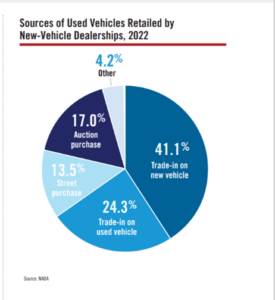 Dealers Association publishes in its year-end report on dealer financials. In 2022, dealers told NADA they acquired about 66 percent of their used vehicles from trade-ins with new or used vehicle purchases. That’s up slightly from the tally in 2019, which landed near 63 percent (see charts at right).
Dealers Association publishes in its year-end report on dealer financials. In 2022, dealers told NADA they acquired about 66 percent of their used vehicles from trade-ins with new or used vehicle purchases. That’s up slightly from the tally in 2019, which landed near 63 percent (see charts at right).
But check out “street purchases.” These are vehicles dealers acquire through “we’ll buy your car” and similar programs. The stats affirm how much dealers have pursued direct-from-consumer vehicles in the past two years. Last year, street purchases represented 13.5 percent of the inventory dealers acquired, nearly tripling the 4.8 percent in 2019. (The gains likely came at the expense of auction purchases, which dropped 10 percent during the same period.)
Meanwhile, public used vehicle retailer CarMax has also 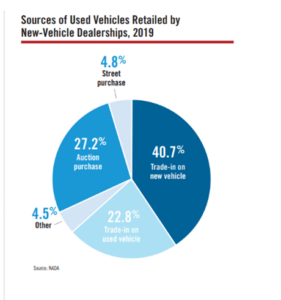 stepped up its efforts to acquire vehicles directly from customers. It’s always been a priority for CarMax, but it’s striking to note that in the first quarter of the company’s 2024 fiscal year, which ended June 30, direct-from-customer purchases accounted for 94 percent of the vehicles it acquired, almost double the percentage the company reported for its 2019 fiscal year.
stepped up its efforts to acquire vehicles directly from customers. It’s always been a priority for CarMax, but it’s striking to note that in the first quarter of the company’s 2024 fiscal year, which ended June 30, direct-from-customer purchases accounted for 94 percent of the vehicles it acquired, almost double the percentage the company reported for its 2019 fiscal year.
I share all this to underscore how the used vehicle business now requires dealers to operate more effectively and proficiently across multiple sourcing channels. And, in my recent conversations with dealers, it’s clear that some dealers are doing a better job acquiring inventory profitably beyond trade-ins and auctions than others. I thought I’d highlight some of the best practices the top-performing operators employ to give them a sourcing advantage:
- Measure individual channel performance. It’s critical for dealers and used vehicle managers to have more than inkling about the number, type and profitability of vehicles they acquire from individual channels. These basic benchmarks help you know, as you’re mapping out your stocking plan and strategy for the coming month or quarter, where you can expect to find the cars, and fill the gaps, to meet your volume and profit goals. This holistic view of where inventory comes from, which you can see in ProfitTime GPS’ Global Acquisition Dashboard, provides the foundation for an effective sourcing strategy.
- Measure individual appraiser performance by channel. When dealers begin to assess how appraisers perform on a per-channel basis, you start to see some useful insights. First, most dealers immediately understand that, without oversight, individual appraisers and buyers often have their own means and methods for assessing a vehicle’s value. Such differences often lead to wide disparities in the Cost to Market and Look to Book percentages of how dealers bring in inventory. Against this backdrop, dealers are now making better-informed decisions about individual appraisers, coaching them on how they assess vehicles and determine the acquisition price and, in some cases, relieving them of their responsibility to appraise and purchase cars in a specific channel.
- Establish a “universal appraisal process and objective.” Once dealers and used vehicle managers realize that widespread variances among appraisers yields sub-optimal results, they’ll often begin work to ensure that, in any particular channel, appraisers have a uniform and universal process for assessing a vehicle’s condition and establishing its value. (Note: There’s often a direct correlation between the degree of appraisal variance and the use of default or standard reconditioning estimates, which can relieve appraisers of taking the time to fully account for the condition of the vehicle in front of them.) Next, dealers will establish a strategic objective that every appraiser, in any channel, can use as a starting point to bring in vehicles on the money. In ProfitTime GPS, for example, dealers use vehicle investment scores to establish the strategic objective, and then measure appraiser performance, across many appraisals, to understand how well individual appraisers bring in vehicles on or off strategy.
When I’ve outlined these best practices with dealers, I also make a point that I suspect has been a pillar of CarMax’s culture and operational priorities for a long time—if you’re not consistently measuring how right your appraisers are bringing in cars according to your strategy, you really don’t have a means to manage your way to improved performance.
The post 3 Best Practices for Today’s Multi-Channel Inventory Sourcing Environment appeared first on Dale Pollak.
ProfitTime GPS in Practice: Key Takeaways from a 90-Day Pricing Alignment Challenge 6 Jul 2023 6:37 AM (last year)
 About two months ago, I wrote about general sales manager James Skop’s experience half-way through an operational challenge he accepted: To align his used vehicle pricing to ProfitTime GPS recommendations at least 85 percent of the time for 90 consecutive days.
About two months ago, I wrote about general sales manager James Skop’s experience half-way through an operational challenge he accepted: To align his used vehicle pricing to ProfitTime GPS recommendations at least 85 percent of the time for 90 consecutive days.
I checked in with Skop recently to see how the full 90-day run, which ended June 1, turned out.
“It’s been very successful,” Skop says. “We’ve made very good money. Actually, in May, we had the most profitable month in variable operations in our company’s history and we’ve been around since 1939. The 85 percent target worked really well for us. I’m going to stick at that, but I have to look at it on a car-to-car basis.”
Skop accepted the 90-day alignment challenge in March to see if it would help him improve used vehicle profitability. Previously, he followed ProfiTime GPS pricing recommendations a little more than half the time—most notably on the vehicles the system identifies as Bronze, or the ones with the highest risk and least investment return potential.
“We had a hard time swallowing the fact that we owned a vehicle for too much money,” Skop says. As a result, he’d typically price Bronze vehicles above ProfitTime GPS’ recommendations to give the vehicles a chance to make gross. The approach wasn’t working. Bronze cars averaged about 60 days in inventory and typically lost money when they sold.
During the pricing alignment challenge, Skop focused intently on Bronze vehicles, evaluating each vehicle’s pricing alignment and position daily. The effort paid off and proved that Bronze vehicles, when treated correctly, offer money-making potential.
“We turned around from losing money to making about $1,900 per car on Bronze vehicles,” he says. “When we have Bronze cars now, we make sure we sell them in a timely manner so we can make money. It’s really just accepting the fact that it’s a Bronze vehicle and pricing it as price leader and not a gross profit holder.”
Here are other takeaways Skop shared from his pricing alignment experience:
“Eyes” still matter. Skop says that while his confidence and trust in ProfitTime GPS’ pricing recommendations have grown, it’s still critical to validate that the system’s recommended prices make sense for each vehicle. “We live in an area where there’s rust on vehicles and a vehicle can be Platinum based on how I own it, but it’s not Platinum when you look at it,” he explains. The observation’s consistent with the experience of other dealers. While the data science behind ProfitTime GPS recommendations is sound, there are some vehicles where your eyes (ears and nose, too) are necessary to affirm a vehicle’s retail potential.
Platinum cars perform. Skop has been struck by how fast he’s selling Platinum aligned to ProfitTime GPS pricing recommendations. “We’re asking 103, 104 and 105 percent of the market and they’re still selling fast,” he says. “We looked at how to slow this down. We’re asking top dollar and we’re getting it. But I’m out of alignment on time. That’s where my opportunity lies.”
Stocking-to-discipline is critical. Like a lot of dealers, Skop once believed that you needed more cars in your inventory to drive sales volume. “I said for a long time that there’s no way you can have 30 days’ worth of inventory and continue to do the volume. I was wrong. You can do that. Our inventory hovers around the 70-car mark, which is the number of cars we sell. Because we’re turning our inventory once a month, I don’t have stuff aging out, which typically puts vehicles in your Bronze and Silver buckets.”
Skop’s understanding of the relationship between inventory size and distressed investments holds critical relevance for every dealer in the current market. Right now, the average days supply of used vehicles in dealer inventories is about 45 days—well above the more ideal 30-day mark. When dealers stock more cars than you sell, you’re likely stuck in a rut. Your inventory’s share of Bronze and Silver vehicles grows, you’re effectively forced to fast-sell your best cars (the Platinum and Gold ones in ProfitTime GPS) for too-little gross and your overall profitability suffers.
The post ProfitTime GPS in Practice: Key Takeaways from a 90-Day Pricing Alignment Challenge appeared first on Dale Pollak.
A Root Cause for Two Troubling Used Vehicle Trends 7 Jun 2023 7:50 AM (last year)
There are two troubling trends underway in used vehicle departments across the country that deserve dealers’ attention right now.
From here, it seems as if the trends and their singular root cause reflect a reality of life: Sometimes, when you make a bad decision, it begets more bad decisions.
cause reflect a reality of life: Sometimes, when you make a bad decision, it begets more bad decisions.
Let’s dive into the particulars.
Across the country, I’m seeing the share of Bronze vehicles—the ones the ProfitTime GPS solution identifies as investments with the highest risk and lowest potential for return—are on a steady rise. This past week, the average share of Bronze vehicles hit 46 percent, the highest level I’ve seen in the past nearly two years.
The ever-larger share of Bronze vehicles, in and of itself, isn’t necessarily troubling. It’s rare to find a dealer who doesn’t have at least some Bronze vehicles in inventory. There’s nothing inherently wrong with Bronze vehicles, either. They just happen to possess a combination of characteristics—their Cost to Market and like-mine Market Days Supply are both high, and their retail sales volume is low—that make them vehicles with higher risk and lower ROI potential compared to others.
That’s why I say an increasing number of Bronze vehicles isn’t necessarily troubling. But the increase all too frequently gives rise to a second, far more troubling trend. That is, as the share of Bronze vehicles goes up, the level of alignment to ProfitTime GPS’ price recommendations for these vehicles goes down. This past week, the overall pricing alignment for Bronze vehicles fell to 26 percent—the lowest level I’ve seen in recent memory.
This percentage is disturbing because it signals that roughly 75 percent of the time, dealers and their managers are rejecting ProfitTime GPS’ data science-backed recommendations that would, by and large, help them retail these distressed investments faster. In effect, the dealers are saying, “I believe that if I price these vehicles higher, and hold onto them longer, I’ll make more gross profit than if I accepted the recommendations and the poorer grosses and occasional losses they’d bring.”
We see this mindset in the pricing alignment data from ProfitTime GPS. It shows that, on average, dealers are pricing their Bronze vehicles about $1,000 higher than the system recommends.
It’s entirely possible the dealers might know something I don’t. But we should all at least be aware that in the current market, where depreciation has accelerated and retail demand isn’t as strong as it used to be, a distressed used vehicle investment isn’t likely to get better over time. In fact, it’ll get worse, with steeper losses that dealers will eventually need to take, probably in the form of a year-end write-down.
After seeing the trends rise and sharpen in recent weeks, I began looking for a root cause. I wondered if compensation plans, which effectively penalize a used vehicle manager’s paycheck and standing if they price vehicles for poor grosses and losses, might cause some to ignore pricing recommendations for Bronze cars. But I realized that while comp plans play a role in pricing alignment, they don’t fully explain why the share of Bronze vehicles keeps rising.
That’s when I looked at inventory levels. I started comparing the dealers’ balance between their rolling 30-day total of retail sales and the number of vehicles in their inventories. Then, I found the root cause: In almost every case, at almost every dealership, the dealers with rising shares of Bronze vehicles have more vehicles in stock than they’re selling in a 30-day period. Their inventory levels are out of balance with their retail sales.
To validate the theory, I looked at inventories of dealers who consistently balance the cars they stock with the rolling 30-day total of cars they sell. Guess what? You don’t see Bronze vehicles on the rise at these dealerships, and the alignment of their Bronze vehicles to ProfitTime GPS pricing recommendations is much higher.
Furthermore, it’s clear that the willingness to follow the Bronze vehicle price recommendations, and accept the poor grosses and losses that may come, owes to the fact that these dealers also have higher percentages of Platinum and Gold vehicles in their inventories. That is, the dealers make peace with the ROI from their Bronze vehicles because they’ve got more Platinum and Gold vehicles to effectively cover or offset the grosses they’ll realize on the Bronze vehicles.
The dynamic reminds me of the “Spoonful of Sugar” song from Mary Poppins: “A spoonful of sugar helps the medicine go down!”
It’s an apt message for dealers caught in the current trends. For you, it’s time to balance your inventory to your rolling 30-day total of retail sales and take the medicine on the Bronze cars currently in stock and as they arrive. With these strategic imperatives in place, you’ll reverse the trend of rising numbers of Bronze vehicles and start seeing more sugar in your inventory.
The post A Root Cause for Two Troubling Used Vehicle Trends appeared first on Dale Pollak.
A Means to Manage Your Gross Profit or Volume Preference in Used Vehicles 30 May 2023 6:36 AM (last year)
My recent post about dealer groups opting to go for used vehicle gross profit over volume prompted a question from several dealers—what if we do want to make the trade-off and make gross or volume our top priority?
It’s a great question because there certainly are times when a dealer’s  chief priority might be gross profit or volume, rather than a consistent balance between the two.
chief priority might be gross profit or volume, rather than a consistent balance between the two.
For example, a dealer who’s recently acquired a store they believe to be under-performing might be best served by gunning for volume over gross to establish (or re-establish) the rooftop as a local market leader in used vehicles. Or, there could be other circumstances, as noted in the recent Automotive News article that prompted my last post, where a dealer opts for gross profit due to difficulties acquiring sufficient inventory to advance their volume objectives and concerns about the strength of near-term retail demand.
Whatever the case, I have been cautioning dealers that if you do choose gross or volume as your primary used vehicle department objective, you’ll need a way to measure how well you/your team are working toward your objective in real-time and correct your present course if necessary. Without this real-time view, you’re always looking in the rearview mirror, evaluating your progress a month or more after the retail deals are already in the books and well past the time you can do anything about what’s already been done.
The limitations of a look-back approach to managing a dealership’s strategic objectives is a primary reason ProfitTime GPS offers a real-time view of a dealership’s current used vehicle pricing and how it aligns to the dealership’s strategy, whether it’s gross, volume or a balance of the two.
Here are a couple representative examples to illustrate my point. The examples might reflect how a dealer who sets gross profit as a chief priority, and another for a dealer who sets volume as their primary objective. (A quick refresher: ProfitTime GPS’s data science recommends retail price ranges for each vehicle, across Platinum, Gold, Silver and Bronze categories, to help dealers optimize their retail prices and capture the return on investment (ROI) or profit potential each vehicle offers.)
Gross-focused Dealer: This example shows a dealer who is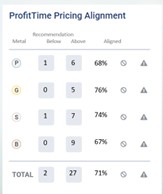 gunning for gross profit, and likely doesn’t mind less volume to achieve it. You can see the dealer’s preference in the number of vehicles priced “above” ProfitTime GPS recommendations across every precious metal category.
gunning for gross profit, and likely doesn’t mind less volume to achieve it. You can see the dealer’s preference in the number of vehicles priced “above” ProfitTime GPS recommendations across every precious metal category.
If I was this dealer, I would want to take a closer look at the Silver and Bronze vehicles to see a) how far they are priced above ProfitTime GPS recommendations and b) how long the vehicles have been in the dealer’s inventory. It’s possible that the dealer’s over-arching emphasis on gross profit might actually be counter-productive with vehicles ProfitTime GPS designates as the dealer’s highest-risk investments.
Volume-focused Store: You can tell this dealer prefers volume over 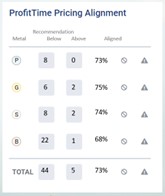 gross by the number of vehicles in inventory priced “below” ProfitTime GPS recommendations across every precious metal category. If I were the dealer, this view would tell me that my managers/team are going for volume.
gross by the number of vehicles in inventory priced “below” ProfitTime GPS recommendations across every precious metal category. If I were the dealer, this view would tell me that my managers/team are going for volume.
But I might also want to take a closer look at two things. First, I’d examine how far we’ve priced vehicles below the recommendations, particularly with the Platinum and Gold vehicles, to see if there’s an opportunity to be less aggressive and still meet our goals for volume. Second, I’d want to look into the reasons someone priced a handful of vehicles in the Gold, Silver and Bronze categories above the recommendations—decisions that would naturally slow the turn on these vehicles.
The biggest benefit I’ve seen from dealers using this approach to manage their gross profit or volume objectives is the ability to see what’s happening in real-time and make adjustments as needed. When they do this, they’re able to consistently stay true to their preferred objective.
The post A Means to Manage Your Gross Profit or Volume Preference in Used Vehicles appeared first on Dale Pollak.
Four Appraising Principles for the Current Market 25 May 2023 7:18 AM (last year)
There’s an interesting shift in my recent conversations with dealers about their used vehicle inventories that seems relevant to share here.
While many of my conversations address how dealers are pricing their used vehicles in the current market, there’s more interest on the part of dealers to tighten up how they appraise and bring in cars to achieve better outcomes.
The interest flows from a couple factors. First, used vehicle acquisition has become a m ore challenging task given the lower overall supply of used vehicles (particularly late model units). Second, wholesale prices have remained stubbornly high, most notably in auction settings where dealers (and rental car companies) are looking for inventory. Third, many dealers are at least attempting to source more inventory directly from customers through their service lanes, buy centers, lease returns, private party listings—basically anywhere they can find vehicles outside of trade-ins and auctions.
ore challenging task given the lower overall supply of used vehicles (particularly late model units). Second, wholesale prices have remained stubbornly high, most notably in auction settings where dealers (and rental car companies) are looking for inventory. Third, many dealers are at least attempting to source more inventory directly from customers through their service lanes, buy centers, lease returns, private party listings—basically anywhere they can find vehicles outside of trade-ins and auctions.
The dealers are asking how they can tighten up and potentially standardize the way they appraise vehicles against the backdrop of current market conditions and multi-channel sourcing environment. You might say they’re waking up to some of the appraisal inconsistencies I wrote about earlier this year.
The conversations have helped me distill what I’d consider four broad principles that can help dealers improve how their buyers, appraisers and managers bring in cars. Here’s a look:
Principle 1: The best way to get into a car is to know how you’ll get out of it. Almost everyone in the car business has at least heard this statement. The industry’s come a long way from the “old school” way of appraising cars, where you pay what you pay and apply your mark-up. The “retail-back” approach is more the norm now, but it has pitfalls. The most notable hitch relates to how appraisers effectively use a self-serving exit strategy, where they either adjust a vehicle’s competitive ranking or Price to Market percentage to allow paying more for a vehicle. Today, however, there’s a better way to ensure appraisers and buyers can see a vehicle’s proper retail exit as well as a target amount to bring in the car. ProfitTime GPS provides dealers a recommended retail exit price range, as well as a recommended appraisal range to minimize an individual’s ability to manipulate a vehicle’s true retail exit, which should provide the basis for evaluating and bringing in every vehicle.
Principle 2: Narrow the variances among appraisers. At many dealerships, it’s common to see differences of 10 percent or more across the acquisition Cost to Market percentages among appraisers. The variances owe to individual beliefs and biases, as well as confidence among appraisers that they know best how much a vehicle is worth. The aforementioned, strategy-tied appraisal and pricing recommendations from ProfitTime GPS offer a more uniform way for individual appraisers and buyers to at least start appraisals from the same place, and then pivot if they must.
Principle 3: Never second-guess an appraiser on a single car. This principle comes from personal experience. I can’t count the number of times I pointedly asked appraisers at my dealership, “What in the world were you thinking on this one?” I rarely got a satisfying answer—a fact that reflects the highly circumstantial nature of every appraisal. A better way, I now understand, comes from assessing appraiser performance across multiple appraisals, which helps you coach through the beliefs, biases and bad habits that result in letting the customer with the right car walk, or over-paying for the wrong car.
Principle 4: Measure appraiser performance against your strategy. One of the most encouraging things that’s emerged from the data science that drives ProfitTime GPS is the ability for dealers to establish a strategy for appraisals, give appraisers and buyers targets to start every appraisal, and then measure performance against the strategy. You can’t get this level of performance insight when you rely on Cost to Market or Look to Book benchmarks alone to measure and manage appraisers, especially in today’s multi-channel inventory sourcing environment. Today, it’s imperative that dealers set (and adjust) their appraisal strategy appropriately across individual sourcing channels and measure performance the same way. In the end, appraisers and buyers have clearer expectations of how they should handle cars in each channel and, better still, they know your oversight isn’t arbitrary.
I should add that deploying these principles and following them consistently across appraiser and buyer teams isn’t a cake walk. In some cases, you’re undoing a deeply entrenched way of appraising and pricing cars, and you’re shining a light on appraising practices that some may not want dealers to see. Even so, dealers who are disciplined about following these principles share an encouraging trajectory. Not long after the effort’s underway, they see less debate and friction over appraisals and retail pricing for properly appraised vehicles. Instead, there’s far more discussion around the benefits that occur when a larger share of vehicles arrive in inventory “on strategy” across every channel and then retail when they should.
The post Four Appraising Principles for the Current Market appeared first on Dale Pollak.
Do You Really Need to Sacrifice Volume for the Sake of Gross Profit? 23 May 2023 8:30 AM (last year)
An Automotive News story this past weekend gave me pause. The piece highlighted an apparent strategic decision by public dealer groups and large used vehicle-only retailers to go for gross profit at the expense of volume.
The article explains how the combination of high vehicle  acquisition costs, particularly with auction vehicles, and affordability concerns among buyers, led company executives to the go-for-gross-over-volume decision. This quote in the piece sums it up: “It was a better trade-off to have lower volume and higher gross profits, which really generate a better [earnings per share result] for us overall.”
acquisition costs, particularly with auction vehicles, and affordability concerns among buyers, led company executives to the go-for-gross-over-volume decision. This quote in the piece sums it up: “It was a better trade-off to have lower volume and higher gross profits, which really generate a better [earnings per share result] for us overall.”
On one hand, I fully understand the decision to give up volume, especially if the only way you’ll be able to achieve it requires buying higher-cost auction vehicles to make your goals. It’s also true that there’s been a long-standing belief in the car business that you can’t achieve optimal gross and volume at the same time. If you go for one, the other’s got to give.
But I would submit that the art and science of used vehicle inventory management has advanced to a point where this classic trade-off isn’t always necessary. There are plenty of dealers who are growing volume and gross despite the headwinds in the current market.
The primary difference, it seems, is that these dealers are taking advantage of new data science and related decision-making insights to optimize turn and gross on every car. Plus, they’re being very proactive about acquiring inventory beyond auctions and trade-ins—a multi-channel sourcing strategy that helps offset the higher cost of auction cars the dealers feather into their inventories to achieve the volume they desire.
The dealers also exert discipline across their used vehicle business in a few critical ways:
Maintaining a balance between your used vehicle stocking and retail sales. If you read a bit between the lines in the Automotive News article, it seems like some of the larger used vehicle retailers over-stocked their inventories in anticipation of first quarter sales that didn’t fully materialize. At least a portion of the fall-off in their average front-end gross profit figures likely owes to selling vehicles at break-even or a loss, just to get rid of them. By contrast, dealers who were disciplined about maintaining a balance between their rolling 30-day total of retail sales and their stocking levels didn’t face this problem—especially when they priced the troubled cars right from Day 1.
Knowing the difference between your turners and earners. This is where data science proves extremely helpful. With ProfitTime GPS, dealers can appraise, purchase and price vehicles with the benefit of knowing two critical things—how the vehicle will fare as an investment if they acquire it, and how they can appraise and price it to achieve optimal outcomes. Such knowledge goes a long way toward ensuring dealers are patient with cars that will deliver the healthiest gross profit and more urgent with vehicles that they should retail out of quickly to minimize risk. These insights go a couple steps farther—they help you avoid acquiring the wrong vehicle, paying up for vehicles you don’t really need and identifying vehicles with retail potential you might otherwise have overlooked or passed by.
Putting a greater priority on customer experience. I had a conversation the other day with a dealer who isn’t afraid of high-cost auction vehicles, while proactively acquiring cars across every available channel. The dealer’s thinking: Why should I shy away from selling more volume when I know I can sell and satisfy a customer and set the stage for earning their business in the future? The dealer’s playing long ball, effectively stepping up to grab a bigger slice of the market share pie while competitors retreat to bolster their bottom lines.
I’m not suggesting that the large used vehicle retailers highlighted in the Automotive News story have it wrong. My point is that growing gross profit and volume doesn’t have to be an either/or proposition. You can achieve both goals if have the belief, insights and will to make them happen.
The post Do You Really Need to Sacrifice Volume for the Sake of Gross Profit? appeared first on Dale Pollak.
ProfitTime GPS in Practice: Don’t Worry About the Precious Metal Composition of Your Inventory 5 May 2023 7:27 AM (last year)
I’ve been hearing a similar concern from ProfitTime GPS dealers in recent conversations: “I need more Platinum and Gold vehicles to get my average front-end gross profit back on track.”
The concern generally follows two realizations:
- Bronze vehicles—the ones ProfitTime GPS identifies as the
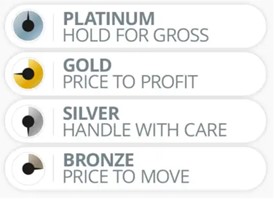 units with the highest risk and lowest profit or ROI potential—make up about 40 percent to 50 percent of the dealers’ inventories. When dealers view the average mark-up and days to sell for these vehicles, they can see the front-end gross profit they’re likely to make is significantly lower than other vehicles, and less than what they’d like.
units with the highest risk and lowest profit or ROI potential—make up about 40 percent to 50 percent of the dealers’ inventories. When dealers view the average mark-up and days to sell for these vehicles, they can see the front-end gross profit they’re likely to make is significantly lower than other vehicles, and less than what they’d like. - Platinum and Gold vehicles—the ones ProfitTime GPS identifies as the units with the least risk and highest profit or ROI potential—tend to make up about 15 percent to 25 percent of dealers’ inventories. The dealers can see these vehicles have the richest mark-ups that should offer significantly higher front-end gross profits when they sell.
With this backdrop, it’s completely understandable that dealers would want to stock more Platinum and Gold vehicles. They might even direct their appraisers and buyers to do a better job of bringing in Platinum and Gold vehicles, while encouraging them to avoid Silver and Bronze.
When I hear the concern, it raises a red flag.
In my view, dealers should not be appraising and acquiring cars to engineer the previous metal composition of their inventories. To be sure, there’s nothing wrong with establishing precious metal targets to guide how appraisers and buyers value and bring in cars. But such targets should be the starting point, not necessarily the end point, for used vehicles, especially when they’re coming from trade-ins.
That’s because dealers should be focused on acquiring the cars they need, and appraising cars to make deals. We know the circumstances around individual customers and cars are always different. Hence, it can be counterproductive, and even dangerous, when dealers try to fit every car into a specific precious metal parameter.
Instead, I advise dealers that it’s far more important to treat every vehicle you bring in exactly how it should be treated. If it happens to be a Silver or Bronze car, ProfitTime GPS’ pricing recommendations will help you retail it quickly to realize its optimal profit or ROI potential. Better still, when Silver and Bronze vehicles are properly handled, they’re great cars. They typically represent volume cars that offer an F&I opportunity and keep your sales teams moving. Meanwhile, if you’ve got a Platinum or Gold car, ProfitTime GPS’ pricing recommendations will encourage patience to give the vehicle the time it needs to make its maximum return.
When dealers follow this operational discipline, the precious metal composition of their inventories takes care of itself and every used vehicle they own gets its best shot to make money.
The post ProfitTime GPS in Practice: Don’t Worry About the Precious Metal Composition of Your Inventory appeared first on Dale Pollak.
ProfitTime GPS in Practice: Halfway Through A Dealer’s 90-Day Pricing Alignment Challenge 21 Apr 2023 7:21 AM (last year)
In late February, sales manager James Skop of Fletch’s Buick GMC Audi in Petoskey, MI, made a bold decision.
The decision followed a conversation with his vAuto Performance  Manager, Vinson Treharne, about the alignment of the store’s used vehicle pricing to ProfitTime GPS recommendations. For months, the pricing alignment had been running about 60 percent.
Manager, Vinson Treharne, about the alignment of the store’s used vehicle pricing to ProfitTime GPS recommendations. For months, the pricing alignment had been running about 60 percent.
Skop explains: “Vinson showed us our data. We were at 60 percent because, a lot of the time, we weren’t willing to swallow the fact that we had a Bronze vehicle that wouldn’t make $2,000 or $3,000. Other times, we had a Platinum vehicle where ProfitTime GPS said we should be making $5,000 or $6,000 but we wanted to move it quick and make the money. We were selling ourselves short by thousands of dollars.”
To correct the problem, Skop agreed to a 90-Day Pricing Alignment Challenge. He pledged to keep his used vehicle pricing aligned to ProfitTime GPS recommendations at least 85 percent of the time, at all times.
Why not 100 percent alignment? “We can’t go 100 percent,” Skop explains. “We have rust in northern Michigan. So, with some of the cars, I have to price the car to what it is, not what the computer says. You have to know the vehicles better or more than the computer system sometimes.”
Skop makes a great point—if a dealer’s 100 percent aligned to ProfitTime GPS recommendations, I generally agree that they’re not wearing their “car person” hats enough.
Halfway through the 90-day challenge, Skop is pleased with the results he’s seen so far. The store closed the month of March selling two fewer cars than they did in February, while making $38,000 more in front-end gross profit. “That’s just front-end gross,” he says. “The results give me the faith and cold hard numbers to continue what we’re doing.”
I asked Skop to highlight how his 25 percent higher overall alignment with ProfitTime GPS recommendations helped him achieve the better results. No surprise…the improvement came from managing Bronze cars with more urgency and Platinum cars with more patience.
On the Bronze cars: Skop notes the average days to sell fell from 55 days to 50 days during March. Meanwhile, the faster pace of Bronze vehicle sales volume helped the store go from an average $1,000 front-end loss to an average $900 in positive front-end gross profit. “The difference is just swallowing the pill and pricing the Bronze cars right from the get-go,” he says. “We’re not trying to make $3,000 to $4,000, and just slapping the profit on the car. Then, the car depreciates and we’re further in the hole.”
On the Platinum cars: Skop says the average days to sell for Platinum vehicles increased from 18 to 21 days as they accepted a higher share of ProfitTime GPS recommendations. Also, thanks to the faster sales of Bronze cars, they faced less pressure to move Platinum cars quickly. “Your Platinum and Gold vehicles are the ones you’re going to hold out on a little bit longer and make more money,” he says.
In addition to maintaining the daily price alignment discipline Skop has achieved during the first half of the 90-day challenge, he and his team will be turning their attention to vehicle acquisition. The thinking: Now that they’ve figured out how to move Bronze vehicles more quickly, they need to make sure their appraisal and acquisition efforts bring in sufficient inventory to meet their monthly volume targets—even if it means acquiring more Bronze and Silver, rather than Gold and Platinum, cars.
“Typically, when you go to an auction, it can turn into a Bronze vehicle quite quickly,” Skop says. “But what we were seeing is that we were afraid to buy those vehicles because, first of all, the grosses are not as high, which kind of put us into a position of not having enough volume cars. We probably also missed some trades because we were trying to keep too many Golds and Platinums on the lot to make ourselves feel comfortable.”
I’m happy for Skop and his team, and grateful for his willingness to share the early results from his 90-Day Pricing Alignment Challenge. He and his team are out-performing other dealers in their area and they’re doing it at a time the market’s in decline. The early results reflect the combination of the team’s used vehicle pricing discipline and diligence, and the strength of the ProfitTime GPS solution.
Skop and I also agreed to reconnect when his 90-day challenge concludes next month. I’m excited to learn more about his experience and share it here.
The post ProfitTime GPS in Practice: Halfway Through A Dealer’s 90-Day Pricing Alignment Challenge appeared first on Dale Pollak.
A Look at the “Profit Coma” Problem in Used Vehicles 19 Apr 2023 7:05 AM (last year)
If memory serves, I first heard the term “profit coma” from dealer Brian Benstock of Paragon Honda during a podcast more than a year ago. He used the term to describe how a run of unprecedented profitability could result in dealers being slow to move as used vehicle market conditions became less favorable.
Curiously, “profit coma” has come up in dealer conversations  the past couple weeks—likely triggered by the current inflection point we’re seeing in the market and the tougher conditions dealers now face as they acquire and sell used vehicles.
the past couple weeks—likely triggered by the current inflection point we’re seeing in the market and the tougher conditions dealers now face as they acquire and sell used vehicles.
The inflection point’s arriving almost exactly as analysts like Cox Automotive chief economist Jonathan Smoke predicted. Broadly speaking, retail demand seems to be slowing down after starting the year stronger than expected. Wholesale values continue to decline and retail prices have begun to soften, trailing the wholesale values as they have in the past. Smoke and others expected such conditions would emerge in mid- to late April, and that’s pretty much what we’re seeing.
The current conditions have caused some dealers to take a harder look at their used vehicle operations to find ways they might resuscitate their used vehicle sales volumes and profits. Such efforts, for which I’ve been providing counsel in recent days, caused more than one dealer to realize that they had been suffering from a profit coma without really knowing it.
The symptoms of the profit coma show up in two places:
1. Inventory Acquisition: I’ve talked to several dealers who lamented that their March sales volumes, and their current pace of sales in April, likely suffered from not having sufficient inventory. Note: These dealers’ inventories are not significantly out of balance with their rolling 30-day total of retail sales. Rather, the dealers have realized, upon closer examination, that their efforts to acquire inventory likely suffered as appraisers and buyers didn’t put enough money into cars they really needed.
As one dealer put it, “they were still looking to take in cars with potential for the $3,000 and $4,000 front-end grosses we’ve been getting.” Now, the cars and customers are gone, symptoms of the profit coma. The dealer, and his used vehicle manager, have now agreed to ensure appraisers and buyers know when a car they really need arrives and to step up to acquire it, even if the front-end grosses are leaner than they’d like.
2. Retail Prices: When you’ve come off two-plus years of seeing front-end gross profits rival the best that dealers in my time achieved 20 to 30 years go, it’s difficult to price cars for anything less—another sign of the profit coma. But the current market isn’t as forgiving as it used to be. Retail buyers are looking much closer at what they can afford to buy and what they’re willing to pay. When dealers ask too much, they aren’t selling cars unless and until they mark down their asking prices. I should add that the failure to move these vehicles often leads to a profit coma corollary—dealers cheap-selling their best cars to make their monthly volume target.
I’d be remiss if I didn’t add that the profit coma problem isn’t as profound with ProfitTime GPS dealers who are highly disciplined to the solution’s appraisal and pricing recommendations. When they consistently apply the recommendations, there’s no mystery about the vehicles they can, and should, step up to acquire. Similarly, there’s little, if any, doubt about the cars that need to be priced to move quickly, and those that deserve a mark-up, and time, necessary to deliver their optimal ROI.
Some of the ProfitTime GPS dealers will also admit that they, too, were in a profit coma not so long ago. But now they’re awake, alert and actively taking deals from dealerships where the profit coma persists.
The post A Look at the “Profit Coma” Problem in Used Vehicles appeared first on Dale Pollak.
ProfitTime GPS in Practice: Knowing When It’s Right to “Roll the Car” 7 Apr 2023 10:09 AM (last year)
In my most recent post, I shared how dealers, and used vehicle managers in particular, get antsy about meeting their sales volume targets near the end of the month and discount the vehicles they understand to be the easiest to reduce. As I noted, in many cases, the vehicles are their best investments. The ones ProfitTime GPS designates as Platinum and Gold cars.
But I’ve also come to realize that the desire to meet monthly  sales targets, and the practice of selling Platinum and Gold cars for less than they could or should command, isn’t limited to the end of the month. I came to the realization following several recent conversations with dealers, in one-on-one and 20 Group settings, when we examined the Days to Sell metrics for dealers’ Platinum and Gold vehicles, and where their retail sales landed within a particular month.
sales targets, and the practice of selling Platinum and Gold cars for less than they could or should command, isn’t limited to the end of the month. I came to the realization following several recent conversations with dealers, in one-on-one and 20 Group settings, when we examined the Days to Sell metrics for dealers’ Platinum and Gold vehicles, and where their retail sales landed within a particular month.
The analysis revealed that Platinum and Gold vehicles leave dealer inventories all the time for substantially less than the retail prices ProfitTime GPS recommends for the cars. I found that these vehicles were either priced less than their individual price recommendations or they were priced right and someone, often a manager, approved a substantial discount at the desk to sell the car.
When I ask dealers and managers about the dynamic, I hear common refrains: “We don’t pass on any deal,” or “We do any deal where there’s a profit,” or “We need to roll the car.”
I understand why such decisions happen, particularly in the current market, where used vehicle sales appear to be on the wane and selling a car today seems like the right thing to do.
But I question if decisions to retail Platinum and Gold vehicles for less money really represent the right financial decisions. For example, does it really make sense to roll a Platinum or Gold car for $1,800 in front-end gross when, if you waited because you knew you could, you’ll earn the $3,000 gross data science suggests you’re likely to get?
To be clear, rolling Platinum and Gold cars for less money isn’t always wrong. There are specific circumstances and customers where this decision is the right one. However, the frequency of these deals suggests they’re more about a desire to sell a car fast because it’s easy.
Herein lies a two-tiered opportunity I’ve been recommending for dealers:
First, you need to raise awareness with managers and sales associates about the financial potential Platinum and Gold vehicles truly represent for your used vehicle department. That’ll help them express the vehicle’s true market value with customers. Remember, there’s a reason ProfitTime GPS ranks some vehicles as Platinum and Gold, and it’s due to their higher market appeal and scarcity, and how right you own them.
Second, you need to exert more in-the-moment discipline when the urge to “roll a car” arrives. Your urgency should always be higher for Silver and Bronze vehicles, rather than Platinum and Gold units, irrespective of where you stand in relation to your monthly sales volume target.
When dealers and managers consistently follow these two principles, your used vehicle sales and profit goals tend to take care of themselves, month after month.
The post ProfitTime GPS in Practice: Knowing When It’s Right to “Roll the Car” appeared first on Dale Pollak.
A Familiar Monthly Ritual that Dealers Should Recognize and Repair 31 Mar 2023 7:39 AM (2 years ago)
Let’s see if the following scenario sounds familiar:
In the final days of a month, a used vehicle manager gets worried about meeting their monthly sales goal. The current month’s sales might be three, five, seven or 10 units behind the goal. The manager’s worried that he/she will  miss the target and miss out on the monthly volume bonus.
miss the target and miss out on the monthly volume bonus.
The manager’s next step is to identify vehicles that, if they cut the price, they know, or at least suspect, will move quickly. Typically, these vehicles are the ones the manager regards as the easiest to dicsount—ones they bought right and priced up to make a good gross profit. Then, the manager lowers the prices and, voila!, the vehicles sell. The used vehicle manager’s feeling good. The department makes the sales target, the manager makes his/her monthly bonus and they ripped a couple trades from customers who were happy to let go of their current vehicle because of the great deal they got on the car they purchased.
A few days later, as the next month gets underway, the manager’s faced with another problem. Leads and traffic are down. The showroom’s a ghost town. The sales team’s complaining that there’s no one to sell. Everyone wonders what happened.…
I’ve observed versions of this story countless times over the years. It’s a ritual that happens almost every month, except July, when many dealers roll out the bunting and balloons for Fourth of July sales, which front-loads the month’s sales volume.
The dynamic’s certainly been familiar to vAuto Performance Managers, too. They often hear the complaints that business is slow from used vehicle managers during start-of-the-month calls and in-person engagements.
Today, thanks to the data science behind ProfitTime GPS and the solution’s ability to identify the investment value of every used vehicle, we now know exactly what’s going on when this monthly ritual occurs. The upshot: Used vehicle managers are cheap-selling their Platinum and Gold vehicles—those ProfitTime GPS deems their best investments—to meet the monthly volume nut. In turn, as a new month starts, leads and traffic are down because the highly desirable cars that attracted buyers (the Platinum and Gold ones) are gone.
Digging deeper, we also now know that the used vehicle managers deployed month-end discounts on Platinum cars because they were unwilling to price their Bronze vehicles—the ones ProfitTime GPS identifies as those with the highest risk and lowest investment values—where they should be. Why? Because pricing the vehicles properly would mean less-than-favorable front-end gross profits when the vehicles sell, an outcome used vehicle managers prefer to avoid, especially at the end of the month.
Thankfully, with the help of ProfitTime GPS and its insights, we now know exactly how to make this monthly ritual go away for good. The fix, however, isn’t necessarily easy because it requires a greater degree of discipline and fortitude on the part of used vehicle managers to make sure their used vehicles are priced in proper alignment with each unit’s investment value from Day 1.
When dealers and used vehicle managers exercise this discipline, the ritual of cheap-selling their best cars at the end of the month and then seeing too-little traffic and sales goes away. Instead, dealers achieve a more consistent pace of sales, thanks to a larger share of Bronze vehicles selling faster and driving volume, with Platinum vehicles retailing when they should, for the retail prices they can command.
I’d encourage dealers to take a closer look at the cars that leave their inventories quickly at the end of a month, paying particular attention to the price discounts that preceded their retail sales. Then, they should ask the following question: Wouldn’t we be better off if we did something different? Perhaps, the answer is to provide a month-end sales objective tied to the reduction of the Silver and Bronze vehicles, to avoid cheap-selling your Platinum and Gold vehicles, which are always your best investments.
The post A Familiar Monthly Ritual that Dealers Should Recognize and Repair appeared first on Dale Pollak.
An Earlier End to Our Unusual Spring Sales Bounce? 27 Mar 2023 1:55 PM (2 years ago)
If there’s one thing that might define of how this year’s spring compares to prior years, it might be that everything’s arriving sooner than expected.
My friends in the Chicago area report that early spring flowers have  already arrived, roughly two to three weeks before they typically appear. There’s worry there that fruit tree blossoms will suffer if the area gets another overnight freeze, which often happens in April.
already arrived, roughly two to three weeks before they typically appear. There’s worry there that fruit tree blossoms will suffer if the area gets another overnight freeze, which often happens in April.
In used vehicles, the seasonal spring selling bounce arrived early, too. Sales were higher than almost everyone expected in January and February. We began to see another period of appreciation in both wholesale and retail values as many dealers sold more cars than they expected, and they needed to replenish their inventories.
At the time, I was among those who advised that the current market conditions would create a money-making opportunity dealers. We also cautioned that the dealer-favorable conditions of rising wholesale values and retail prices would take a southerly turn by mid-April or early May.
Today, it looks like this market turn is arriving early, too. In the past couple weeks, Manheim has reported declines in its “lane efficiency,” a metric that assesses “no sales” in the lanes and is often regarded as a predictor of future vehicle values. Since lane efficiency’s fallen of late, we now expect wholesale and retail values will follow suit.
At the same time, we’re seeing the appreciation of wholesale and retail values slow down. Both value sets are still rising, but the rate of appreciation has diminished.
Like many, I’ve asked the analysts why the market appears to be turning quicker than expected. They point to potential contributors that extend beyond the car business—bad weather in several parts of the country, ongoing inflation, turmoil and uncertainty in the banking industry, the Fed’s decision last week to raise interest rates again and the onset of spring break vacations.
Whatever the root causes, it should be stressed that no one expects any deep or sudden drop in the used vehicle market. Rather, it appears that we’re in for another stretch where dealers will need to earn rather than expect their rightful shares of used vehicle sales and profits.
The post An Earlier End to Our Unusual Spring Sales Bounce? appeared first on Dale Pollak.
A Closer Look at an Uncertain, Unpredictable Used Vehicle Market 17 Mar 2023 11:14 AM (2 years ago)
My phone’s been buzzing off the hook in the past week as dealers are almost single-mindedly asking the same question: Where’s the used vehicle market headed?
The calls and questions moved from sporadic to a seemingly steady  stream in the past week. Why? Well, the collapse of Silicon Valley Bank, and the shudders the bank’s failure has sent through global banking, financial and regulatory circles stands as a primary catalyst.
stream in the past week. Why? Well, the collapse of Silicon Valley Bank, and the shudders the bank’s failure has sent through global banking, financial and regulatory circles stands as a primary catalyst.
But the interest in where the market’s moving also owes to where we’ve been in used vehicles in recent weeks. Few expected the spring selling and tax refund season to arrive in January. Even fewer thought we’d see yet another period of wholesale value and retail price appreciation. The conditions caught some dealers, mainly those who were busy unloading or writing down inventory that hadn’t sold in the final quarter of 2022, by surprise. Suddenly, they found themselves in the hunt to get more cars.
To me, the events we’ve been experiencing all point to what might be considered the new nature of today’s used vehicle market: It’s more uncertain, more volatile and less predictable than it’s ever been. Further, there’s little evidence to suggest that what any of us might consider more “normal” or stable market conditions will arrive anytime soon.
In fact, there are several signs that suggest more turbulence ahead. Cox Automotive chief economist Jonathan Smoke believes May 1 will be a turning point. By then, the IRS will have largely finished issuing tax refund checks, which will temper the wind that’s behind recent retail demand. In addition, he believes uncertainty in the broader economy will cause some consumers to pause decisions to buy used vehicles.
The uncertainty extends to the Federal Reserve and their efforts to curb inflation. A week ago, many economists and financial analysts were all but certain we’d see another increase. The big question was whether we’d see a quarter- or half-point increase. Today, following the SVB-led disruption in the banking and finance sectors, it’s anyone’s guess what the Fed will decide to do.
My guidance to dealers in these more uncertain, more volatile and less predictable market conditions has two components.
The first is that they’ll need to keep their inventories clean and lean as we head deeper into the spring. No one really knows if May 1 will prove to be a critical turning point, but I’m not privy to any signals that would suggest retail demand will gain strength in the weeks ahead. It seems to me that what we’re witnessing amounts to a fair warning. If you’re not maintaining a balance between your 30-day rolling total of retail sales right now, you’d best be looking to strike that balance very soon.
The second is that dealers should strongly consider rethinking how they manage their used vehicles. In the current market, market supply and demand dynamics are increasingly segment-specific, it no longer makes sense to effectively treat every car the same. There’s too much volatility to give every fresh unit a sizable mark-up and then mark it down at regular seven-, 10- or 14-day intervals until it sells. If you follow this approach, and you’ve got too many cars in stock, you’re headed for trouble.
That’s why I’ve been advocating that dealers adopt a Variable Management strategy, where each car’s investment value dictates how you treat it. If you know a car’s risky, you price it to sell quickly on Day 1. If you know a car’s got significant gross opportunity, you price it to achieve its potential while paying close attention to how changing market conditions may affect its potential and signal the need for a price change.
So far, the Variable Management strategy, and ProfitTime GPS solution we built to support it, seems to be helping dealers navigate today’s more uncertain and volatile market. The data science that drives the solution’s investment value rankings for each vehicle, and the appraising and pricing recommendations it assigns to each vehicle, is proving to be a source of clarity and confidence for dealers who use it—a sharp contrast to the doubt I’m sensing among other dealers about what whatever’s coming next in used cars.
The post A Closer Look at an Uncertain, Unpredictable Used Vehicle Market appeared first on Dale Pollak.
ProfitTime GPS in Practice: A Longtime Appraisal Problem That’s More Problematic 10 Mar 2023 5:38 AM (2 years ago)
Every dealer would agree that you make your money when you buy a used vehicle.
That’s why appraisals are so critically important. The appraisal  establishes the return on investment (ROI) and profit potential on every vehicle you acquire, based on an appraiser’s assessment of the vehicle’s condition and determination of how much to pay for a vehicle.
establishes the return on investment (ROI) and profit potential on every vehicle you acquire, based on an appraiser’s assessment of the vehicle’s condition and determination of how much to pay for a vehicle.
Unfortunately, as I noted in a recent post, the appraisal process in many dealerships suffers from inconsistencies between appraisers, both in how they assess a vehicle’s condition and in how they determine the optimal purchase price. In the post, I noted that I would address an aspect of the appraisal process that appears to be increasingly problematic for dealers—the inaccuracy of reconditioning costs appraisers apply to a vehicle they acquire for a retail sale.
To be sure, the accuracy of reconditioning estimates in appraisals has always been a topic of conversation, if not concern, among dealers. If your estimates don’t reflect the actual costs required to recondition a vehicle for retail sale, the car’s ROI and profit potential typically suffer.
But the problem’s never gone away and today, as dealers use solutions like ProfitTime GPS to establish investment value targets to guide how appraisers bring in cars, the inaccuracy of reconditioning estimates stands out as clear as a bell.
Here’s an example: During last year’s run of inventory scarcity, a Toyota store in a California dealer group determined that they would do everything they could to ensure they had sufficient used vehicle inventory to sell. They set aggressive investment value appraisal targets in ProfitTime GPS to ensure they did not lose any potential acquisitions due to not stepping up enough to acquire the vehicle.
Early on, it was a counter-productive result from what they were trying to accomplish. What they found if you don’t have a really thorough evaluation and condition process in your appraisal. The tool works great if you’re putting the right recon and expense into that car. But if you’re not, it can be counter-productive when you’re aggressive in acquiring the store down and then you’re scaling the score down as a result, then you’re shooting yourself in the foot.
“It wound up being counter-productive,” the group’s director of operations shared. “What they found is that they didn’t really have a thorough evaluation of vehicle condition and they didn’t have the right reconditioning expense. If you’re off on recon by $1,500, and you’re getting aggressive buying cars, you end up in trouble as you scale it.”
The director adds that “cosmetics affected our misses more than mechanical. If you’ve got to shoot a couple panels and put a windshield on a car, it adds up quick. That’s a $1,000 bill in today’s market.”
After some “significant” issues with wholesale losses and gross profit, the store’s on better footing, the director says. It’s established less aggressive acquisition targets and focused more intently on ensuring appraisal estimates reflect the actual costs the vehicle will incur as it gets reconditioned in the service department. “It’s not 100 percent perfect but we’re missing fewer of the major issues that really burn you.”
Mike Boyd, who directs business development for vAuto’s iRecon solution, says the situation at the Toyota store isn’t uncommon. Across the industry, Boyd says that when reconditioning estimates are off, they’re off by an average of $300 to $500—a sizable chunk of retail gross that effectively disappears when the vehicle gets the reconditioning it needs.
Part of the problem, Boyd says, comes from appraisers using standard reconditioning estimates when they appraise every car. The estimates may have been established years ago and they no longer reflect the reality of today’s reconditioning costs, much less the work that really needs to be done on a specific car.
Therein lies an opportunity. As dealers move away from a one-size-fits-all strategy for pricing vehicles in today’s more variable market, they’ll need to depart from one-size-fits-all reconditioning estimates in appraisals. Now more than ever, success in used vehicles depends on having the right data to make the right decisions with every car.
The post ProfitTime GPS in Practice: A Longtime Appraisal Problem That’s More Problematic appeared first on Dale Pollak.
ProfitTime GPS in Practice: How and Why “Cost” Doesn’t Drive Pricing Recommendations 3 Mar 2023 7:04 AM (2 years ago)
I’ve had a version of the following conversation with dealers in recent weeks. The conversation typically arrives after I’ve shared why dealers should be treating their distressed (or “Bronze”) vehicles differently and getting out of them faster. It goes like this:
Dealer: “Wait a minute. You’re telling me that I need to lower  the price on my Bronze vehicles because I own them for too much money?”
the price on my Bronze vehicles because I own them for too much money?”
Me: “That’s exactly right. You’ve had the cars for too long. You’re in them for too much. They’re depreciating. You need to move them.”
Dealer: “But you’ve been telling me to ignore my cost and Cost to Market when I price used cars for years!”
Me: “That’s true. But what makes you think that your Cost to Market on these Bronze vehicles means you need to price them cheap?”
Dealer: “That’s what you just told me. The cars are Bronze because of my Cost to Market, right? And isn’t that what you do with Bronze vehicles…you price them cheap?”
Me: “Ahhhh. I see. I’m sorry. Let’s step back so I can help you understand how ProfitTime GPS uses Cost to Market and why it doesn’t drive the system’s price recommendations.”
The frequency of this conversation suggests a need to address a growing false assumption, misconception or over-simplification about the way data science works in ProfitTime GPS, and how a vehicle’s Cost to Market influences its investment value but matters far less, if at all, when it comes to the system’s individualized, car-by-car pricing recommendations.
How Cost to Market Influences Investment Value
In ProfitTime GPS, a vehicle’s Cost to Market serves as one of three primary data points that the system distills, weigh and uses to determine a vehicle’s Platinum, Gold, Silver or Bronze investment value. The other data points are the vehicle’s like-mine Market Days Supply and its retail sales volume. The individual weight the system gives to each of these variables, as well as other market factors, differs by car. The end result is an individualized, unique investment value for every vehicle, attuned to the circumstances of each car.
As such, each vehicle’s Platinum, Gold, Silver or Bronze investment value serves as a signal of the opportunity and/or risk each vehicle offers as a retail unit. The investment value indicates how you should treat the vehicle to minimize its risk or optimize its opportunity. The investment value gives you a way to see, across your inventory, from the moment you acquire a vehicle, whether a vehicle should move fast, move slow, or land somewhere in between. In other words, the investment value signals the “turn policy” you should establish for each car, and it helps you establish broader turn policy targets for each investment class (Example: Platinum (50 days), Gold (40 days), Silver (30 days) and Bronze (20 days.)
But it should be understood that the Platinum, Gold, Silver and Bronze designations, in and of themselves, have little direct bearing on the actual retail prices ProfitTime GPS recommends for individual vehicles. The investment value designations, and associated metrics like Cost to Market, are connected to price recommendations but they do not directly influence them in the way dealers think they do.
Instead, the recommendations come from a different set of data, and data science, that’s built into ProfitTime GPS’ pricing recommendation algorithm. Let’s have a look.
Factors Behind ProfitTime GPS Price Recommendations
Prior to the launch of ProfitTime GPS, data scientists at Cox Automotive and vAuto spent significant time trying to understand all of the factors that indicate a vehicle’s probability of selling within seven days, at any price. This work led to an algorithm that blends and measures all of the factors for each individual vehicle.
Broadly speaking, the factors that drive the ProfitTime GPS price recommendations are drawn from three buckets—everything the system knows about the car, everything it knows about the market for the car and everything it knows about a dealer’s past experience selling the car. With this information, the algorithm distills and weighs the factors most relevant for an individual car and produces a price recommendation.
As a result, the system doesn’t recommend that dealers price every Bronze car to be the cheapest, or lowest in the competitive set, to sell fast. Rather, each Bronze car’s price recommendations reflect the optimal market position for the vehicle and its unique circumstances. Hence, some price recommendations for Bronze cars are higher than others; the degree of difference depends on the car, the market and how the dealer’s likely to sell it, based on past experience.
The same is true for Platinum cars—the ProfitTime GPS price recommendations don’t put every Platinum car at the top of a competitive set. Some Platinum cars need to be priced more competitively because of their unique circumstances.
Is it fair to say Cost to Market has absolutely no bearing on ProfitTime GPS price recommendations? No. That’s because a vehicle’s Cost to Market percentage influences its investment potential, and the price recommendations in ProfitTime GPS have been built to help dealers execute a Variable Management strategy that moves vehicles in accord with their individual investment values, accounting for the opportunity and risk each vehicle represents.
In the end, it is fair to say this: While there’s a relationship between a vehicle’s Cost to Market percentage and the price recommendations ProfitTime GPS provides, it isn’t a direct connection.
The post ProfitTime GPS in Practice: How and Why “Cost” Doesn’t Drive Pricing Recommendations appeared first on Dale Pollak.
A Head-Scratcher Market and an Imminent Moment of Truth 27 Feb 2023 7:35 AM (2 years ago)
I’ve been in multiple conversations with economists and data scientists at Cox Automotive, as well as members of the Chicago Federal Reserve Bank, that have focused on the apparent and surprising strength of used vehicle sales so far in 2023.
Most analysts expected used vehicle sales in early 2023  would be softer than they’ve been. Cox Automotive reported that used vehicle sales were up 5 percent in January 2023 compared to January 2022. It appears February sales may not reach last year’s levels, but they remain robust.
would be softer than they’ve been. Cox Automotive reported that used vehicle sales were up 5 percent in January 2023 compared to January 2022. It appears February sales may not reach last year’s levels, but they remain robust.
The data’s a bit of a head-scratcher because analysts and others thought affordability would be a bigger roadblock for used vehicle buyers. Several interest rate increases in 2022, along with another one earlier this month, have resulted in higher average monthly payments for three-year-old vehicles (up $123/month from a year ago) along with higher down payments (up $500 from a year ago).
A prominent theory or explanation for the recent strength in used vehicle sales is that we’re seeing an early start to the spring tax season bounce. Indeed, the Internal Revenue Service has processed significantly more refunds so far this year compared to the same timeframe last year. Even though the average refund is smaller than in 2022, there’s consensus that consumers are spending tax refund-related money on used vehicles.
The strength of the market has contributed to another unexpected development: Many analysts thought used vehicle depreciation would continue in the early months of 2023. Instead, we’ve seen values appreciate by 2.5 percent since the beginning of the year. And while the rate of value appreciation appears to be tapering off, the recent rise is likely to spur some moderate, near-term appreciation in retail prices, which have declined about 3 percent since the beginning of the year.
What does all this mean for dealers? It seems to me that dealers with currently clean and lean inventories have an opportunity to acquire vehicles now and take advantage of what will likely be a short-lived run of retail price appreciation. I should stress, however, that if your inventory’s stocked today with more vehicles than your rolling 30-day total of retail sales, you probably should be focused on right-sizing your inventory rather than adding more cars.
But I’ll make a rare prediction: By the time mid-April or early May arrives, the current retail market party’s likely to cool off. I say this due to the three “Rs” that will manifest by then:
Rates: Observers expect that the Federal Reserve will raise interest rates at least once before mid-April, with additional increases in subsequent months. Some expect the next interest rate increase could be as high as .5 percent. Whatever the amount, we know interest rate increases tend to dampen retail demand as the already sizable costs required to finance a used vehicle purchase grow.
Refunds: If we’re seeing an earlier spring tax season sales bounce due to the IRS processing tax returns more quickly, we can be assured that by mid-April or early May, the bulk of refunds will have been issued and remaining refunds will decline. Put another way, the spike won’t be in front of us, it’ll be behind us.
Rebates: We’re already seeing a rise in new car incentives as inventory continues to build across the country. Most everyone expects factories to further expand rebate spending. As they do, the values of one-, two- and three-year-old vehicles will likely drop, creating additional margin pressure for dealers retailing late-model units.
The current market conditions are by no means cause for concern. They’re simply yet another sign that today’s used vehicle business remains marked by variability that comes and goes more frequently than it used to—a dynamic that creates opportunity for dealers who are properly positioned to grab it.
The post A Head-Scratcher Market and an Imminent Moment of Truth appeared first on Dale Pollak.
A Strategy-Based Approach to Tame Appraisal Variability 17 Feb 2023 12:02 PM (2 years ago)
As I’ve been helping dealers reckon with the vehicles they purchased at the top of the market and failed to retail in recent weeks, I’ve been reminded of what might be considered the “wild, wild West” in many dealerships.
I’m talking about the appraisal process, and the degree of  variability that too often exists between appraisers, as well as a common disconnect between appraisers and the individuals who price used vehicles for retail sale. Let’s take a closer look at both.
variability that too often exists between appraisers, as well as a common disconnect between appraisers and the individuals who price used vehicles for retail sale. Let’s take a closer look at both.
Appraisal Variability
There’s an old axiom in the car business that if you asked five different people to appraise the same vehicle, you’d end up with five different answers. The variability owes to each appraiser’s individual capabilities and skills—some are better able to put good eyes/ears on a car than others. The variability also owes to how well appraisers are trained, and whether they’re all truly operating from the same playbook and process. The variability also owes to the time an individual appraiser might have to evaluate a vehicle; if you’re pressed for time, it’s easy to overlook small stuff that can diminish a vehicle’s value. Finally, there’s absolutely no question that appraisal variability also stems from the circumstances surrounding each car and the customer who’s looking to sell or trade it, and potentially buy another vehicle.
In my work with dealers, I’ve also come to understand that appraiser variability also results from a lack of clear guidelines for appraisers, and sufficient oversight on the part of dealers and managers. I see evidence of this in recent efforts dealers have launched to tame and tighten up their appraisal process. They are committing themselves to do a better job of tracking individual appraiser performance, and coaching them to achieve better outcomes.
But the tracking itself is also a bit problematic. While dealers may set standard Cost to Market or Look to Book targets for appraisers, and use these metrics to gauge individual performance, the metrics themselves only go so far, particularly in today’s environment where dealers are appraising and sourcing vehicles from a wider variety of channels. If you’ve established a goal that appraisers should average a 50-55 percent Look to Book and 85 percent Cost to Market is that truly applicable and relevant to every car in every channel and every circumstance? Does this method help you account for, and potentially correct, variability or does it invite more of the same?
The Appraising and Pricing Disconnect
Another appraisal-related area that some dealers are looking to address occurs between appraisers who establish what the dealership should pay for a vehicle and the individuals who price vehicles once they’re acquired.
This disconnect isn’t new, but it’s becoming more problematic as market conditions put pressure on dealers to acquire cars with a clear and shared understanding of the vehicle’s retail potential, from the moment of establishing the vehicle’s appraised value to the initial retail asking price for the vehicle and beyond.
In an ideal world, appraisers would use a retail-back approach after they’ve assessed a vehicle’s condition to determine how much they should pay for the car. Unfortunately, the current state of this process leaves room for subjectivity on the part of the appraiser, which drives the disconnect between appraisers and those who price cars.
For example, it’s common for appraisers to use a Price to Market percentage or a vRank in vAuto to determine the vehicle’s retail price. The problem arrives when an appraiser adjusts the Price to Market percentage or vRank to fit the circumstances of the car, the customer or, in some cases, their paycheck. An appraiser might have a need to put more into a vehicle than the initial Price to Market percentage or vRank appears to allow. To meet this need, it’s not uncommon for appraisers to adjust the Price to Market or vRank higher, to give the appearance that their appraised value offers sufficient gross profit margin.
Unfortunately, the appraiser’s justification and reasoning often doesn’t extend to the individual pricing the vehicle. If the appraiser used a Price to Market percentage of 101 percent, or a vRank of 20, to bring in a car, the person pricing the car might determine its retail price should match a Price to Market percentage of 97 percent, or a vRank of 7.
When this scenario happens, a dealer suddenly has a vehicle that, for all intents and purposes, they paid too much to acquire and they’re now destined to realize a less-than-optimal gross profit or retail outcome on the car.
A New Approach to Tame and Tighten Your Appraisal Process
The good news for dealers who are looking to achieve more consistency and fewer disconnects between appraising and pricing is that there is a better way of doing it.
The better way starts by anchoring everyone around a “North Star” or a strategic target by which appraisers can examine every vehicle, know the right retail price range for each car to determine a retail-back appraisal value and capture the rationale and reasons the appraiser used to bring in a car above or below the strategic target.
This approach is embedded in the Global Acquisition system inside ProfitTime GPS. The system gives dealers the ability to set an investment value target for acquisitions, as well as the ability to measure, over time and many appraisals, how often and how close appraisers bring in cars to the dealer’s established acquisition/appraisal target.
Investment Value Targets—A North Star for Every Car
ProfitTime GPS’ Global Acquisition system enables dealers to establish a strategic, investment value-based target, or North Star, to guide appraisers as they evaluate vehicles. The targets are drawn from the 1 to 12 investment scores ProfitTime GPS assigns to vehicles based on data science that distills a host of factors, including the vehicle’s like-mine Market Days Supply, its Cost to Market and retail sales volume. Vehicles with lower investment scores represent units with higher risk and less profit opportunity, while higher investment scores denote vehicles with less risk and more profit opportunity.
Dealers can choose a target from the 1-12 scale that best fits the profit and volume objectives for their dealerships.
For example, a dealer who’s hungry for used vehicle inventory, or needs to capture more trade-ins to help move new vehicle inventory, might pick a more aggressive investment value target, between 3 and 5, that enables them to put more into each vehicle for the sake of driving the larger objectives. Conversely, a dealer who’s most concerned about gross profit, might pick an investment value target of 8-10 to bring in vehicles with the gross profit potential the dealer prefers.
When dealers establish a target and appraisers begin an appraisal in ProfitTime GPS, they immediately see the recommended retail price range that’s optimized for the dealer’s target. The range gives them an objective, strategy-aligned starting point to perform a retail-back appraisal. With the range in hand, appraisers can subtract expected costs (reconditioning costs appraisers calculate based on their condition assessment, transportation if the car’s purchased from an auction or other off-site location, and any other expenses dealers charge to the car).
The range doesn’t restrict appraisers from doing what needs to be done to make a deal or doing what’s right for the car. For example, if a customer’s asking for an additional $500 for a vehicle, the appraiser would know the additional money means they’d need to bring in the vehicle at an investment score that’s below the dealer’s target. If it makes sense for the appraiser to step up, they can, and the Global Acquisition system would mark the appraisal as “below” the strategic target, while offering appraisers the ability to note the reasons they determined it was best to bring in the car at a lower investment score.
Similarly, if the appraiser’s assessment of the vehicle uncovers reconditioning costs that are exceptionally high, the appraiser might decide it’s best to pay less for the vehicle, which would result in the vehicle’s appraised value arriving “above” the dealer’s objective.
A Better Way to Manage Appraisers and Variability
The beauty of establishing and following such strategic investment targets or North Stars for every car is that, for the first time, every appraiser has an objective starting point to assess and value each vehicle and determine an acquisition price or value that’s anchored to the dealership’s objective. This approach reduces, if not eliminates, the risk that appraisers’ retail price guesstimates and justifications for their appraised values do not make sound financial sense for the dealership.
Better still, the North Star provides an objective baseline for dealers to measure individual appraiser performance that’s far more relevant for the dealership’s overall strategy and the circumstances of the vehicle itself. Over the course of time and many appraisals, you can see how often individual appraisers bring in cars at, above or below the dealership’s strategy, and you can know the reasons why behind their decisions.
Further, this ongoing analysis tends to produce key learnings. For example, if you find that few, if any, appraisals come in “on” strategy, you know you either have a coaching opportunity or a sign that your North Star objective isn’t quite right for current market conditions, or perhaps both. This strategy-based performance review yields even richer management insights when dealers layer in Look to Book, Cost to Market, volume and other metrics related to individual sourcing channels.
I’m encouraged by the early evidence from dealers that this investment value-based, strategy-minded North Star appraisal process is helping them assess, value, acquire and price vehicles with a greater level of objective-tied consistency, and a greater understanding of the reasons why appraisers are making their decisions.
I’ve also been struck by operational inefficiencies the North Star appraisal process is bringing to light—first and foremost being the inaccuracy of reconditioning costs appraisers assign to vehicles based on their condition assessments. No one benefits when a vehicle that appears to have been appraised and acquired “on” strategy takes a sudden, southerly turn because the appraiser missed blemishes you now need to fix. I’ll take up this topic in a future post.
The post A Strategy-Based Approach to Tame Appraisal Variability appeared first on Dale Pollak.
ProfitTime GPS in Practice: Who’s Your Used Car Captain? 8 Feb 2023 8:18 AM (2 years ago)
It’s fair to say that there’s often a gap between the way a used vehicle manager manages a used vehicle department and the way a dealer believes the department  is being managed.
is being managed.
The gap often owes to the reality that dealers, despite their best efforts, often can’t pay extremely close attention to the manager’s day-to-day decision-making. Dealers also haven’t had the right tools to properly measure how right or well a used vehicle manager is steering the used vehicle department. As a result, dealers often can’t tell if a manager’s steering the department on or off their preferred strategic course.
This gap provided the inspiration for the Pricing Alignment tool inside the ProfitTime GPS solution. We envisioned it to be the equivalent of the navigational tools that airplane pilots or ship captains use to know if they’re staying on their charted course or veering away from it.
With the Pricing Alignment Tool, dealers can see their inventories segmented by the solution’s Platinum, Gold, Silver and Bronze investment categories. The tool also shows the vehicles in each category and whether a manager prices them above or below the strategic price range recommendations ProfitTime GPS provides. Note: The system’s pricing recommendations are calibrated to ensure that each vehicle, in each investment class, is priced appropriately to optimize the vehicle’s unique ROI and profit potential.
I’ve been using the Pricing Alignment Tool in my conversations with dealers on an almost-daily basis since it debuted a year ago. I’ve seen first-hand how an individual manager’s beliefs and biases can influence their day-to-day decision-making and, in many cases, cause them to steer the used vehicle department away from the dealer’s preferred strategic course.
I’m now asking dealers: “Who’s your used vehicle captain and how well are they steering your ship?” Of course, I turn to the Pricing Alignment Tool for answers. Here’s a quick look at the four categories of used car captains I typically find:
Captain 1: A Gross-Getter
The graphic on the right offers a representative view of the first type of used vehicle captain—an individual for whom maximum gross profit matters most,  often above all else. You can easily see the evidence of the manager’s emphasis on gross profit. Across every ProfitTime GPS investment category, the manager’s priced vehicles above the solution’s pricing recommendations. The manager’s overall 51 percent pricing alignment suggests he/she/they agree with the recommendations at least some of the time. In the end, though, the desire to maximize gross profit serves as the manager’s effective default pricing decision.
often above all else. You can easily see the evidence of the manager’s emphasis on gross profit. Across every ProfitTime GPS investment category, the manager’s priced vehicles above the solution’s pricing recommendations. The manager’s overall 51 percent pricing alignment suggests he/she/they agree with the recommendations at least some of the time. In the end, though, the desire to maximize gross profit serves as the manager’s effective default pricing decision.
The upshot: The manager’s dealer may be perfectly satisfied with the gross-minded decision-making. I would submit, however, that the manager’s emphasis on gross profit likely costs the dealer some sales volume and, potentially, less gross overall as the vehicles wait to find buyers willing to pay the gross the manager believes they should.
Captain 2: A Volume Gunner
You can see this manager’s gunning for sales volume by the sheer number of vehicles priced below ProfitTime GPS recommendations. It’s also true that this 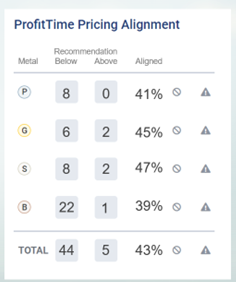 manager apparently has less interest or trust in the recommendations themselves, as evidenced by an overall alignment of 43 percent.
manager apparently has less interest or trust in the recommendations themselves, as evidenced by an overall alignment of 43 percent.
The manager’s volume-oriented pricing priority may be perfectly acceptable to the dealer, especially if it’s someone who believes you make more when you sell more.
But I would submit that a volume-focused pricing strategy ultimately means that the dealership is losing out on gross profit opportunities, especially with the Platinum and Gold vehicles that, thanks to the data science behind ProfitTime GPS’ pricing recommendations, we now know have the appeal and capability of delivering the highest ROI and gross profit potential.
Captain 3: A Great Pretender
This type of used vehicle manager is, by far, the most common that I see when I work with dealers to drive better outcomes for their used vehicle  departments. In the graphic at right, you can see the manager is pricing their best used vehicle investments, the Platinum and Gold cars, below ProfitTime GPS pricing recommendations. Meanwhile, the manager is pricing the store’s worst used vehicle investments, the Silver and Bronze vehicles, above the pricing recommendations.
departments. In the graphic at right, you can see the manager is pricing their best used vehicle investments, the Platinum and Gold cars, below ProfitTime GPS pricing recommendations. Meanwhile, the manager is pricing the store’s worst used vehicle investments, the Silver and Bronze vehicles, above the pricing recommendations.
To me, this pricing profile is potentially the most troubling. It suggests that the manager doesn’t want to face the music on the worst cars, and is cheap-selling the dealer’s best used vehicle investments to drive volume. Ultimately, this manager’s a Great Pretender—pretending that the gross on Platinum and Gold vehicles isn’t available, and pretending that they’ll get all the gross on Silver and Bronze cars, which likely wasn’t available on Day 1.
Captain 4: An On-Course Operator
I love it when I see a used vehicle manager with the type of pricing profile you see on the right. Note the overall 85 percent alignment. The manager has a 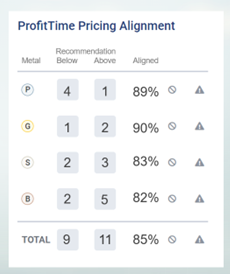 fair amount of faith and trust in the ProfitTime GPS pricing recommendations but isn’t accepting them all the time. Why? Because the manager understands that, no matter how good the data science, there are times when a manager’s discretion or specific knowledge about a vehicle can suggest a better opportunity. Across the investment categories, you can see a mix of vehicles priced above and below recommendations.
fair amount of faith and trust in the ProfitTime GPS pricing recommendations but isn’t accepting them all the time. Why? Because the manager understands that, no matter how good the data science, there are times when a manager’s discretion or specific knowledge about a vehicle can suggest a better opportunity. Across the investment categories, you can see a mix of vehicles priced above and below recommendations.
When I see this profile, I give dealers, and the manager, solid props. I view the data in the Pricing Alignment Tool as strong evidence that, on a car-by-car basis, the manager is trying to do the right thing, and achieve the optimal outcome for the dealer’s investment. In other words, the managers are steering the ship on course, as they should. I would also note that managers with this type of pricing profile also tend to have higher gross profit and sales volume averages than managers with less-balanced approaches to the way they manage used vehicle investments.
In today’s market environment, where there are plenty of cross-currents including fluctuating retail demand, wholesale values and affordability, I think it’s useful for every dealer to ask the question: Who’s my used vehicle captain and how are they steering my used vehicle department?
If my experience is any indication, dealers will be surprised when they see the answer for the first time.
The post ProfitTime GPS in Practice: Who’s Your Used Car Captain? appeared first on Dale Pollak.
A Universal Used Vehicle Problem—Inverted, Irrational Pricing 3 Feb 2023 12:34 PM (2 years ago)
Heading into NADA, I wondered how dealers would respond when they saw their used vehicle pricing presented to them through the investment-based lens that ProfitTime GPS provides.
My curiosity came from the fact that I knew every dealer who saw their pricing in ProfitTime GPS’ pricing profile would see exactly the same thing—an irrational inversion of used vehicle pricing that is causing them to sell fewer used vehicles, and make less money, than they should be achieving.
The response was as I expected. When faced with a true picture of their used vehicle pricing, and how it relates to each vehicle’s investment value, dealers had a wake-up moment. Most, if not all, were unaware the inversion existed. Many believed they were pricing their used vehicles in a more rational, investment-minded way.
Unfortunately, the used vehicle pricing irrationality is nothing new. Neither is its universal nature. I’ve been telling dealers across the country about the irrational pricing problem for more than two years, a time when my message got lost as dealer-positive market conditions masked the damage it causes.
But that’s not the case today, and the experience at 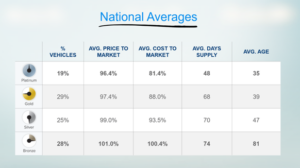 NADA affirms my belief that every dealer in the country who hasn’t invested the effort and time to eliminate the irrationality in their used vehicle pricing suffers from it today, whether they know it or not. That includes most, if not all, of you reading this post.
NADA affirms my belief that every dealer in the country who hasn’t invested the effort and time to eliminate the irrationality in their used vehicle pricing suffers from it today, whether they know it or not. That includes most, if not all, of you reading this post.
A Closer Look at the Irrationality
The irrationality surfaces when dealers view your inventory through ProfitTime GPS’ used vehicle pricing profile. The profile shows a dealer’s used vehicles categorized by the investment values (Platinum, Gold, Silver and Bronze) the system identifies for each vehicle. The profile also shows the average Cost to Market and Price to Market percentages, along with the average age of vehicles and share of inventory, for each investment value bucket.
The chart at right reveals a representative example of what every dealer sees when their inventory appears for the first time in ProfitTime GPS. The chart shows two disturbing take-aways:
Take-Away 1: As dealers, you are most proud of their worst used vehicle investments. You can see this reality by looking at the Bronze vehicles on the chart. Note: ProfitTime GPS classifies vehicles as “Bronze” because they typically have the highest Cost to Market and like-mine Market Days Supply and the least retail sales volume. The ProfitTime GPS system measures and weighs these variables for each vehicle, deriving an investment value designation.
On the chart, you can see that Bronze vehicles make up the largest share of inventory, and the vehicles have the highest average Cost to Market (100.4 percent), Price to Market (101 percent) and days in inventory (81 days) compared to vehicles in other investment segments. The upshot: You are pricing your Bronze vehicles above the current market, and they aren’t selling as quickly as they should, given their high risk/low return investment profile.
Take-Away 2: As dealers, you are cheap-selling your best used vehicle investments. Look at the Platinum vehicles, or the units ProfitTime GPS identifies as the ones with the highest ROI and profit potential. You can see the Platinum vehicles have the lowest Cost to Market (81.4 percent), Price to Market (96.4 percent) and days in inventory (35) than all the other vehicles. The upshot: You are leaving money on the table by selling your best investments for too little money too quickly.
Reasons for the Irrationality
You may be thinking: That’s not how my inventory looks. We heard the same sentiment at NADA. And, to be sure, some dealers didn’t like hearing this news. In fact, they questioned the profile’s accuracy, and ProfitTime GPS’ ability to know each vehicle’s inherent investment value.
Such concerns typically fade when you take a closer look at specific vehicles in the Bronze and Platinum buckets.
With the Bronze units, you’ll likely remember the reasons the vehicles were investment-distressed. You either paid too much money to acquire them, or the market changed, and cars you might have purchased right, and then priced too high, became problematic. With the Platinum units, you’ll have cars that you don’t feel comfortable pricing higher because they won’t get VDPs, or you’re worried that if they don’t sell fast, you’ll miss your volume goals for the used vehicle department.
But it’s not hard to understand the whys behind the used vehicle pricing inversion and irrationality. With the Bronze cars, you don’t want to take the hit on a vehicle that you probably knew, at least on some level, wouldn’t produce the gross profit you expected or wanted to see when you acquired it. Hence, the vehicle’s priced high to give it a shot to make gross. With the Platinum vehicles, your pricing reflects two things—the need to drive overall volume due to Bronze vehicles that aren’t selling, and the desire among your sales team to sell and turn vehicles that offer them the best money-making opportunities.
My question to every dealer who hasn’t yet addressed their own used vehicle pricing irrationality is this: Are you OK with what you see here?
I haven’t yet met a dealer who’s OK with the used vehicle pricing irrationality once they become aware of it. I also haven’t met a dealer who, after they’ve univerted their pricing and begun pricing each vehicle in accord to its investment value, doesn’t appreciate the superior outcomes of higher volume and average gross profit this more rational approach produces.
The post A Universal Used Vehicle Problem—Inverted, Irrational Pricing appeared first on Dale Pollak.
NADA Day 3: Factory Moves, A Stocking Problem and a Fond Farewell 31 Jan 2023 5:15 AM (2 years ago)
Several themes emerged in conversations with dealers at NADA that suggest future strain on their factory partner relationships.
Beyond the OEM efforts to push dealers to invest in electric  vehicle (EV) charging infrastructure, dealers have their eyes on how factories might compensate them for subscription-related sales of in-vehicle features and systems. An Automotive News piece published during NADA notes how General Motors intends to share future subscription revenue with dealers.
vehicle (EV) charging infrastructure, dealers have their eyes on how factories might compensate them for subscription-related sales of in-vehicle features and systems. An Automotive News piece published during NADA notes how General Motors intends to share future subscription revenue with dealers.
There’s also ongoing debate, and related legislative efforts, around the potential cost of subscription services for vehicle buyers, and the role factories and dealers can/should play in the subscription service model itself. Some view the concept as another step toward direct, factory-to-consumer vehicle sales and another risk for existing franchise laws that, at least for now, give dealers seats at the table. “That’s the thin line that keeps us in the picture,” a Southwest GM dealer shared.
It’s all worth watching close, and it signals another evolution in the multiple ways dealers may make money on the vehicles they sell long after delivery.
Speaking of factories, I was among those who wondered whether any OEMs would follow Tesla’s lead and reduce the MSRP on any of their vehicles—a recent decision that hurt dealers with used Teslas in their inventories. Two analysts shared that they expect at least some MSRP adjustments from OEMs, and perhaps more as vehicle affordability issues continue to crimp retail demand.
Other take-aways from the floor:
Stocking Right. There’s an age-old axiom in used vehicles that you can’t sell cars you don’t have in stock. I spoke with several dealers who use this rule of thumb to justify stocking more vehicles than their rolling 30-day total of retail sales. The dealers add that, in the current supply-constrained environment, they’re better off acquiring vehicles they can now, even if it means they’re over-stocked, because it won’t get any easier to acquire them down the line, when buyers are ready to purchase. I understand the perspective, but it strikes me as risky speculation, especially when all signs suggest higher-than-normal depreciation of used vehicles in the weeks ahead.
Pricing Frequency: I noticed a striking difference in the amount of time and attention dealers apply to pricing the used vehicles they currently have in stock. For example, several dealers who now use the pricing recommendations in ProfitTime GPS, shared that used vehicle pricing is now a daily discipline. They’re using the solution’s Pricing Alignment tool to address vehicle prices that, due to changing market conditions, have fallen out of alignment. Meanwhile, other dealers noted that they also look at used vehicle pricing on a daily basis, but only for units that show up in a “No Price Change in 7 Days” alert. It seems to me that, in today’s more variable market conditions, dealers should at least be examining the price of every vehicle on a daily basis to ensure its competitive position matches where you think it should be.
It’s been an incredible three days with dealers at NADA. Thank you to everyone who stopped by to say “hello,” attended my workshops, joined me for dinner and took time to check out the new innovations from vAuto and Cox Automotive. It warms my heart to feel all the love and mutual respect.
A fond farewell to Dallas, and safe travels home to all!
The post NADA Day 3: Factory Moves, A Stocking Problem and a Fond Farewell appeared first on Dale Pollak.
NADA Day 2: EVs, F&I Pressure, Stability and an Opportunity 30 Jan 2023 7:29 AM (2 years ago)
Not so long ago, some observers questioned whether dealers would want to sell and support the rise of electric vehicles (EVs) given their long-standing history and investment in selling and servicing vehicles with internal combustion engines (ICEs).
I’m not sure why anyone thought this could be the case.  From conversations with several dealers at NADA today, it’s apparent to me that dealers want to play an active role in putting, and keeping, EVs on the road. The big question, of course, is the nature of the role dealers will play in EV sales, and the requirements OEMs are putting on dealers’ shoulders to support EV sales and service.
From conversations with several dealers at NADA today, it’s apparent to me that dealers want to play an active role in putting, and keeping, EVs on the road. The big question, of course, is the nature of the role dealers will play in EV sales, and the requirements OEMs are putting on dealers’ shoulders to support EV sales and service.
A CFO from a large Southeast dealer group told me that he came to NADA with a two-pronged mission—try to figure out the smartest next step to support the group’s OEM partners as they supply a larger share of EVs, and the investments the group should make to meet the needs of vehicle buyers who want to complete at least a portion of their new/used vehicle purchases online. “Those are the two big things that are going to reshape our business,” he says.
The CFO shared another item of interest—how to spiff up service waiting areas when a growing number of customers “aren’t interested in watching TV or reading magazines.”
Here are a few other nuggets from the exhibit floor:
F&I Income: Dealers have been seeing a rise in all-cash deals over the course of the past year or more. It’s a trend analysts expect to continue due to high interest rates. Some dealers estimated all-cash deals accounted for 15 percent to 20 percent of their retail vehicle sales. The trend effectively eliminates the opportunity to book finance interest/reserve income and sell gap insurance and other products. It also makes every F&I office visit, and presentation, more important.
Vendor Stability: NADA marks the time when many dealers revisit their dealer management system (DMS) providers. I spoke with several dealers who aren’t happy with their current DMS partners. “We didn’t get what we signed up for,” the operations VP for a Florida-based group shared. The problem: The group’s current provider merged with another company, causing disruption. I asked a Southwest dealer in a similar situation if he’d consider one of the newer players in the DMS space. “No,” he told me. “We don’t want to be the pioneer who takes all the arrows. We need stability.”
Vehicle Quality Advantage: I spoke with a dealer who attended an NADA workshop that featured an analysis of online reviews for CarMax, Carvana and Vroom. The dealer said the analysis affirmed something we all know—that consumers really like a digitally enabled purchase process when it’s easy and smooth. But the analysis also apparently revealed that dealers do a better job of managing/responding to online reviews than the other companies, and dealers tend to see comparatively fewer complaints about vehicle quality, thanks to their focus on used vehicle reconditioning. “That’s an opportunity,” the dealer shared. “We don’t really tell our customers about how we recondition our cars and why.”
That’s a wrap from Day 2 at NADA here in Dallas. It’s time to get some rest and get ready for Day 3.
The post NADA Day 2: EVs, F&I Pressure, Stability and an Opportunity appeared first on Dale Pollak.
NADA Day 1: A Busy, Optimistic, Discipline-Minded Day with Dealers 28 Jan 2023 5:35 AM (2 years ago)
I’ll be taking home a new term that I learned in the first of my two workshops here at NADA—“learning journey.”
It came from a dealer during the workshop Q&A as the dealer asked for guidance on how he might lead his team on their learning journey to adopt our new strategy for  managing used vehicle inventories, Variable Management. I like the term for two reasons.
managing used vehicle inventories, Variable Management. I like the term for two reasons.
First, it acknowledges that, just like the early days of Velocity, there’s a learning curve with Variable Management. Its strategic principles call into question what have long been regarded as best practices for used vehicle management, such as giving every fresh car “a chance to make gross” or applying the same age policy to every car. Second, the term touches the reality of today’s more variable market, where change is constant and finding success is, in fact, a journey. It’s a journey that will offer plenty of valuable lessons for those willing to learn them, which is what life, and good business, is all about.
On the show floor, it was an exceptionally busy first day. I sensed that dealers were perhaps a bit more eager and hungry to gain new perspective, and investigate new solutions, than they were at last year’s NADA convention in Las Vegas. I suspect the keen interest reflects concerns about where the market’s headed in 2023, and the way the final quarter of 2022 played out, particularly for dealers who had too much inventory as used vehicle depreciation gained steam.
“We got kicked in the teeth,” the operations director for a seven-store group in the Southeast told me.
I heard a fair amount of optimism from dealers, too, including the General Manager of a Honda dealership in California: “New car inventory is coming back. Our profitability is still strong. Our used inventory’s clean and lean. I’m optimistic. Besides, if you’re all gloom and doom, isn’t that what you get?”
Here are a few other nuggets from the NADA exhibit floor that seemed worthy to share:
Discipline: Several dealers shared that they’re dusting off their inventory age policies, re-instituting the 45- or 60-day age limits they followed before the pandemic-influenced market conditions rendered inventory age largely irrelevant as used vehicle values appreciated. I shared that I respect each dealer’s rediscovered discipline, and noted that while I still believe there’s an age limit for used vehicles I no longer believe it’s the same for every car. I encouraged dealers to take a page from Variable Management, and advance a variable turn policy, wherein they should manage the days to sell for each vehicle based on its unique investment value.
Limits of software solutions: I asked a dealer who’d just purchased several new solutions for stores his group had recently acquired how the solutions might help his business. I liked his response, which showed a key understanding that software, in and of itself, can’t fix a problem. The dealer’s take: “The tools don’t fix the problem but they gives us the ability to fix a problem and manage smarter so the same problems don’t keep happening.”
Team development: I was especially encouraged by the number of dealers who told me they plan to send key members of their management teams, not just their family members, to NADA Academy to gain a deeper, more holistic understanding of the car business and dealership operations. As one dealer shared, “If I’d done this 20 years ago, I’d have the organizational bench strength I need today to continue to grow.”
That’s a wrap from Day 1 at NADA. My dogs are tired, and I’m excited to see what Day 2 will bring.
The post NADA Day 1: A Busy, Optimistic, Discipline-Minded Day with Dealers appeared first on Dale Pollak.
Super-Excited to See Dealers in Dallas for NADA 2023 25 Jan 2023 1:17 PM (2 years ago)
Like a saddle bronc in the chute, I’m chomping at the bit for this year’s NADA convention in Dallas.
As many of you know, I get excited as NADA approaches. It means I spend my days talking to dealers in person from different parts of the country, catching up,  swapping stories and talking about where the car business is headed.
swapping stories and talking about where the car business is headed.
This year’s NADA convention is no different. In particular, I’m excited to go deep with dealers on Variable Management, and why I think the time has come for them to adopt this new way of managing used vehicles—from finding inventory to appraisals to retail sales—based on each unit’s investment value. Variable Management is the focus of my NADA workshops and Cox Automotive Powerup stage presentations. I suspect it’ll also be a key thread in my discussions with dealers at the vAuto booth (#3433) on the exhibit floor.
I’m also certain that dealer conversations will address the future, and how the market will move in the months ahead. Best I can tell, 2023 will be more challenging for dealers who haven’t, or won’t, adjust their operational priorities to match expectations for higher-than-normal rates of used vehicle depreciation and the risk that retail demand for new and used vehicle sales will languish.
I’ll be especially curious to hear how dealers are planning to meet these market conditions, and how Cox Automotive and vAuto can help them achieve their goals. Like every year, I’ll have my ears on, listening for nuggets of gold and pearls of wisdom that I can share with other dealers who may not have planned as proactively or thoughtfully for the road ahead. I’ll do my best to chronicle the top take-aways in daily NADA dispatches here.
Safe travels to Dallas for everyone heading there for the convention. I look forward to seeing you and doing everything I can to help you make this year’s NADA a productive, future-minded pivot point for you/your teams to achieve greater success.
See you in the Big D!
The post Super-Excited to See Dealers in Dallas for NADA 2023 appeared first on Dale Pollak.
Inventory Write-Downs: A New Year Rite That Isn’t Right 18 Jan 2023 12:04 PM (2 years ago)
Every January, some dealers exercise their right to an annual rite—the financial write-down of used vehicle inventory they have in stock as the calendar moves from one year to the next.
This annual practice, which appears to be occurring in earnest this year, isn’t universal. For every dealer who writes down inventory, there are 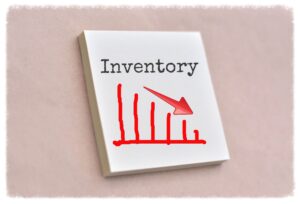 plenty who do not, because they don’t need to.
plenty who do not, because they don’t need to.
This distinction arrives as I’m seeing dealers write down six- and seven-figure sums as they aim to erase the “water” that’s built up in their inventories during the past year. The write-down practice leads to what’s known as the “13th monthly financial statement” for some dealers.
I’ve always understood the practice of writing down inventory, but I’ve never agreed with it. My thinking flows from four realities that write-downs represent:
First, the write-downs are very similar to the crash diets, new gym memberships and other resolutions we all make as the new year arrives. Trouble is, history and past practice demonstrate that if you go on a crash diet, or suddenly resolve to go to the gym, there’s a good chance it’ll be a short-lived effort. Why? Because such resolutions often lack the mental/personal discipline that’s necessary to turn watching what you eat or exercising more into your way of life, day in and day out.
Second, write-downs are wholly unnecessary. Dealers who have or will take write-downs this month typically followed a similar course—they stocked too many cars in a declining market, and they were left holding the bag at the end of the year. By contrast, other dealers applied more daily inventory management discipline. They consistently made sure their current inventory levels reflected their rolling 30-day total of retail sales. They exerted more investment-minded discipline in pricing. If they had a vehicle that showed signs of investment distress or trouble on Day 1, they priced the vehicle to move quickly. They weren’t holding out, hoping the vehicle would find a buyer willing to pay what they’re asking. Meanwhile, if they had a vehicle with high investment potential and value, they’d price the car to give it time to earn the gross profit it deserved.
Third, write-downs typically excuse the lack of inventory management discipline that spurred their need in the first place. Consider the “13th monthly financial statement” dealers create when they write down inventory to start a year. By design, the statement restates the prior year’s performance, often for the worse. The effect: Monthly results in the past year are now overstated, meaning dealers paid commissions and gave other rewards based on performance that wasn’t as good as they thought.
Finally, write-downs take some of the bloom off a new year. They amount to adjusting to, and apologizing for, past sins. By contrast, dealers who do not need to write down their inventories can focus their new year energy, and related resolutions, on more positive, forward-looking initiatives to help them find greater success in the months ahead.
Looking back, it’s somewhat understandable why this year’s season of-write downs seems more sizable. 2022 marked a year of significant transition in the used vehicle market—ever-more variable conditions that are likely to remain (and evolve more) in the year ahead. Some dealers simply missed the boat, and the size of their write-downs reflects the degree of individual misses.
It’s my sincere hope that, by this time next year, fewer dealers will find themselves in a position where they need write-downs to make their inventories right, once again.
The post Inventory Write-Downs: A New Year Rite That Isn’t Right appeared first on Dale Pollak.
An Ongoing Gross Deception That’s Growing—Moving Cars Between Stores 13 Jan 2023 7:22 AM (2 years ago)
I’m seeing a correlation between the current and pre-pandemic market in the way dealers with multiple rooftops are managing their used vehicle inventories.
Back in 2019 and earlier, dealers with multiple stores would, to varying degrees of frequency, move retail units that weren’t selling at one store to a different store in their group. When I talked to dealers about this practice, I questioned what they were doing. I’d ask whether such moves made sense financially. After all, the vehicles they transferred often were distressed and aged units that hadn’t moved.
to a different store in their group. When I talked to dealers about this practice, I questioned what they were doing. I’d ask whether such moves made sense financially. After all, the vehicles they transferred often were distressed and aged units that hadn’t moved.
I’d explain that the vehicles didn’t sell at the first store because a manager either didn’t know where to price the vehicle to sell or refused to price it where it would sell. I’d also note that when vehicle moved to a different store, the manager was effectively off the hook for failing to turn the dealer’s investment.
Some dealers would take issue with my position. They’d note that, before a vehicle would get transferred, the manager would need to “write down” the vehicle, enabling the receiving store to acquire the vehicle for the right money. Hence, the manager wasn’t off the hook; the manager’s department took a hit.
But we all know how write-downs work. It’s an accounting move that effectively washes out the management failure that resulted in the vehicle not selling in the first place. On top of that, the manager could, if inclined, use other cars to make the effects of the write down effectively disappear.
It’s curious to me that I’m seeing this practice return in recent weeks. I can’t recall conversations about store-to-store transfers over the course of the past two years. Why? Because dealer-favorable conditions meant that if you had a vehicle to sell, it sold. We all understand how those conditions have shifted and the retail market’s more challenging, especially for dealers with too many vehicles in stock in relation to their rolling 30-day total of retail sales.
That’s what makes me concerned as I hear dealers today talk about moving more cars between stores. It doesn’t matter to me that dealers are still making relatively strong profits in their used vehicle departments. The financial fundamentals of moving vehicles you’ve reconditioned and tried to retail at one store to another store still don’t add up. If a vehicle gets 45 or 60 days to retail at one store, and then another 30 to 45 days at a second store, the dealer’s investment is tied up for upwards of 80 to 90 days without turning. How can this be acceptable?
The answer is, “it isn’t.” In fact, I’d put this practice among other gross deceptions I wrote about in my 2020 book, “Gross Deception: A Tale of Shifting Markets, Shrinking Margins and the New Truth of Used Vehicle Profitability.”
If it were my dealer group, I wouldn’t allow store-to-store transfers of vehicles if a manager at the store that landed the vehicle made the decision to recondition and retail it. Why? Because I believe the primary job of every used vehicle manager is to make money on every used vehicle investment, not just the ones that come easy. For sure, the manager might fall short on occasion. But I see no reason to give managers the equivalent of a hall pass if/when they fall short.
To be clear, I’m not opposed to dealers moving a vehicle from one store to another, provided such transfers occur at the time of acquisition, when market- and store-level performance data clearly indicate a better retail outcome at another store. When this occurs, the manager is doing right by the dealer’s money. He/she is figuring out the best location to achieve the most-optimal outcome for the dealer’s investment.
If the transfer decision comes later, after a manager has invested additional reconditioning dollars and tries to retail a vehicle, he/she should own the responsibility for the car and the less-optimal return of the dealer’s investment that occurred on their watch. If dealers don’t hold managers accountable to this standard, the gross deception will only continue.
The post An Ongoing Gross Deception That’s Growing—Moving Cars Between Stores appeared first on Dale Pollak.
A New Reality in 2023: More Variability in the Used Vehicle Market 16 Dec 2022 8:02 AM (2 years ago)
It’s fair to say that many dealers experienced and saw things in used vehicles during the past year that ran counter to traditional wisdom.
In the early part of 2022, we saw a continuation of the used vehicle value appreciation that turned 2021 into one of the most profitable years for dealers that many of us have ever seen. As summer turned to spring, used vehicle depreciation returned and the rate of depreciation picked up.
But the depreciation was different than it had been in  the past. Dealers may well remember how the values of some cars seemed to almost fall off a cliff, while others appeared to hold their values.
the past. Dealers may well remember how the values of some cars seemed to almost fall off a cliff, while others appeared to hold their values.
Meanwhile, I was like many dealers—keeping a careful eye on how used vehicle depreciation would affect dealers’ retail asking prices. For much of the history of the car business, retail prices followed the wholesale market. When wholesale values go up, retail prices rise; when wholesale values diminish, retail prices soften.
But it took several months before we saw retail prices reflect their traditional symbiotic relationship with the wholesale market. It was striking how, through the summer and early fall, retail prices remained resilient. The dynamic shifted, though, as fall turned to winter. Today, dealers are now experiencing a more rapid rate of retail price softening, and some analysts suggest retail prices will decline even more rapidly in 2023.
What does this all mean? My take is that, thanks to all the disruption we’ve seen in the past two years due to COVID-19, a fall-off in new vehicle production, limited supply of used vehicles and the more-recent rise of inflationary forces, is that the used vehicle market itself has changed. In the past, one could talk about the used vehicle market as if it were unified. We used to see wholesale depreciation occur at almost consistent rates across all cars. Similarly, retail price dynamics tended to move in more or less the same fashion.
In my conversation with dealers, I’ve noted that we no longer have a singular, unified used vehicle “market,” per se. Instead, we’ve got a far more fragmented used vehicle market that’s effectively made up of multiple markets, wherein specific types of vehicles and segments, in specific parts of the country, move and stand on their own. In sum, today’s used vehicle “market” has a lot more variability than it ever did in the past.
I share this backdrop because it serves as a precursor to an even greater level of variability that I believe dealers will see in 2023.
Here’s my thinking: All the variability in the used vehicle market that’s occurred in the past two years has largely happened in the absence of new vehicles and factory incentives. Indeed, limited supplies of new vehicles helped spur the used vehicle variability. Retail demand for used vehicles has remained surprisingly strong due to the absence or inability of some consumers to purchase a new vehicle.
But as we close out 2022, we’re seeing higher supplies of new vehicles on dealer lots. A recent Cox Automotive report notes that the average days supply of new vehicles hit 53 days in November—71 percent higher than November 2021. To be sure, the current supply of new vehicles is nowhere near the pre-pandemic level of an 83-days supply at this time of year. Further, the days supply of new vehicles is entirely dependent on the brand. The Cox Automotive report notes that import brands like Toyota and Kia are running with less than 30 days supply. Meanwhile, domestic brands are in better shape overall. The report notes that Buick has more than a 120-day supply of new vehicles.
The ever-growing build-up of new vehicle inventory is occurring as retail demand for new vehicles faces affordability pressures. Analysts point to average listing prices of more than $46,800 and rising interest rates as two reasons would-be new vehicle buyers can’t purchase the cars they might want.
At the same time, we’re hearing some calls from dealers for their factory partners to bring back incentive spending that, in the years prior to the pandemic, helped propel the industry to record-setting levels of new vehicle sales volumes. So far, manufacturers haven’t really opened the purse strings on incentives, at least compared to historical incentive spending levels.
But I’m among those who believe it’s reasonable to expect OEMs, especially those currently blessed with higher days supplies of new vehicles, to resume incentive spending in 2023. They may not put as much money on vehicles as they did in the past, but multiple signs suggest that, as 2023 unfolds, automotive manufacturers will need to juice the retail market.
If/when incentive spending picks up, we can expect a ripple effect in the used vehicle market. As OEMs put incentives on 2023 models, the values of one-, two- and three-year-old vehicles will inevitably decline.
Such are the reasons I believe dealers should prepare for more variability in the used vehicle market in the year ahead. Not every OEM will need to put incentives on their vehicles, and you can bet any new incentives won’t arrive at the same time, or in the same amounts, across new vehicle brands.
Given this disparate, fragmented environment, it’ll be ever-more important for dealers to adopt the principles of Variable Management for used vehicles. You simply won’t see optimal results if you’re applying a singular strategy to managing your used vehicle inventories. In this more variable environment, it’ll be imperative that dealers understand each vehicle’s ROI and profit potential, and price their vehicles accordingly.
If you don’t, chances are good you’ll be leaving money on the table or taking deeper losses on vehicles you retail more often than you should.
The post A New Reality in 2023: More Variability in the Used Vehicle Market appeared first on Dale Pollak.
A Return of Margin Compression? Yes, But Not Necessarily 9 Dec 2022 12:01 PM (2 years ago)
I’ve been struck by how often the term “margin compression” has come up in recent conversations with dealers.
Interestingly, dealers aren’t necessarily complaining about margin compression. It’s more accurate to say they’re starting to notice it in their used vehicle operations.  Just this week, for example, two different dealers shared a surprisingly similar story: A few short months ago, their front-end gross profit average was about $3,200. Today, it’s about $2,800, and both expect it to continue to contract.
Just this week, for example, two different dealers shared a surprisingly similar story: A few short months ago, their front-end gross profit average was about $3,200. Today, it’s about $2,800, and both expect it to continue to contract.
I suspect dealers aren’t complaining about margin compression because the market dynamics we’re seeing right now don’t necessarily correlate to the margin compression many dealers faced prior to the COVID-19 pandemic. Back then, dealers were selling record volumes of used vehicles, and making $14 in net profit per used vehicle retailed, according to NADA. Most dealers were happy if their front-end gross profit average landed between $1,300 and $1,500/vehicle.
The current moment might best be described as an essentially definitive end to the margin-rich environment dealers enjoyed the past two years. Retail prices are starting to come down from their historic highs, almost in line with current rates of used vehicle depreciation. Further, analysts expect the trends to continue, with some suggesting retail price and wholesale value declines might fall steeply compared to historic norms.
But I must also add that the effect of margin compression, and its material impact on used vehicle performance and profitability, isn’t like the margin compression dealers dealt with in previous years. I’d submit the current flavor has two important distinctions.
The first distinction is that market forces that drive margin compression no longer affect all used vehicles equally. Think back to this past summer, when depreciation resumed in earnest. While the overall rate of depreciation was high, some cars were hit harder than others. The differences owed to the supply/demand characteristics of different vehicle segments, model years and other factors. We still have supply/demand imbalances in the used vehicle market and where those imbalances occur, the effects of margin compression will vary.
The second distinction is that margin compression isn’t affecting every dealer equally. Based on my conversations with dealers and reviews of their used vehicle performance, dealers with a lot of older, now-distressed vehicles face a steeper degree of margin compression than dealers who have diligently right-sized their inventories to retail demand and remain focused on turning each vehicle in a time appropriate to its investment value. Some of the more market-efficient dealers report they haven’t seen much softening of their front-end gross profit averages at all—an advantage that speaks to the benefit of operating with the current market always in mind.
As I talk with dealers about margin compression, I’ll make another important point: If you attack the operational reasons your margins may be on the decline today, you’ll have less to complain or worry about if/when the pace of margin compression picks up.
The post A Return of Margin Compression? Yes, But Not Necessarily appeared first on Dale Pollak.
ProfitTime GPS in Practice: A Big Difference Between Two Dealer Groups 7 Dec 2022 6:57 AM (2 years ago)
I’ve been talking to a lot of dealers lately about how they’re doing in used vehicles. Often, I’m in these conversations because a dealer’s become convinced that vAuto’s new inventory management solution, ProfitTime GPS, is causing a performance problem.
Naturally, the starting point of every conversation is ProfitTime GPS. I’ll call up a dealer’s inventory, and study what the metrics tell me about how a dealer and their team is managing used vehicles to achieve optimal ROI outcomes. Sometimes, I’ll show a dealer  how their performance compares to peers who have similar franchises, market areas and rooftops.
how their performance compares to peers who have similar franchises, market areas and rooftops.
The other day, this exercise led me to a telling tale of two very similar dealer groups:
Both groups have about 30 stores, with similar franchise mixes across a similar mix of metro and suburban markets.
They sell essentially the same number of used vehicles in a rolling 30-day period, across a similar mix of metro and suburban markets in different parts of the country.
The overall pricing of their used vehicles looks about the same—one group’s inventory has a Price to Market percentage of 97 percent, the other, 95 percent.
The overall Cost to Market percentages for each group’s inventory runs about the same, 87 percent and 84 percent.
From this high-level view, you could reasonably presume that both groups should be achieving roughly the same outcomes. After all, there’s an apparent parity across the inventory-level metrics, and they’re selling the same volumes of used vehicles.
But this view doesn’t inform how well either group is managing their used vehicle investments to achieve optimal ROI outcomes. And, with the help of ProfitTime GPS, we can see that there’s actually very little parity between the two groups in terms of their ability to maximize the money they could make in used vehicles:
Overall inventory investment. One group has roughly $80 million in used vehicle inventory, while the other has $46 million. The latter group’s overall stocking levels effectively match their rolling 30-day total of retail sales; the former group has almost 1,000 vehicles more than their rolling 30-day total of retail sales.
Total mark-up or profit potential (e.g., a measurement of the spread, in dollars, between the Cost to Market and Price to Market percentages of vehicles). The group with $80 million in inventory has an overall mark-up of $1.9 million, while the group with $46 million has $4.4 million in mark-up.
At this stage of the analysis, I had to ask myself: How is it possible that both groups are selling the same volume of vehicles with such dramatic differences in the number of cars they stock, and the profit potential their vehicles possess? I found the answer by examining the mix of pricing decisions each group makes on a day to day basis with their vehicles:
Pricing alignment. The group with $80 million in inventory aligns its prices to ProfitTime GPS recommendations about 56 percent of the time. The group tends to price Platinum cars (the vehicles ProfitTime GPS designates as the best investments) too low, and Bronze vehicles (the vehicles with the least investment value) too high. Meanwhile, the group with $46 million in inventory aligns its prices to recommendations about 75 percent of the time. Pricing exceptions go above and below recommendations, across ProfitTime GPS’ Platinum, Gold, Silver and Bronze investment categories.
Share of distressed inventory. About 45 percent of the inventory at the group with $80 million in inventory represents Bronze vehicles. The share of Bronze vehicles is 29 percent at the group with $46 million in inventory. It’s difficult to say if the former group’s share of Bronze vehicles represents a sourcing problem. But I can say this: Some of the vehicles likely turned Bronze over time and should have been priced differently from Day 1.
For me, the analysis offers three key lessons that are relevant for every dealer, particularly those who, like the group with $80 million in inventory, have too many cars in stock for current market conditions.
First, and perhaps most important, is the lesson that, if you’re like the group with $46 million in inventory, and you strive to properly price each vehicle to optimize its turn and ROI, you don’t need to stock more vehicles than your rolling 30-day total of retail sales. It’s quite striking to see two different groups selling the same number of cars, knowing one group does the job with half the inventory investment and twice as much profit potential. For me, the $80 million group’s additional investment not only represents a poor use of capital. It’s also an open invitation for inventory age and water.
Second, the group with $80 million in inventory would be better off if they took a page from their peer and priced more vehicles in alignment with ProfitTime GPS recommendations. The group’s out-size share of Bronze vehicles likely owes to consistently pricing the vehicles above the market, and the group’s volume likely comes from cheap-selling Platinum vehicles. This duality is common in the current market, and it’s leading to less-than-ideal and unnecessary outcomes.
The third lesson is that dealers who aren’t disciplined about maintaining a balance between their retail sales and stocking levels, and fail to mind each vehicle’s inherent investment value when pricing, will end up like the group with $80 million in inventory—selling a lot of vehicles but failing to make all the money they can and should.
The post ProfitTime GPS in Practice: A Big Difference Between Two Dealer Groups appeared first on Dale Pollak.
Emerging Pressure Points on Used Vehicle Profitability 30 Nov 2022 9:37 AM (2 years ago)
As dealers are getting ready to close out 2022, some are seeing two trendlines in their used vehicle performance that give them pause.
The first trendline relates to front-end gross profit. Anecdotally, I’m hearing that average front-end grosses have largely been on the decline since the early part 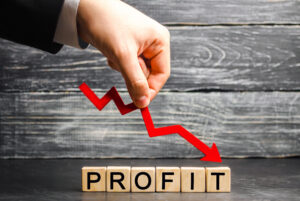 of the summer. That’s when depreciation returned to used vehicles and retail demand started to show signs of softening.
of the summer. That’s when depreciation returned to used vehicles and retail demand started to show signs of softening.
Overall, front-end grosses appear to be running north of $2,000 at many dealerships—a figure that’s several hundred dollars below the averages dealers achieved earlier in the year and through much of 2021. In its 2022 third-quarter earnings release, public dealer group Autonation reported its front-end gross profit in used vehicles at $1,870/car, down 11 percent from the same time in 2021. Compared to the average front-end gross profit dealers achieved in pre-pandemic years, the current front-end gross averages look pretty good, if not great.
The second trendline relates to the net profit dealers achieve in used vehicles. Just like the front-end gross average, the retail net profit per used vehicle retailed also appears to be on the wane. Here again, the average net profit isn’t terribly bad in comparison to earlier years. I remember when NADA reported the average retail net profit per used vehicle retailed was -$2/car at the end of 2017. At the end of 2021, this figure ran nearly $1,200. Today, I understand the average retail net profit per used vehicle retailed is less than $1,000, and trending lower.
When I ask dealers about the trends, the net profit piece tends to drive the discussions. After all, it’s the net profit that ultimately determines how much money you make when you’ve sold a used car.
Part of the pressure on used vehicle net profit comes directly from the economic environment in which dealers are operating. Inflation is pushing up the cost of pretty much everything—from the people on your teams to the various advertising, rent and other expenses dealers typically charge to their used vehicle departments.
With this backdrop, you could make the case that a decline in used vehicle net profit should be expected and, perhaps, may be unavoidable. I can agree with this assessment, but only up to a point.
Here’s why: For the past several months, I’ve been seeing, and writing about, the rising numbers of distressed cars in dealers’ used vehicle inventories. These are vehicles dealers paid top-dollar to acquire, priced to maximize gross profit and have yet to sell. In many cases, dealers have not been willing to face, or take, the losses associated with these vehicles when they retail. As dealers reckon with these cars, the used vehicle department’s front-end gross and net profit averages tend to suffer.
The problem is even more profound for dealers who floorplan their used vehicle inventories. Floorplan interest expense has nearly doubled in the past year—a rising cost that creates a double-whammy for dealers who aren’t retailing distressed vehicles as fast as they should.
In light of these circumstances, I’ve been emphasizing two operational disciplines in my discussions with dealers to help them set a solid course for the coming year.
The first is to right-size your inventory to your rolling 30-day total of retail sales. This discipline minimizes the drain on front-end gross and net profit that inevitably follows stocking too many vehicles for current market conditions. Across the country, the average days supply of used vehicles has been hovering close to 50 days for much of the year—a level that’s too high given retail demand trends in many markets.
The second discipline is to do the right thing with every car the minute you own it. Much of the rise of distressed inventory owes to dealers trying to make gross on cars that don’t deserve it. In turn, we find the same dealers cheap-selling their best cars to make up for volume lost to distressed units that aren’t selling.
The good news: Today’s technology and tools, like ProfitTime GPS, help dealers identify the turners and earners in their inventories, and everything in between. When you have this knowledge, and recommendations on how to optimally price every car, the negative net profit impacts of more difficult market conditions and rising expenses become less extreme.
The post Emerging Pressure Points on Used Vehicle Profitability appeared first on Dale Pollak.
A Persistent, Two-Pronged Used Vehicle Pricing Problem 4 Nov 2022 12:39 PM (2 years ago)
I’m seeing it day after day. At almost every dealership. It’s what can only be described as a problematic, two-pronged pricing problem.
I’ll dig into the problem in a moment.
But first, I must share that the seemingly almost-universal nature of the pricing problem affirms an understanding about car dealers I’ve carried for years. The understanding’s based on observations of my own behavior as a dealer, and what I see with other dealers.
Here it is: As a group, we do not respond well to times of market transition. We often don’t see the early signs of market transition and, when they become even more apparent, we don’t make any proactive moves. Rather, we tend to wait until the market transition’s fully underway, and then pay a price as we try to catch up.
That’s effectively the backdrop for the two-pronged pricing problem in the present market transition.
On the right, I have shared an example of the Pricing 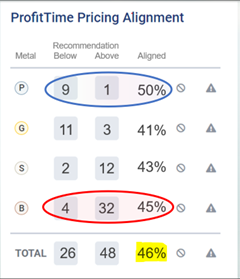 Alignment box from ProfitTime GPS. The box shows how much a dealer’s current retail prices align with the price range recommendations ProfitTime GPS offers. (Note: ProfitTime GPS recommendations use data science to help dealers optimize each vehicle’s ROI according to each unit’s unique investment value. Practically speaking, the system recommends urgency for a dealer’s most-troubled vehicles (the Bronze cars), and patience with the highest-value vehicles (the Platinum cars).
Alignment box from ProfitTime GPS. The box shows how much a dealer’s current retail prices align with the price range recommendations ProfitTime GPS offers. (Note: ProfitTime GPS recommendations use data science to help dealers optimize each vehicle’s ROI according to each unit’s unique investment value. Practically speaking, the system recommends urgency for a dealer’s most-troubled vehicles (the Bronze cars), and patience with the highest-value vehicles (the Platinum cars).
The Pricing Alignment box here mirrors the data I see almost every day at almost every dealership. Note the dealer’s overall alignment (highlighted)—46 percent. I read this percentage as a sign that there isn’t much collective faith in ProfitTime GPS’ recommendations. More than half the time, someone in the dealership believes they know best how to price their vehicles.
Now, let’s examine the most prominent prongs of the pricing problem.
Bronze Vehicles: You can see the dealer’s Bronze vehicles (red oval) represent almost half of the dealer’s total used vehicle inventory. Generally speaking, the share of Bronze vehicles has been on the rise for dealers because asking prices are too high, the vehicles aren’t selling and depreciation is eating away at whatever profit potential they may still hold—a topic I addressed in a previous post.
In this case, the vast majority of the dealer’s Bronze vehicles (32 vehicles) are priced above ProfitTime GPS recommendations. (The same is also true for the dealer’s Silver cars, which hold a slightly higher ROI potential than Bronze units.)
When I ask dealers about the pricing of their Bronze vehicles, and the apparent practice of pricing their worst investments most proudly, many don’t have an answer. Some may say they’re simply trying to get gross on cars that cost a lot to acquire. My take: Irrespective of how or why the vehicles became Bronze cars, we can all agree the current pricing alignment represents a problem—one that’s not likely to get better over time.
Platinum Vehicles: Like many if not most dealers, Platinum cars (blue oval) at this dealership represent a smaller share of the overall used inventory, about 14 percent. You can see the dealer’s priced all but one of their Platinum vehicles below the ProfitTime GPS recommendations.
Generally speaking, when I ask dealers why they price Platinum vehicles below system recommendations, the responses reflect a belief that, if they ask all the money for these vehicles as ProfitTime GPS recommends, they won’t get any Vehicle Details Page (VDP) views, or third-party sites might deem/designate the asking price as “too high” for shoppers.
Here’s the explanation the GM at a Detroit-area dealership recently offered: “People believe CarGurus. If they says it’s good deal, it’s a good deal. If they say it’s great deal, it’s a great deal. If it’s a fair deal, it’s a fair deal. But if they say my car’s over-priced, no one is going to click.”
The GM’s concern is understandable, but it also doesn’t hold water.
Across the country, I’m seeing dealers price Platinum vehicles up to the price points ProfitTime GPS recommends. Guess what? The cars don’t get as many VDPs as other units, and they still sell fast. How can this be? Well, the Platinum vehicles are blessed with low Market Days Supply, high retail volume and dealers own them really right. Sales associates are incentivized to sell them, because they recognize a good gross profit opportunities. Overall, Platinum cars require fewer online looks, because they’re in-demand cars that buyers will search to find and purchase when they do.
Now, let’s all step back from the dealer’s Pricing Alignment particulars, and ask ourselves, “What’s really going on here?”
It seems to me the answer rests with beliefs and behaviors dealers and used vehicle managers bring to their jobs every day. They know they have a large share of now-aged and -distressed inventory (the Bronze units) that isn’t selling. They also don’t want to face the music on these vehicles, which is why they’re consistently priced too high.
Meanwhile, because the dealer’s like everyone else and wants to sell as many vehicles as possible in any given month, they are cheap-selling their best inventory (the Platinum units) to turn these cars faster and make up volume lost due to the slow-selling Bronze vehicles.
My guidance to dealers is you don’t have to operate this way when you have the right technology and tools to distinguish the earners, turners and everything else in your inventory. You can now more consistently and easily make the most investment-optimal decisions with every car. Best of all, you’ll be more sure-footed with the cars you have in stock, and their prices, the next time the market turns.
The post A Persistent, Two-Pronged Used Vehicle Pricing Problem appeared first on Dale Pollak.
A Parallel Between Baseball and ProfitTime GPS 2 Nov 2022 11:51 AM (2 years ago)
‘Tis the season to be thinking about baseball. Here in Texas, a lot of people are hoping the Houston Astros live up to their potential as 2022 World Series favorites.
During a recent postseason game, the announcers talked about how data science has changed the game. They mentioned a decision by Major League Baseball to ban teams from shifting players to defensive positions where, according to data science, an opposing hitter is most likely to put the ball.
about how data science has changed the game. They mentioned a decision by Major League Baseball to ban teams from shifting players to defensive positions where, according to data science, an opposing hitter is most likely to put the ball.
At the time, the book inspired the data-gathering and metrics we built into vAuto’s Provision system. Today, I think it’s fair to say the development helped dealers change the way they manage used vehicles for the better. I still hear from dealers whose used vehicle performance and profits took off more than a decade ago, ushering in a new level of operational success they’ve now come to expect.
Of course, Lewis’ book also inspired baseball teams at all levels to bring more data into their decision-making. These days, batters study data on pitchers to understand what their next pitch might be and where it’ll be located. Same for the defensive shifts noted above.
Broadly speaking, the data science that drives baseball decision-making has come a long way in the past nearly two decades—a fact that almost directly parallels the advance of data science in used vehicle decision-making.
One of Lewis’ central premises is that, without the benefit of performance data, the beliefs and biases individual managers might bring with them to the dugout can produce inconsistent results. Because of how they think, and they’ve been trained to think, they also might miss opportunities that would be evident if they had the ability to see them.
The same is true in used vehicles. Now that we have deep data science built into ProfitTime GPS, and dealers can understand each vehicle’s probability of sale at any price and ROI potential on Day 1, they are finding new opportunities to improve used vehicle sales and gross that they didn’t see before.
A Southwest Honda store recently summed the dynamic this way: “ProfitTime GPS helped me find gross I didn’t know was there.” Meanwhile, a Midwest dealer recently shared, “We’ve always had turners and earners in our inventory, now I know which ones are which.”
To be sure, some purists decry the advent of data science in baseball. They still believe that a smart manager, playing hunches and instinct, can succeed. Here again, the same is true in used vehicles. I hear the same criticisms about data science from dealers—that it can’t be trusted and it’ll never replace the heart and soul of a smart used vehicle manager.
When this occurs, I reiterate a point I’ve been making for the entirety of my career with vAuto and Cox Automotive: The data and tools we’ve developed, and the performance that results from their application, are only as good as the individuals who ultimately make the decisions.
The post A Parallel Between Baseball and ProfitTime GPS appeared first on Dale Pollak.
ProfitTime GPS in Practice: A Closer Look at a Bronze Car Problem 26 Oct 2022 5:49 AM (2 years ago)
Across the country, the share of distressed vehicles in dealer inventories is rising.
On the surface, a rise in the number of distressed vehicles in a single dealer’s inventory isn’t necessarily alarming. But since they dynamic seems to be happening for  almost every dealer, it’s worth taking a closer look here to understand why dealers have more distressed cars today than they did just a few short months ago and what they should do about them.
almost every dealer, it’s worth taking a closer look here to understand why dealers have more distressed cars today than they did just a few short months ago and what they should do about them.
A quick context-setter: vAuto’s ProfitTime GPS system readily identifies distressed inventory as Bronze vehicles, the ones that have the highest Market Days Supply, the highest Cost to Market and the least retail sales volume compared to other vehicles. ProfitTime GPS ranks all inventory based on its investment potential, using Platinum, Gold, Silver and Bronze designations. On this scale, Bronze vehicles offer the least ROI/profit potential.
It’s also important for everyone to understand that the share of Bronze vehicles in a dealer’s inventory depends on the dealer. If a dealer’s most focused on volume, then they may have a higher share of Bronze vehicles than dealers who put a high priority on gross profit. Why? Because the volume dealer’s might pay more to acquire a sufficient volume of vehicles to meet their sales targets, whereas the gross-minded dealer might be more selective about cars to acquire, and pickier about how much to pay, for the sake of maximizing gross profit. In this simplified scenario, the volume-minded dealer’s inventory may have a higher overall Cost to Market average and, as a result, a higher share of Bronze vehicles.
But this generalization doesn’t necessarily fit the circumstances I’m seeing on the ground right now in dealer inventories across the country. It almost doesn’t matter if a dealer’s focused on volume, gross or a balance between both. Bronze cars appear to be more plentiful for almost every dealer than they have been in the past.
To understand this condition, I’ve been noting the characteristics of Bronze vehicles in my daily conversations with ProfitTime GPS dealers. Here are some common threads:
- Many of the Bronze vehicles are priced too high. Given their opportunity/risk profile, dealers should be pricing Bronze vehicles to move quickly. Yet, time and time again, the average Price to Market percentage of Bronze vehicles is at/near 100 percent. Often, the dealers own these vehicles at Cost to Market percentages of 98 percent or higher.
- Many of the Bronze vehicles are older than 30 days. Generally speaking, I advocate that dealers strive to retail Bronze vehicles in 20 days or less to minimize the risks these lower-tier investments possess, and optimize whatever ROI each unit can deliver. Last week, I spoke with a Midwest BMW dealer where more than 50 percent of the dealer’s Bronze vehicles were older than 45 days—a fairly common condition.
- A fair number of the Bronze vehicles didn’t start out as Bronze. On several occasions, I’ve shown dealers how their Bronze vehicles started as Silver or Gold investments, often purchased through trade-ins and off-street channels. (You can spot this dynamic through the Global Acquisition dashboard in ProfitTime GPS.) But over time in inventory, the initial investment values of the vehicles weakened, and now they appear as Bronze units.
When I review the characteristics of Bronze vehicles with dealers, it’s often a wake-up call to current market conditions. The rise of Bronze vehicles owes directly to the higher-than-usual rates of value depreciation we’ve seen in recent weeks. Dealers are often surprised to see that off-street purchases and trade-ins they believed they bought right a few weeks ago no longer offer the profit/ROI potential they once did. The rise of Bronze vehicles also owes, at least in part, to slightly softer retail demand dealers report across the country.
But you can’t pin the rise of Bronze vehicles solely on less-favorable market conditions. Their increased prevalence in recent weeks also ties directly to dealer performance. We see the evidence in ProfitTime GPS. The system recommends retail pricing for every vehicle. The alignment of current dealer asking prices to ProfitTime GPS recommendations often runs less than 40 percent for Bronze vehicles. This finding suggests dealers are choosing to override or reject recommendations that are purpose-built to move the cars more quickly because of their high risk/low return profile.
At this point in my dealer conversations, dealers begin to recognize they need to address the prevalence of Bronze vehicles. Here are three things I recommend to help them mitigate the pain the Bronze vehicles will inevitably bring to their used vehicle department profitability and sales volume:
- Adjust retail asking prices to reflect where Bronze vehicles will transact. There are a host of reasons many dealers price Bronze vehicles at/near 100 percent of the market. If you own a vehicle for a Cost to Market percentage of 97 or 98 percent, you deserve a chance to make at least some money, right? Well, the reality is that if you play this card, you’ll likely end up holding the cars and discounting prices until your price reflects the place would-be buyers take notice. Generally speaking, in dealerships where Bronze vehicles are selling in less than 20 days, the average Price to Market percentage is at/near 95 percent. When dealers have Bronze vehicles priced at or above 100 percent of the market, there’s no real mystery why the vehicles aren’t selling.
- Attack the most-distressed, oldest vehicles first. While I firmly believe dealers should aim to retail every Bronze vehicle as quickly as possible, I recognize that reducing prices on an ever-larger share of a dealer’s inventory right away might create more pain than a used vehicle manager’s paycheck (and heart health) can handle right now. The next-best approach is to attack the cars that have been in your inventory the longest. The end goal: Work your way to more transaction-realistic pricing for all of your Bronze inventory. It’s important for dealers to remember that these cars won’t get better over time, especially in a depreciating market like we’re seeing now.
- Be more diligent about pricing Bronze vehicles right on Day 1. While its understandable dealers and used vehicle managers don’t want to face the music when they take in a Bronze vehicle, it’s not rational. We all know these vehicles represent high risk/low reward investments. We also know that the vehicles won’t get better over time, especially in a depreciating market. When dealers handle Bronze vehicles correctly, they rightfully understand that while the cars may not offer the front-end gross profit they’d like to see, the cars represent volume units that drive F&I gross and customer/trade-in acquisition opportunities.
Overall, it’s important for dealers to remember there is no shame in having Bronze vehicles in your inventory. They are a fact of life in today’s used vehicle market and every dealer’s inventory. They’ll also be a fact of life in tomorrow’s market, too.
But there is shame in not treating these vehicles for what they are the minute you own them, and pretending they’ll command a gross profit that, for all intents and purposes, will never arrive.
Editor’s note: In an upcoming post, I’ll share a different problem I’ve been encountering with vehicles ProfitTime GPS regards as a dealer’s best investments, the Platinum cars.
The post ProfitTime GPS in Practice: A Closer Look at a Bronze Car Problem appeared first on Dale Pollak.
ProfitTime GPS in Practice: “Fishing Where the Fish Are” 13 Oct 2022 6:46 AM (2 years ago)
A little more than 60 days ago, when Gettel Automotive in Bradenton, FL, began using ProfitTime GPS in earnest, Kurt Fisher, director of pre-owned operations for the 18-store group, knew he’d have work to do.
“It’s the same every time you first turn it on at a store,” Fisher  says. “There’s an inversion. Your Platinum cars were priced too low, and all the Bronze cars are priced too high. Our goal now is to balance it as much as possible.”
says. “There’s an inversion. Your Platinum cars were priced too low, and all the Bronze cars are priced too high. Our goal now is to balance it as much as possible.”
He’s referring to the investment value lens ProfitTime GPS provides for every vehicle. The system distills a swath of data—including a vehicle’s Cost to Market, Market Days Supply, retail sales volume, past history, and more—to identify and score where the vehicle’s investment value ranks on a Platinum, Gold, Silver and Bronze scale, and recommend the appropriate price for a vehicle based on the ranking.
Fisher’s balancing effort also began as a slowdown in the retail and wholesale markets for used vehicles seemed to be getting worse. Indeed, Cox Automotive data shows that wholesale values overall declined almost 2 percent in September, and analysts estimate retail sales declined 8 percent from August performance, and are down 10 percent year-over-year.
For Fisher and Gettel, these conditions spurred what might be considered an attack mode. They used ProfitTime GPS to right-size the retail pricing for their inventory to retail out of the investment-distressed vehicles rather than sending them to auction and “losing money,” Fisher explains.
But the effort to align and balance prices to ProfitTime GPS recommendations produced some unexpected, if not surprising outcomes.
In the case of Platinum vehicles, the system would recommend higher prices. Fisher’s team members questioned the system’s sanity: “They’d call me and say, ‘The system told me to mark this car up $5,000 and I’ve had it for 60 days and this is crazy. Why are we doing this?’ The next day, they’ll call me and say, ‘Guess what? Somebody bought the car last night and it sold.’”
Meanwhile, with Bronze vehicles, ProfitTime GPS generally recommended that Fisher and his team face the music on cars that were priced too high and held too long to produce the gross profit outcomes they initially expected. But there were also plenty of instances where “we had the cars priced too low and we’re being too aggressive,” Fisher says. After they raised the prices to align with recommendations, the vehicles sold.
The experience led Fisher to an analogy that isn’t surprising given he lives and works in Florida: “I tell my guys, ‘we’re going fishing. If you hire a captain to take you to the fish, let’s put our line where the fish are, or where the vehicles are transacting. If you try to fish too deep or close to the boat, that’s not where the captain took you.’”
As someone who’s had decent luck fishing the open waters around Florida, I appreciate Fisher’s analogy. I also believe it’s relevant for every dealer in the current market. Yes, the market appears to be slowing down overall, but there are still some vehicle segments, and specific vehicles, that offer opportunity.
Therefore, as dealers price and re-price vehicles they should keep three things in mind: Which vehicles need a price adjustment? Should the adjustment move the price up or down? And, how much should the adjustment be given the specific circumstances of the car?
When dealers ask and answer these questions on a car-by-car basis, they’ll be more likely to be fishing where the fish are and enjoying better results.
The post ProfitTime GPS in Practice: “Fishing Where the Fish Are” appeared first on Dale Pollak.
A Pivotal Time for Dealers and Used Vehicles 30 Sep 2022 10:18 AM (2 years ago)
It’s a pivotal time for dealers retailing used cars as they head into the final quarter of 2022.
Why pivotal? Well, there’s been a marked shift in consumer and dealer sentiment about where the used vehicle market is headed as we close out the year. The shift owes in large part to the Federal Reserve’s decision a week ago to raise interest rates again. Since the early  part of the year, the Fed’s rate increases have totaled almost 3 percent—the highest increases in a single year since the early 1980s.
part of the year, the Fed’s rate increases have totaled almost 3 percent—the highest increases in a single year since the early 1980s.
Cox Automotive chief economist Jonathan Smoke says the Fed’s aggressive, inflation-fighting stance is hastening an “affordability crisis” in used vehicles. Cox Automotive analysts note the average used vehicle monthly payment is 47 percent higher today (at roughly $551 a month) compared to 2019, and they expect the amount to climb to nearly $570 by the end of the year, as the market adjusts to the Fed’s recent moves.
In a presentation this week, Smoke’s team has also reduced its projection of retail used vehicle sales in 2022 to 19.1 million, down almost 2 million units from last year, and believes affordability and supply issues will dampen demand and sales even further in 2023.
The pivot point for dealers rests with how they plan to move forward in the final months of 2022 and beyond. Will you look at the current conditions as an opportunity to do even better, or default to a belief where you simply can’t do better, because of the less-than-favorable market conditions?
Put me in the camp that believes that any moment of crisis or uncertainty in the car business represents an opportunity for dealers who have the discipline and will to pursue it.
Right now, it appears that dealers will need to muster both discipline and will if they want to seize the opportunities that have already begun to emerge.
For example, while we’re seeing wholesale values of vehicles depreciate faster than normal for this time of year, retail asking prices have yet to reflect the wholesale value decline. This current dynamic creates an arbitrage moment for disciplined dealers to make money and sell more cars. In recent days, I’ve talked to several dealers who have positioned themselves for the opportunity, and I thought it would be useful to offer a high-level view of how they’ve arrived there.
First, the dealers have been running lean levels of retail inventory. Across the country, the days supply of used vehicles is roughly 10 percent higher than it was a year ago, around 50 days. That’s not the case for opportunity-minded dealers who, through the summer and early fall, reduced their inventory levels to match a rolling 30-day total of retail sales. Today, these dealers are busy buying cars with an opportunity to move, and make gross, them while other dealers are waiting for their vehicles to sell.
The opportunity-minded dealers have also been sharp about the composition of their inventories. Cox Automotive data shows that the largest segment of inventory in dealer lots across the country consists of vehicles valued at $35,000 and higher—a price segment that’s the least affordable for buyers worried about higher mortgage payments and inflation.
There are a lot of reasons for the skew toward higher-value vehicles, and some of them are reasonable and right, especially for dealers who make certified pre-owned sales a priority. But opportunity-minded dealers have recognized the risks higher-value vehicles represent, particularly as new vehicle inventories continue to grow. These dealers tend to have higher shares of $15,000 to $30,000 vehicles in their inventories than their peers to address the broader affordability concerns.
The opportunity-minded dealers have also been disciplined about getting out of higher-risk vehicles faster, even if it means taking a retail loss. In ProfitTime GPS, we can see that the overall share of high-risk, Bronze vehicles is growing, and the average age of these vehicles is climbing, too. Why? Because the dealers are, on average, pricing them $1,000-plus above the system’s recommendations, which strikes me as “wishful thinking” in the current market.
By contrast, the opportunity-minded dealers have brought a higher level of pricing discipline into their used vehicle departments in recent months. They’re watching the market every day and adjusting their asking prices to reflect current conditions. Their high-risk, low ROI cars are selling in 20 days or less, and their low-risk, high-ROI cars are selling in 40 to 50 days, as they should.
Perhaps the most-difficult aspect of re-exerting the stocking and pricing discipline it takes to seize the current opportunity rests with the success nearly every dealer has found without it. A recent report from the National Automobile Dealers Association suggests that dealers will end the year in a very profitable position, even if they’re making a little less, and retailing fewer used vehicles, than they did last year.
But now’s not the time to rest on past success. Instead, it’s time to plot a new course to find tomorrow’s opportunity, which will always be there, if you get after it. That’s what makes the current moment so pivotal.
The post A Pivotal Time for Dealers and Used Vehicles appeared first on Dale Pollak.
Why It’s Time To Tighten Up and Be Ready in Used Vehicles 2 Sep 2022 6:52 AM (2 years ago)
Two things occurred in the past week that prompt this call for dealers to be ready for a rougher run in used vehicles for the remainder of the year than many, including me, have expected.
The first thing arrived last Friday. That’s when Federal Reserve Chairman Jerome Powell gave a speech at an economic forum in Jackson Hole, WY. Powell made it  clear that the Federal Reserve plans to “forcefully” do what it believes it must to curb rising inflation. Analysts took Powell’s comment as a signal that we should expect additional interest rate increases in September and October.
clear that the Federal Reserve plans to “forcefully” do what it believes it must to curb rising inflation. Analysts took Powell’s comment as a signal that we should expect additional interest rate increases in September and October.
Investors in the stock market apparently didn’t like Powell’s message. The rally that arrived during the summer appears to have effectively ended with Powell’s speech. Some investors thought the Federal Reserve wouldn’t be as aggressive as Powell suggested about imminent interest rate increase.
But here’s what gives me pause about the prospect of additional interest rate increases in the coming months. In his speech, Powell acknowledged the pain such moves might bring to the broader economy and the ability/desire of consumers to buy used vehicles:
“Restoring price stability will take some time and requires using our tools forcefully to bring demand and supply into better balance. Reducing inflation is likely to require a sustained period of below-trend growth. Moreover, there will very likely be some softening of labor market conditions. While higher interest rates, slower growth, and softer labor market conditions will bring down inflation, they will also bring some pain to households and businesses. These are the unfortunate costs of reducing inflation. But a failure to restore price stability would mean far greater pain.”
The second thing that raises concern about the near-term future of the used vehicle market comes from the market itself. For the past several weeks, we’ve seen higher-than-normal rates of depreciation in used vehicle values. In fact, the depreciation rates we’re seeing now are more in line with those that arrive in October to December. The dynamic begs a question: If it’s like October right now, where will depreciation be when October arrives?
Unfortunately, none of us has a crystal ball. We also know that retail demand, while softer than a year ago, has proven resilient over the course of the current year. Total used vehicle sales could end the year higher than last year.
But the current market dynamics suggest that even if consumers continue to buy used vehicles, dealers will likely see additional pressure on their ability to make the kind of gross profits they’ve enjoyed. In fact, we’re already seeing distress signs in dealer inventories. Aged units, and the percentages of vehicles the ProfitTime GPS solution classifies as most-risky (e.g., the Bronze cars), are both on the rise.
In my view, Powell’s speech and the current state of used vehicle depreciation serve as signals. That is, they suggest that now’s the time for dealers to prepare for what may be a tougher stretch in used vehicles and get back to the basics of managing inventory investments with discipline, process and accountability.
In this light, I’ve been advising dealers on two fronts.
Stocking: Dealers currently have about 10 percent more inventory than they did a year ago, when sales were roughly 10 percent higher. If current rates of depreciation persist, and retail sales don’t pick up or decline further, dealers will likely see a return to the retail net profit losses that were prevalent in the months and years prior to the COVID-19 pandemic. My recommendation is that dealers right-size their inventories right now. Get clean and lean before conditions get worse. From a stocking perspective, dealers should strive to balance the number of vehicles they have in stock to their rolling 30-day total of retail sales. This more disciplined inventory position ensures that, if the market picks up, you’re in a position to step up. And, if the market diminishes, you’re not burdened by an out-size number of vehicles that aren’t selling.
Pricing: If there’s one area of used vehicle operations where discipline, process and accountability has gone out the window during the past two-plus years, it would be used vehicle pricing. To be sure, if wholesale and retail prices are both on the rise, pricing discipline can seem unnecessary, even quaint. But this favorable combination is no longer in play. Wholesale depreciation is here, and we’re starting to see some acceleration in falling retail prices. Overall, the retail changes are nascent and scant. Retail prices hadn’t declined much at all until the past two weeks, when they dipped .01 percent and .03 percent. The big take-away here is that retail prices have begun to move, and they appear to be heading in the same direction as the wholesale market. The implication? If you’re not paying close attention to each vehicle’s pricing position, there could be some sizable discounting (and diminished gross) as the fall unfolds.
The current conditions call to mind a line Brian Benstock, vice president of Paragon Honda and Paragon Acura of Woodside, NY, has shared over the years: “The time to fix your roof isn’t when it’s raining.”
The post Why It’s Time To Tighten Up and Be Ready in Used Vehicles appeared first on Dale Pollak.
“CPR” to Offset Declining CPO Profits, Sales for Dealers 26 Aug 2022 7:50 AM (2 years ago)
I’m seeing more fault lines around certified pre-owned (CPO) sales that, over the years, have become the backbone of used vehicle departments for many franchise dealers.
The fault lines aren’t necessarily universal. They seem most apparent, and troubling, at franchise stores where new vehicle inventories don’t seem to be recovering  compared to other brands. In the past week, I’ve heard from Honda and Toyota dealers who share that they’re not selling as many CPO vehicles as they expected or have in the past. In turn, they’re not booking the more-sizable sums of front-end, service and F&I gross profit the deals can produce.
compared to other brands. In the past week, I’ve heard from Honda and Toyota dealers who share that they’re not selling as many CPO vehicles as they expected or have in the past. In turn, they’re not booking the more-sizable sums of front-end, service and F&I gross profit the deals can produce.
The problem, I’m told, relates to the pipeline of incoming inventory that has traditionally fed the “CPO machine,” as some dealers call it, in the used vehicle department. With fewer new vehicles available, there are fewer new vehicle deals and fewer trade-ins.
And, with the rise of pre-selling new vehicles, some customers are shopping the trade-in appraisals they receive as part of the new vehicle deal. An apparently frequent result: “When the customer shows up for the new car, they don’t have the trade anymore,” the used vehicle manager at a Southeast Toyota dealership says. “We put a big number on the car because want it and the customer says, ‘Gosh, I didn’t know it was worth so much.’ Poof. It’s gone.”
A similar situation surfaces with lease returns. A larger share of consumers has been buying out their leases rather than taking them back to dealers, where the cars have served as prime candidates for CPO programs.
In this environment, some OEMs have expanded the pool of CPO-eligible vehicles, allowing their respective CPO badges to be placed on in-/off-brand vehicles as old as seven to 10 years. But such efforts are OEM-specific, and the vehicles aren’t necessarily as appealing to shoppers who really want a near-new vehicle because they can’t afford or want to purchase a new vehicle.
Through my conversations, I’ve gleaned a few approaches that might help dealers and used vehicle perform Certified Pre-Owned Resuscitation (CPR) to keep their CPO profits and sales on pace with where they’ve been in the past:
1. Source more cars directly from customers. Across the country, many if not most dealers have put more attention and energy to efforts to purchase cars from customers through their service drives and other customer-direct channels. In my view, the service drive represents the largest untapped opportunity for dealers who haven’t pursued it. Why? Because these customers often drive/own a vehicle you sold to them, they choose your service department and, if you serve them well, many represent a future vehicle sale. Through ProfitTime GPS’ Global Acquisition System, we see that dealers who proactively source vehicles from service customers bring in a larger share of vehicles with optimal investment values than other channels (excluding trade-ins and lease returns). The volume of vehicles sourced from service every month is dealer-dependent: For some, the service drive produces a handful of vehicles, for others it represents 20 to 30 units or even more.
2. Reserve a share of new vehicle allocations for service drive acquisitions. The fundamental premise of a service drive acquisition program is to take in the customer’s vehicle while offering an attractive replacement vehicle. In today’s market, with diminished supplies of near-new vehicles, the most-appealing replacement vehicle for a service drive customer would be a new vehicle, especially if they’re in a strong equity position with their current car. This dynamic creates a pressure point for dealers who pre-sell 80 percent to 90 percent of their new vehicles. “We don’t have any new cars to offer these customers,” says a used vehicle manager who has struggled to implement a service drive acquisition program. “If they’ve got an ’18 Tacoma that I want, it doesn’t make sense to offer them a certified ’17 Tacoma with more miles that costs too much money.” It can be a tough sell with new car managers to effectively set aside a share of your new vehicle allocations for these customers. The chief worry: They won’t turn new vehicles as fast, which will hurt future allocations. I’m not sold on this push-back, given the imbalance between supply/demand in new vehicles.
3. Find a way to “de-horse” the customer. Some dealers use loaner or rental units to provide a vehicle for service drive customers who agree to sell their car and purchase a new one. The approach assures you’ve got the used vehicle in hand and the customer won’t sell it somewhere else. But the approach also carries some risk: If the customer pre-orders a vehicle, and it takes 30 to 45 days for the vehicle to arrive, the costs of the loaner/rental unit will crimp the ROI potential of the used vehicle you purchased from the customer. But in my view, the risk is worth the reward, especially given the life-time value the customer likely represents.
Looking ahead, it’s apparent that the current CPO predicament won’t get much better, especially amid recent reports that some OEMs have recently (and once again) scaled back production. I’m beginning to wonder if the time hasn’t arrived for factories to include a dealer’s past CPO sales success as a factor in their new vehicle allocation formulas. From what I understand, OEMs typically base allocations on new vehicle performance metrics. If OEMs added CPO sales performance into the allocation mix, they’d be helping dealers who’ve done the most to help them advance the long-term brand loyalty and value every OEM considers essential for future success.
The post “CPR” to Offset Declining CPO Profits, Sales for Dealers appeared first on Dale Pollak.
ProfitTime GPS in Practice: From Skeptical to Sold 17 Aug 2022 1:13 PM (2 years ago)
When Mike Cirona, general manager of Scott Robinson Honda in Torrance, CA, initially heard about ProfitTime GPS, he didn’t think his store’s used vehicle department would benefit from it.
“I wasn’t crazy about it when it first came out,” Cirona says. “I didn’t think it was ready for prime time. Maybe it was me and my mindset, but I passed on it.”
But earlier this year, Cirona’s vAuto Performance Manager, ![]() Kevin Stearns, brought ProfitTime GPS back into the conversation. Stearns thought the solution’s recent improvements warranted a second look.
Kevin Stearns, brought ProfitTime GPS back into the conversation. Stearns thought the solution’s recent improvements warranted a second look.
“I’ve known Kevin for a while. I call him one of our team members. I trust him,” Cirona says. “Kevin told me the system is a lot better and it would help. So when he said ‘Trust me, this will work,’ I did. I signed up. I didn’t even look at the changes that had been made to the system. It was a leap of faith.”
Today, Cirona’s glad he made the leap. Since launching ProfitTime GPS in May of 2022, his average front-end gross profit has increased $587, and it’s up more than $1,000 year-over-year. His sales volume remains consistent, averaging between 80 and 90 units a month. Meanwhile, his net profit has also “improved greatly.”
“July 2022 was our highest gross profit month for pre-owned cars since I joined the company in August of 2014,” Cirona says. “The numbers tell the story.”
Like other dealers who have increased their success by switching to ProfitTime GPS, Cirona would be the first one to tell you the transition wasn’t as easy as flipping the switch. The system pushes dealers away from the belief that every vehicle must be priced to sold quickly, a tenet of the Velocity Method of Management. Instead, ProfitTime GPS identifies the investment value of a vehicle at the time of appraisal, recommends an appraisal amount and a recommended retail price range to optimize the vehicle’s return on investment (ROI) for the used vehicle department and dealership.
“ProfitTime has become our culture,” Cirona says. “It’s not an easy task to get a team of sales managers to forget how they used to appraise units and to retrain me on how to price units.”
I asked Cirona to share how he managed his team through the transition, aiming for pointers that might help other dealers see the value in a different way of managing their used vehicle investments. He kindly obliged.
A View of Investment Value-Based Appraisals
Like other dealers, Cirona’s used vehicle department has had to diversify how it sources inventory. Prior to the pandemic, his Honda store saw the bulk of its inventory come from new vehicle trade-ins and lease returns—channels that slowed to a trickle over the past two years. Meanwhile, Cirona, like other dealers, also now regards auction-purchased vehicles as a last resort.
“It’s not the old days of 20 to 30 people standing in the lane and fighting for it. Now there’s 200-plus buyers online, so are you really the smartest guy if you’re the last one with your hand in the air?” Cirona asks. “Probably not. By the time you get it home, through the shop and get it on the lot quickly and price it right, you might break even or only lose $500 on the front. There’s nothing left but F&I income. I’m trying to avoid that at all costs.”
Cirona’s solution has been to purchase a greater share of vehicles directly from customers, through a Kelley Blue Book Buy Center and his service lane. Those two channels now produce about 80 units a month. The change also means his sales managers, who appraise vehicles, are evaluating vehicles and circumstances that are less familiar. Cirona says the Global Acquisition System in ProfitTime GPS helps his appraisers get a clearer, quicker view of each vehicle’s retail potential in his market.
“The system feeds you what the car’s worth in your market. How much can you sell that car for? Forget about the book, how much can you sell the car for? That’s what ProfitTime GPS tells us,” Cirona says. “It’s made us better at appraising cars. Our appraisals are more relevant to what the market is as opposed to what the book is. The numbers are smarter.”
But what about getting appraisers to believe in system’s recommendations? As Cirona affirms, that’s where he’s spent time to get the buy-in that drives improvement.
“The hardest thing with my sales managers was teaching them to trust the data,” Cirona says. “They’re convinced that no computer is smarter them. I told them, ‘You have to trust the data. Close your eyes. Follow the numbers. Follow the data. If you do that, I won’t get upset with you.”
These days, Cirona uses ProfitTime GPS to inquire about vehicles his sales managers decided not to purchase or purchased for an amount different than the system recommended.
“I’ll typically look at a missed car,” Cirona says. “I’ll say, ‘The data was here and says this, and your number was different. Tell me a bedtime story.’ I’ll want to know why the manager didn’t trust the data. Sometimes I’ll get a valid story to go with it. There were valid things wrong with the car that the data doesn’t see. OK. I’m good with that. The other one’s fall where a guy says, ‘I just didn’t like the car.’ I couldn’t get any specific reasons. That’s when I go back to say, ‘trust the data.’”
Cirona adds that his efforts to build confidence and trust in the data has been helped by a tailwind—more cars acquired right leads to better gross profits and paychecks for his team. “That’s always the way to a salesperson’s heart,” he says.
A View of Investment Value-Based Pricing
Cirona’s transition to ProfitTime GPS also spurred a personal teaching moment. He needed to re-think how and why he priced his used vehicle inventory—a task made a bit more difficult given his long-standing commitment to pricing every vehicle to sell quickly.
“As I got into ProfitTime, it taught me that, ‘Hey, you’re going to make money on this car and don’t worry if the bucket changes in 10 days. It’s going to take this many days to sell it and this is what you can expect your gross to be. It’s pretty spot-on,” Cirona says.
He attributes the additional lift in front-end gross and net profit to the results he’s seeing from vehicles the ProfitTime GPS system classifies as Platinum and Gold investments, which represent vehicles the dealership bought right, and possess low Market Days Supply and solid retail sales volumes.
“I was discounting cars in the past that didn’t need to be discounted,” Cirona says. “I was discounting cars further, hoping to get more visibility. I didn’t need to. I hurt myself by doing that. ProfitTime GPS has taught me, hang on, there’s another way.”
Meanwhile, The system’s recommendations for Bronze and Silver vehicles, the higher risk investments, fit with Cirona’s instinct to get out of distressed, risky vehicles as quickly as possible.
On a day- to-day basis, Cirona uses the ProfitTime GPS pricing alignment tool to monitor how closely his prices tie to the system’s recommendations. “The alignment can change a lot as the market changes,” he says. His goal: 85 percent alignment, a benchmark that ensures he’s accounting for vehicles with extra equipment or special circumstances that require “the car guy to come out.”
I asked Cirona what he might say to other dealers who, like him, were skeptical about ProfitTime GPS, or maybe hadn’t seen the system. I thought his response served as a nice close:
“I would question them as to why do you think doing things the same you’ve done them for five, seven or 10 years, or whatever the number is, is going to improve your gross?,” Cirona says. “You have to be willing to change. The data we have today is different than the data we had two years ago, five years ago or 10 years ago. Some guys still fight the technology instead of letting technology be an asset and partner to the business. That’s been my approach and it’s helped me.”
The post ProfitTime GPS in Practice: From Skeptical to Sold appeared first on Dale Pollak.
A Time to Rethink How You Manage Inventory Age 12 Aug 2022 8:07 AM (2 years ago)
Three market conditions have converged to cause dealers and used vehicle managers to return to inventory age management policies that call for immediate wholesaling of vehicles that reach 45 or 60 days in inventory.
First, there’s depreciation. Cox Automotive data shows that through the first week of August, values have declined between roughly 5 percent and 9 percent, depending  on the model year, since the beginning of the year. Values have declined the most among two- to four-year-old vehicles.
on the model year, since the beginning of the year. Values have declined the most among two- to four-year-old vehicles.
Second, retail sales of used vehicle sales are solid, but softer. Cox Automotive’s retail sales data shows that dealers closed July selling about 11 percent fewer used vehicles compared to the same time in 2021, and 9 percent fewer compared to the same time in 2019.
Third, dealers are carrying a bit more inventory than what I’d consider ideal for this time of year. Last year at this time, the days supply of used vehicles in dealer inventories ran about 42 days. It’s currently running about 48 days. (Note: As regular readers know, I’ve been recommending that dealers run even leaner inventories, matching their stocking levels to their rolling 30-day total of retail sales.)
Such conditions have dealers and used vehicle managers taking a hard look at vehicles they acquired two to three months ago and liquidating those that have reached the 45- or 60-day mark, per their age management policies.
But I think the current moment gives dealers an opportunity to rethink their inventory age management policies. I say this for two reasons.
The first reason is that I’ve long regarded a vehicle that hasn’t retailed in 45 or 60 days as a failure of management to move the car. If you’ve chosen to retail a vehicle, you should retail it. I understand why dealers haven’t worried too much age-creep in their inventories. After all, retail prices remain high and, with the exception of the past two months, wholesale values were strong. It was a reasonable decision to hold out for a retail buyer and, if one didn’t arrive, to wholesale the car and get at least a little more than you initially paid for the vehicle.
The second reason is that I believe the prevailing age management policies are out of step with the investment value reality of used vehicles today. For example, we now know that the investment values of vehicles vary from car to car. In ProfitTime GPS, we can see vehicles that offer the highest risk and lowest investment return (e.g., Bronze vehicles), those that offer the least risk and highest return (e.g., Platinum vehicles), and the vehicles that fall in between (e.g., Silver and Gold).
Given such investment value variability, age management policies that apply a 45- or 60-day limit to every vehicle amount to a blunt management instrument. Inevitably, these age management policies won’t drive decisions necessary to move the highest-risk cars as fast as they should. They also create risk that you’ll dramatically discount or dump a vehicle that doesn’t really need to go.
The good news is that when dealers know the investment values of their used vehicles, the knowledge gives them a ready means to adopt a different way of thinking about age management, one that links more closely to the unique investment value of every vehicle. Call it a sharper stick approach that leaves the blunt instrument behind.
In ProfitTime GPS, the sharper sticks flow from Days to Sell targets dealers achieve and manage for each investment value category. The sticks, and the solution’s pricing recommendations, prod decisions to retail vehicles in timelines appropriate to each unit’s investment value. A frequent end result is that aged inventory ceases to be a problem.
“I know that I need to retail my Bronze vehicles in 20 days or less, and I’m good with my Platinum cars selling around 45 or 50 days,” says a Southeast dealer who uses ProfitTime GPS. “Everything else falls in between. I can’t remember the last time a car aged out on us.”
The dealer’s not alone. That’s why I’ve been telling dealers that while I’ve always believed in the value of age management policies, and I still believe in them, I no longer believe that the same age policy should apply to every car. I now believe that every used vehicle must turn in its own optimal time, based on the opportunity and risk inherent in its investment value.
The post A Time to Rethink How You Manage Inventory Age appeared first on Dale Pollak.
Beware the Pitfalls of a “New Car Masquerade” in Used Vehicles 27 Jul 2022 12:02 PM (2 years ago)
In the past few weeks, I’ve come to understand what I’d call a “new car masquerade” in used vehicle departments across the country.
Perhaps the circumstances are familiar at your store: The new  car department remains under-stocked on inventory, and you’ve got some would-be new car customers who can’t get the new car they want because you don’t have it in stock. As a result, your used vehicle department is actively stocking one- or two-year-old vehicles that can help you make deals with customers who came in wanting a new car.
car department remains under-stocked on inventory, and you’ve got some would-be new car customers who can’t get the new car they want because you don’t have it in stock. As a result, your used vehicle department is actively stocking one- or two-year-old vehicles that can help you make deals with customers who came in wanting a new car.
This new car masquerade in the used vehicle department isn’t necessarily bad. In fact, it’s a smart move to ensure you’re doing everything you can to satisfy every customer who comes to your dealership.
But here’s what’s problematic: Dealers and used vehicle managers often aren’t aware of how the new car masquerade can hurt their used vehicle department, especially when you over-rely on auctions to acquire the near-new inventory.
A key signal that the new car masquerade may be hurting your used vehicle department typically appears in the department’s inventory-level Cost to Market percentage. At many stores, the inventory-level Cost to Market percentage has been trending upward.
That’s been the case at a Midwest dealer group I visited last week. Within the group, one store’s overall Cost to Market percentage was 92 percent. At a similar store, the overall Cost to Market percentage was 83 percent. It wasn’t a surprise to anyone that front-end gross profits were far richer at the store with the lower Cost to Market percentage than the other.
We all agreed the Cost to Market difference between the two stores was substantial. The observation led to a discussion about how/why each store was acquiring its inventory. We used the Global Acquisition system in ProfitTime GPS to understand the roots of the disparity. The analysis yielded three key insights:
Insight 1: The dealership with the higher Cost to Market percentage acquired a far-larger share of inventory from auctions compared to the other store. When we compared at the number of auction-purchased vehicles at the two stores, we found the store with the higher Cost to Market percentage purchase nearly 13 times the number of auction vehicles, with 2021 as the median model year. We also noted that the auction-purchased inventory took longer to sell compared to the sister store—a difference that reflected higher retail price mark-ups to compensate for the higher costs required to own the auction-purchased vehicles.
Insight 2: While the dealership with the higher Cost to Market percentage had a higher share of 2020 and 2021 vehicles in its inventory than the sister store, it had fewer three-to-five-year old vehicles. The reason: The dealership’s reliance on auction vehicles to source near-new inventory appeared to come at the expense of sourcing older-model units the sister store was more proactively, and successfully, acquiring from the service drive, sight-unseen and other sourcing channels. (Note: Both stores appeared to do a comparably decent job of acquiring the same volume of trade-ins, where the median model year was 2016 at both rooftops.)
Insight 3: Both stores have a performance improvement opportunity. The store with the higher appetite for near-new inventory, and the higher overall Cost to Market percentage, would be wise to offset its reliance on auctions by tapping other sourcing channels to acquire inventory at more favorable investment values. The shift would address the relative dearth of three-to-five-year-old units that likely represent a sales volume opportunity, and help reduce the store’s higher overall Cost to Market percentage.
Meanwhile, the store with lower overall Cost to Market percentage could use the strength of its current multi-channel acquisition efforts, which enables them to acquire slightly older-age vehicles at more favorable investment values, to step up their efforts to purchase a larger share of near-new inventory, even from auctions. The shift might raise the store’s overall Cost to Market average, but it would be a strategically measured trade-off to help them serve customers who can’t (or won’t) currently purchase their new vehicle of choice.
I’m sharing this rundown because I believe it has relevance and utility for dealers in a market where new vehicle supplies will remain short for some time, and near-new used vehicles will be the easiest and most-expensive to acquire at auctions. The big take-away: It’s OK for your used vehicle department to masquerade as a new vehicle department, provided you dance with as many sourcing channels/partners as possible to ensure your overall inventory selection, profitability and sales volume doesn’t suffer.
The post Beware the Pitfalls of a “New Car Masquerade” in Used Vehicles appeared first on Dale Pollak.
A Primer on Used Vehicle Price Sensitivity 20 Jul 2022 8:14 AM (2 years ago)
As the used vehicle market returns to more normal conditions, I feel compelled to reiterate a perspective on retail price sensitivity that seems to have been lost over the course of the past two years.
My perspective is shaped from conversations with dealers  who worry that the high gross profits they achieved last year are not occurring with the same degree or frequency today. Make no mistake, gross profits and sales remain strong, but dealers correctly sense a changing market tide.
who worry that the high gross profits they achieved last year are not occurring with the same degree or frequency today. Make no mistake, gross profits and sales remain strong, but dealers correctly sense a changing market tide.
My response to the concerns is that dealers can remain on pace with past performance provided that a) you understand how price sensitivity varies from one vehicle to the next and b) you apply the understanding of price sensitivity as you set the retail asking prices for your vehicles.
It’s the second point that dealers worried about gross profits appear to be missing. For example, I continue to see used vehicle inventories with an out-size share of vehicles priced almost uniformly at or above Price to Market percentages of 100 percent.
When I ask dealers about the reasons behind their retail asking prices, they generally tie back to two factors—how much they paid to acquire the unit and how much gross profit they believe they should make, given what it took to get into the vehicle in the first place. The problem with this perspective, of course, is that it doesn’t account for the price sensitivity of individual vehicles in the current market and/or each individual vehicle’s competitive set.
Hence, as we’re currently seeing with some ProfitTime GPS dealers, their worst investments, the Bronze vehicles, are priced as if they can and should command all the money. A sizable share of these vehicles have reached 45 or 60 days in inventory, and they aren’t selling. And, if/when the vehicles do sell, they are not delivering anything close to the gross profit the dealer or used vehicle manager believed they could make on the car. In some cases, the vehicles are producing a net profit loss for the used vehicle department.
The price sensitivity issue plays out in the opposite manner with these dealers’ best investments, or the cars ProfitTime GPS deems as Platinum units. By definition, these vehicles are blessed with a low Market Days Supply, a favorable Cost to Market position and high retail demand. The Platinum vehicles are those customers want and will come looking to find. Yet, dealers are pricing these vehicles as if they aren’t worth top dollar. And guess what? The cars are flying off the shelf, often at a faster rate of turn than Bronze vehicles.
I’ve been struck by an irony that’s apparent in such conversations with dealers.
With the Bronze vehicles, I generally suggest that dealers should price them lower, to speed up their sales rate, minimize risk and optimize whatever return on investment (ROI) potential a vehicle possesses. I’ll point out that the vehicles are highly price-sensitive, and therefore need to move quickly.
In most cases, the dealers and used vehicle managers push back, arguing that if they lower the price they’ll lose out on the potential for a higher gross profit and risk a retail loss. In turn, I’ll point to the fact that the Bronze vehicles aren’t selling and that, inevitably, dealers will have to lower their prices to sell the vehicles. I’ll also note that it’s far better to lower the price now rather than later, particularly given the current levels of used vehicle depreciation.
Meanwhile, with the Platinum vehicles, I’ll often suggest that dealers raise their prices to give the vehicles more time to maximize their return on investment (ROI) potential. I’ll note that Platinum vehicles are less price sensitive and therefore deserve a healthier mark-up. In most cases, dealers and used vehicle managers push back, arguing that the current minimal mark-ups are warranted because the vehicles still deliver decent gross profits, they sell quickly and they help drive overall inventory turns and sales volumes.
Further, the dealers and managers argue that if they mark up these vehicles, they’ll lose VDPs. In response, I’ll say that Platinum vehicles don’t need VDPs to sell. By their nature, Platinum vehicles are blessed with low Market Days Supply, low Cost to Market percentages and high retail demand. Customers hunt for these cars and, chances are, your sales team members have customers who asked to be contacted when these vehicles arrive.
The irony is that I’m getting push-back on both sides of the price sensitivity equation. I’m sometimes arguing with dealers and managers who have their cake and want to eat it, too. Still, I find solace in the fact that other dealers, who are more attuned to the price sensitivity of individual vehicles, aren’t complaining about declining grosses and sales. Instead, they’re focused on how and where they can acquire more vehicles with less price sensitivity, and how to get out of the highly price-sensitive units they already own as quickly as possible.
The post A Primer on Used Vehicle Price Sensitivity appeared first on Dale Pollak.
More Eyes on Dealers’ New Vehicle Mark-Ups 18 Jul 2022 4:37 AM (2 years ago)
A couple months ago, an associate asked if I’d heard or seen any chatter among dealers about an apparently crowd-sourced site (www.markups.org) that listed new vehicle markups and the dealers who made them.
I didn’t think much of the site at the time. A few days after my  associate mentioned the site, I saw some chatter about it on a Facebook group for dealers. The related commentary questioned the accuracy and methodology of the site’s listing and its purpose. I shared the “wait and see” attitude of many Facebook commentators—the site launched early in 2022, and it didn’t seem to be getting much notice.
associate mentioned the site, I saw some chatter about it on a Facebook group for dealers. The related commentary questioned the accuracy and methodology of the site’s listing and its purpose. I shared the “wait and see” attitude of many Facebook commentators—the site launched early in 2022, and it didn’t seem to be getting much notice.
Enter the text message I received the other day from my older brother, a retired orthopedic surgeon in Florida: “I just saw a Facebook post on markups.org…have you heard of it?”
I called my brother and explained the background I’d shared here. Next, I wondered: Is the site gaining momentum?
The answer appears to be “yes.” A quick Google search yielded recent stories from multiple outlets, including newspapers like the Indianapolis Star, noting how the site can help new vehicle buyers at least know how much they might expect to pay for a new vehicle, if not steer clear of dealers asking more than others for the new vehicles they were selling.
I also ran across several articles that noted how despite factory directives encouraging dealers to avoid selling more than MSRP, the practice has become so common, many buyers expect to pay more than MSRP. Consumers understand, observers say, that microchip and other supply chain issues have made more-than-MSRP transactions common in today’s new vehicle market—a point Cox Automotive affirmed last month when in reported the average price paid for a new vehicle has been “over sticker” the entire year.
I’m not necessarily troubled by the current mark-up practices among dealers. Like other long-timers in the car business and as a former dealer, I understand how, for many years, new vehicles effectively served as a loss-leader for dealerships from a financial perspective. Today, dealers are seeing record-setting profits on new vehicles. The profits are coming from the margins and mark-ups on the vehicles themselves, as well as the F&I income that flows from higher overall transaction prices.
I understand why dealers believe they are well within their rights to set the prices their customers appear willing to pay. I also respect the perspective of dealers who heed the factory directives and refrain from retailing new vehicles for more than the MSRP.
But I think it’s wise to recognize that as public attention and interest in new vehicle mark-ups grows, so too will the risks of blow-back, either from customers or factory partners, for dealers who have made above-MSRP mark-ups on new vehicles their standard practice.
The post More Eyes on Dealers’ New Vehicle Mark-Ups appeared first on Dale Pollak.
It’s a “Whole Truth” Tuesday! 12 Jul 2022 12:35 PM (2 years ago)
I thought I’d put out a quick post to highlight that, after production and supply chain delays, my latest book, Whole Truth: A Fresh Money-Making Method to 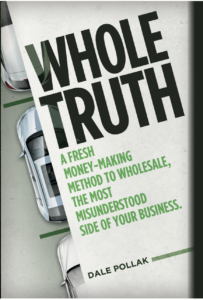 Wholesale, the Most Misunderstood Side of Your Business, is now officially available on Amazon and other retail outlets.
Wholesale, the Most Misunderstood Side of Your Business, is now officially available on Amazon and other retail outlets.
The book aims to help every dealer recognize how their used vehicle departments hold the potential to be double-barrel businesses, where you can (and today, you should) make money when you sell a vehicle in the retail or wholesale market.
“Whole Truth” touches on the history of the wholesale market and unpacks what I call the half-truths about wholesale that have long led dealers, including me, to believe that selling wholesale vehicles should be anything but a money-making opportunity. The book also serves as the catalyst for the new Upside solution, and the Upside direct marketplace, that Cox Automotive launched in late spring.
I’m glad “Whole Truth” is now available. I hope the book helps dealers see how a strong wholesale business can ultimately feed the success of your retail business in used vehicles.
The post It’s a “Whole Truth” Tuesday! appeared first on Dale Pollak.
A Rosier View of A Recession, Plus a Moment of Used Vehicle Opportunity 7 Jul 2022 10:25 AM (2 years ago)
If you follow the news and related commentary on social media, you may well be thinking that the United States is heading toward a recession, if we’re not already in the initial stages of one.
I’ve heard similar sentiments in my conversations with dealers and,  over the Fourth of July weekend, with an extended group of family and friends. It seems the level of concern and worry about a recession depends on the individual, and how they view the world.
over the Fourth of July weekend, with an extended group of family and friends. It seems the level of concern and worry about a recession depends on the individual, and how they view the world.
But there’s one person for whom I hold a great deal of respect who doesn’t believe current indicators suggest that the overall economy, and specifically the used car business, is clearly destined for a recession. The person is Cox Automotive chief economist Jonathan Smoke. This week, he shared a perspective on consumer spending, the economy and used vehicles that gave me, and others around the conference table, some comfort.
First, Smoke points to employment or, more specifically, the historically low rate of unemployment. Previous recessions were typically marked by significant increases in unemployment, a trend we’re not seeing on a widespread basis. Job openings are at record highs, and layoffs at record lows—exactly the opposite of the employment conditions you’d expect in the face of a recession.
Second, consumer spending remains remarkably strong. True, some retail sectors appear to be suffering from diminished consumer spending. But overall spending remains robust across all sectors—another indicator that Smoke says doesn’t fit classic recession-like conditions.
Third, used vehicles remains a place where consumers are spending their money. To be sure, used vehicle sales and profits are not as strong as they were this time last year. But, historically speaking, dealers are effectively selling similar volumes of used vehicles as they have in years prior to the onset of the 2020 COVID-19 pandemic.
Perhaps the wild card in Smoke’s rosier view of the current economy is consumer sentiment—and how much it may decline as worries about an actual economic recession, and related headlines, trigger recession-like behavior, wherein consumer spending fades or falls more than expected.
Meanwhile, Smoke’s view of the economy also allows for some of the volatility we’ve seen of late in the wholesale used vehicle market. Astute dealers and used vehicle managers have likely noticed that the wholesale values of two- and three-year-old vehicles sharply declined in the past two weeks—to the tune of roughly 1 percent each week at Manheim—compared to other age-based segments.
Is the volatility a sign of an imminent recession? Smoke and others, like me, don’t think so. Rather, the volatility owes to rental car companies. Late last summer and fall, when rental car companies entered the wholesale market as buyers, they helped drive up prices for two and three-year-old vehicles. Today, as the rental companies discontinue and ease their wholesale purchases, the values of the two- and three-year-old vehicles are falling off more quickly than other vehicles.
Broadly speaking, such conditions amount to a segment-specific “correction” and it’s one that either spells trouble, or opportunity, depending on the individual dealer.
The current situation’s trouble for dealers with older-age inventory that hasn’t moved. I’m seeing more dealers correctly realize that used vehicle values have begun to depreciate. They now recognize that vehicles they’ve had in inventory 30, 45 or 60 days have largely lost retail margin. Some dealers are cutting retail prices to move this inventory; others are sending it to auction. Gross profits for these dealers probably won’t look as good in July as it has in previous months.
At the same time, dealers like the used vehicle manager at a Midwest Buick-GMC store are enjoying an opportunity the current moment offers. The dealers have what I’d consider “clean” inventories that aren’t bogged by an out-size share of older-age units. Such dealers are looking for, and finding, “arbitrage” moments at auctions.
“I bought two really right today, probably from guys who have been sitting on them and needed to get out,” the manager says. “I think we’ll see more of the same the next couple weeks. There are going to be guys who are concerned about their inventory, and I’m going to be there with an open checkbook.”
vAuto Performance Consultant Scott Sadler, who works with Stockwave dealers, confirms the opportunistic moment. Each week, he tracks wholesale supplies and sales efficiency at auctions across the country. He’s now seeing something that hasn’t manifested in the wholesale market in months—vehicles with significant spreads between their Manheim purchase prices and rBook values in vAuto.
“What I am seeing is less competition at the sale, and a lot of hesitation in the bidding on the block,” Sadler says. “There’s opportunity happening in the wholesale market right now if you’re looking for it. The key is you’ve got to be looking for it and, when you see it, to respond right away before the opportunity passes through the retail market.”
The statement speaks to the more-normal used vehicle market conditions we’ll likely see in the months ahead—where opportunity and risk go hand in hand, and neither should be taken for granted.
The post A Rosier View of A Recession, Plus a Moment of Used Vehicle Opportunity appeared first on Dale Pollak.
A Mid-Year Gut-Check on Used Vehicle Market Conditions 24 Jun 2022 10:06 AM (2 years ago)
As we close in on the halfway point of 2022, I think most dealers would agree with the following statement: While used vehicle sales and profits remain solid, they are nothing like they were at this time last year.
The sentiment flows from two realities that are taking shape  broadly across the industry and in the financial statements of dealers I’ve consulted in recent days.
broadly across the industry and in the financial statements of dealers I’ve consulted in recent days.
On the broad industry front: Early this year, Cox Automotive chief economist Jonathan Smoke and other analysts predicted that 2022 might shake out in two sections. They believed the first six months of the year would be better for dealers in used vehicle than the final six months. They reasoned that spring would do its thing, and dealers would enjoy a seasonal bump in sales. Unfortunately, the bump wasn’t quite as big or bold as many expected.
The economists’ less-rosy view of the back half of the year resulted from their concern that retail demand would suffer as inflation, rising interest rates and other economic factors would pull would-be buyers out of the market. To some extent, we’re already seeing this. While some dealers have managed to meet or beat their 2021 sales volumes during the first six months of the year, others are less fortunate. They worry they have more cars in stock than current, interested buyers.
On dealership financials: As used vehicle sales seem to be softening slightly, so too have used vehicle department profits. I’ve had more than one dealer confide that despite maintaining sales volumes and profits through the early part of the year, used vehicle gross profits aren’t as rich as they have been. The used vehicle profit declines are more pronounced at stores where volume has dropped off significantly from a year ago and even last month. Some dealers also share that their overall net profit has dipped, while F&I and service businesses remain strong.
Of course, everything I’m sharing represents a broad-stroke, high-level view. Individual dealers may be enjoying the best year ever in terms of used vehicle sales and profits. Beyond that, we should all remember that, at this time last year, nearly every used vehicle you had in stock would sell quickly and generate a sizable front-end gross profit. Net profits were off the charts at most dealerships.
Even so, I think it’s wise for dealers to acknowledge that the market has begun to turn into less dealer-favorable territory, and everyone will need to re-exert the inventory investment management disciplines they had in place before the pandemic. On this front, I’ve gleaned what may be two top priorities for dealers to be ready and right-sized for a market where used vehicle sales and profits won’t come as easy as they have in recent months:
Right-sizing your inventory. Across the country, the days supply of inventory on dealer lots runs close to 50 days. At this time last year, and for much of 2021, dealers operated with a roughly 40-days supply of inventory—an unprecedented level of inventory efficiency that contributed to increased profits. But given the current market outlook, I’ve been counseling dealers to reduce their days supply and do their best to align their inventories to their rolling 30-day total of retail sales. It’s an adjustment that should always start by looking to dispatch the cars you’ve held that haven’t sold, and by being judicious about the vehicles you take in. You don’t want to be sitting in the middle of July with vehicles you acquired in April and May. In addition, while your acquisition teams should be doing everything they can to appraise and acquire vehicles from customers, you don’t want to be buying cars, and especially auction cars, for the sake of owning them. You want to take in cars you know will sell and buying them as right as you can.
Right-sizing your pricing. It’s important that dealers appreciate the current market moment when it comes to retail asking prices for used vehicles. We’re still in an era of limited supply, and while demand appears to be waning, no one expects it to fall off a cliff. Hence, the market doesn’t appear to be ushering in a moment where right-sizing your retail asking prices requires deep and dramatic discounts across the board.
That said, however, I see sizable segments and shares of dealer inventories that appear to be priced based on what a dealer or manager believes the vehicles will fetch versus a retail price that will most likely deliver buyers and satisfying returns on investment. Put another way, the vehicles are priced following the “explore and exploit” strategy that has dominated the market for months.
Here’s some evidence from ProfitTime GPS dealers: During the height of the appreciating market in 2021, many dealers effectively ignored ProfitTime GPS price recommendations for their Bronze vehicles, which are the vehicles with the least investment value and highest risk. We saw well over 50 percent of Bronze cars priced $1,000 or more above the ProfitTime GPS recommendations through much of the year. In January through March of this year, 51 percent of Bronze vehicles fit this high-price profile, a figure that has declined to roughly 41 percent today.
The decline likely owes to another reality for high-priced Bronze vehicles that some dealers now realize: The vehicles are taking longer to sell, and they’re returning less profit when they retail. For example, in January, the median days in inventory for high-priced Bronze vehicles was 42 days, compared to 25 days for all other Bronze vehicles. Today, the median days in inventory for high-priced Bronze vehicles is 53 days, and 30 days for all other Bronze vehicles. Meanwhile, with depreciation returning to the market, the median profit potential for vehicles that reach 60 days in inventory, as measured by the mark-up against a dealer’s cost to own the vehicle, runs about -$800.
My guidance to dealers with an out-size share of Bronze vehicles priced above ProfitTime GPS recommendations is that they should take their lumps sooner rather than later. The investment value, and net profit contribution, these vehicles posses won’t get better over time.
It’s understandable why dealers are holding on to these vehicles and asking all the money for them. In many cases, the Bronze vehicles are late-model units the dealers paid up to acquire, often at auctions. Dealers and managers are loathe to take less than their current gross profit average, or even a retail loss, when there’s a memory, and a possibility, that the vehicles will sell for their current asking prices no matter how long they sit.
But I would submit that such market grace will fade in tandem with retail demand. In my view, the best way for dealers to right-size their used vehicle inventories and pricing and get ahead of a changing market is to address the cars that contribute the most to your risk of profit and volume loss—the units you priced too high for too long that haven’t sold.
The post A Mid-Year Gut-Check on Used Vehicle Market Conditions appeared first on Dale Pollak.
A Memorable Honor from NIADA 22 Jun 2022 8:30 AM (2 years ago)
I received a humbling and significant honor from NIADA (the National Independent Automobile Dealers Association) yesterday at the group’s convention in Las Vegas. They presented me with a Ring of Honor, an award they give to select leaders who advance the growth and professionalism of the automotive industry.
It was touching to receive the award. It reminded  me of my father, who spent years as an independent dealer, and all the other independent dealers who have become friends over the years through my work as a dealer and with vAuto and Cox Automotive. I also had the chance to catch up with some at the convention.
me of my father, who spent years as an independent dealer, and all the other independent dealers who have become friends over the years through my work as a dealer and with vAuto and Cox Automotive. I also had the chance to catch up with some at the convention.
The award will have a prominent place in my home office. Thank you again, NIADA, for the once-in-a-lifetime honor and recognition.
For those interested, here are the remarks I shared after receiving the award:
Thank you, everyone. It’s quite an honor for me to receive NIADA’s Ring of Honor award, and I’ll share why in just a moment.
First, though, I’d like to acknowledge and thank NIADA board president, Lou Tedeschi, NIADA CEO Bob Voltmann and NIADA vice president of member services, Jim Gibson, for the work you and your teams do to advance the fortunes and interests of independent dealers across the country. The long-standing success of independent dealers, and the important role they play in our industry, owes to the things you and your teams do every day to help them be successful.
A few minutes ago, you heard a prime example of this work and commitment. The annual scholarship sponsored by NIADA, Northwood University and Cox Automotive stands as testimony to NIADA’s interest and investment in providing opportunities for the next generation of leaders who will shape the future of the car business.
This conference also reflects NIADA’s commitment to independent dealers. Events like these aren’t easy to put together or pull off. But in my experience, annual conferences like this often serve as the single best opportunity for dealers to connect with longtime friends and gain new ideas and perspective, which they can bring home and sharpen how they do business.
Now, let’s get to the Ring of Honor award and its meaning. A few weeks ago, when I learned that I would be here today to accept the award, my mind was flooded with memories. I thought of my Dad, who was like many of you in this room. He was a true blue car guy. He started in the business as a wholesaler, and eventually owned an independent auction. From there, he became an independent dealer in Northwest Indiana. His career included stops in management and sales at franchise stores. The car business was my dad’s true calling, and he eventually found a way to owning his own franchise, Len Pollak Buick AMC, Jeep and Renault in Gary, Indiana.
Like many of you, I grew up in the car business, washing cars, moving cars, making parts runs, cleaning the bathrooms and doing all the odd jobs that must be done at a busy dealership. I loved the vibe of the dealership, and how we made a difference in the lives of the customers we served. I sold my first car during the first summer I was home from college. Quite simply, I was hooked.
When I graduated from college, my Dad and I opened a Cadillac store in Elmhurst, Illinois. It was there that I saw, first-hand, how independent dealers played an important role in the success of our business. If we had vehicles we couldn’t or wouldn’t retail, we’d call our local independent dealer friends. We’d sell and trade used cars back and forth. My Dad and I considered these symbiotic relationships—business dealings that benefitted both of us.
It was this experience that shaped my belief that, without successful independent dealers in communities across America, there wouldn’t be successful new car franchises. In my view, independent dealers serve as the foundation of the car business. The work all of you do every day is a critical part of the entire automotive retail ecosystem.
I brought this perspective to vAuto when I founded the company more than 15 years ago. I had an idea that dealers, franchise and independent alike, might benefit from having more market data in their hands to make better decisions about how they manage and sell used vehicles. When I hit the road to sell my software to dealers, I didn’t care if the dealer had a franchise brand on the sign out front. My goal was to help every dealer, regardless of how they came up in the business, achieve greater success.
That’s why the Ring of Honor award means so much to me. The award serves as affirmation that as dealers, we are all in this game together. The interests of independent and franchise dealers have always been intertwined and I believe they always will be.
On a more personal level, the Ring of Honor award helps ease one of my long-standing insecurities. You see, I was never a car guy like my Dad or many of you in this room. I was the son of a successful dealer who cast a long shadow. Sure, I had a knack and love for the business. But I wasn’t a car guy in the classic sense.
But here I am today, receiving the Ring of Honor award from NIADA. It’s really the highest level of recognition I could hope for. The award signifies that I’ve been accepted as a car guy by the true car guys of the car business—all of you, the independent dealers who help make our shared business so exciting and special.
Thank you for this honor and this very special moment. I’ll cherish it forever. Thank you.
The post A Memorable Honor from NIADA appeared first on Dale Pollak.
A Call for “Bucket”-Minded Inventory Acquisition 13 Jun 2022 9:16 AM (2 years ago)
If you scrolled the clock back 15 or 20 years, you’d find very few dealers who managed their used vehicle inventory in what we now call “buckets.” Rather, dealers managed used vehicles in blocks—cars that were less than 60 or 90 days old and those that weren’t.
Over time, the bucket-based approach to inventory  management has proven to be a superior method. Dealers set up buckets based on a vehicle’s age or time in inventory, as well as other criteria. Each bucket generally has parameters for pricing and promotion to manage sales throughput in each bucket. The parameters usually tie to market metrics (like Cost to Market, Price to Market and others).
management has proven to be a superior method. Dealers set up buckets based on a vehicle’s age or time in inventory, as well as other criteria. Each bucket generally has parameters for pricing and promotion to manage sales throughput in each bucket. The parameters usually tie to market metrics (like Cost to Market, Price to Market and others).
In the past two-plus years, with the help of vAuto’s ProfitTime GPS, some dealers have gone beyond buckets, using each vehicle’s investment value and automated price recommendations to manage each vehicle to its appropriate investment return.
I share this bit of inventory management history because it’s helpful to understand where we are in the current moment with used vehicle inventory acquisition. In a nutshell, I believe we’ve arrived at a time where dealers should follow a bucket- or channel-based approach to acquiring used vehicles, lest they miss out on opportunities in today’s supply-constrained market.
My thinking follows the evolution of how some dealers quickly shifted the way they acquire inventory as the COVID-19 pandemic disrupted the wholesale and retail markets for used vehicles. Dealers who relied on auctions or trade-ins for inventory found themselves in a pinch. Many turned to their own customers, looking for vehicle acquisition opportunities in their lease portfolios, service lanes, off the street and we’ll-buy-your-car programs.
Unfortunately, this shift occurred at a time when dealers didn’t necessarily need to worry about how they were acquiring these cars. What’s the point of sweating how right you acquire vehicles if you know values are rising, customers want almost any car and, if you have the cars, they’ll likely sell quickly?
Well, such favorable conditions are fading right now. Meanwhile, dealers who want to maintain their retail sales volumes and profitability have no choice but to continue acquiring inventory from as many channels as possible to meet their goals, and to know, in no uncertain terms, what buying a car “right” means for any specific sourcing channel.
That’s why I believe it’s time for dealers to apply a bucket- or channel-minded approach to managing their inventory acquisition efforts, just like they’ve done with managing and pricing vehicles in their inventories. The shift needs to start with metrics that help dealers and managers know if/when appraisers and buyers are doing the best job as they aim to acquire cars and/or customers. The metrics should inform acquisition teams of the type of vehicles typically available in each channel, the channels where they can acquire the best cars, and when they should step up, or step back, on purchase or trade-in offers due to the individual circumstances of each deal and each sourcing channel.
I’ve been working with dealers and vAuto ProfitTime GPS developers to define the metrics that matter most to optimize inventory acquisition in the current multi-channel sourcing environment.
Volume: This metric tracks the number of cars that flow from each sourcing channel, helping dealers and managers identify (and prioritize) the channels where cars can and should come from.
Model Year/Odometer: In today’s supply-constrained environment, it’s important to know the channels where you can source late-model vehicles that might fit certified pre-owned program criteria and higher-mileage, older vehicles that fit the needs of budget-minded buyers. This metric gives dealers the insight to pursue channels with specific vehicles and characteristics in mind.
Investment Value: I’ve always believed that the job of used vehicle managers isn’t to sell cars, it’s to make money for their dealers. Hence, it’s critical to source and stock vehicles with the highest money-making potential. In ProfitTime GPS, the investment value metric shows dealers the sourcing channels that produce the vehicles with the best money-making potential. With this knowledge, dealers and managers can prioritize the channels that help them achieve their business objectives, whether it’s volume, gross or a balance of both.
% On/Off Strategy: As dealers source inventory from a wider variety of channels, it becomes more important to establish an overall strategy that guides how appraisers and buyers approach cars and customers in each channel. The strategy sets the parameters for buying a vehicle “right” in a specific channel, while giving appraisers and buyers latitude to make deals, provided they have good reasons. Over time, dealers find the strategic baseline enables closer collaboration and oversight to achieve optimal outcomes in each channel.
Days to Sell: This metric helps dealers connect the dots between the investment value of the vehicles they acquire in a specific channel and the time horizon by which they expect a retail sale/investment return. It’s a thumbnail-quick way to know the retail performance of vehicles sourced from individual channels, and explore why vehicles from specific channels do not perform as well as expected.
When dealers use these and other metrics to manage the performance of appraisers and buyers across all the sourcing channels they activate, good things tend to follow. They arrive in the form of realizations where “pockets” of the just-right inventory can be acquired, where investment acquisition strategy targets or thresholds might be adjusted in a particular sourcing channel and greater appraisal and valuation consistency across every channel.
The outcomes mirror what we saw when dealers began bucket-based inventory management. They priced vehicles more consistently, developed rationales, reasons and rules to ensure their teams made the right decisions and, ultimately, sold more cars. I’m not surprised at all by the parallels between used vehicle acquisition and pricing when the right metrics are applied to each. After all, you can’t manage what you can’t measure and, if you can’t manage, you can’t improve.
The post A Call for “Bucket”-Minded Inventory Acquisition appeared first on Dale Pollak.
Where Dealers Get Their Most Profitable Inventory 3 Jun 2022 10:29 AM (2 years ago)
Most dealers would agree that acquiring inventory over the course of the past two years has grown more complex and difficult. We now understand that, if you want to maintain, if not grow, your share of money-making used vehicle sales, you can’t rely on trade-ins as much as you did in the past.
Similarly, while dealers still lean on auctions for inventory, they aren’t likely to find vehicles with substantial money-making opportunities, unless you’re buying vehicles that are four years old and older.
These market circumstances have led to a key question among dealers as we arrive at the mid-point of the current year—what are the best channels to source the most profitable inventory?
We can at least partially answer this question through inventory data that shows the sourcing channels where ProfitTime GPS dealers are vehicles with the highest investment values. (A quick refresher: ProfitTime GPS includes the Global Acquisition system, which measures and tracks where dealers acquire inventory, and shows how vehicles in each channel stack up based on their Bronze, Silver, Gold and Platinum investment value 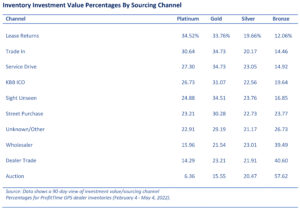 designations.)
designations.)
The chart at right shows what every dealer could likely guess correctly—lease returns and trade-ins provide inventory that possesses the highest investment values. Nearly two-thirds of the inventory acquired in these channels carry Gold and Platinum designations, the highest investment classes on ProfitTime GPS’ scale. But it’s also important to note that between the two channels, trade-ins account for a far higher share of inventory volume than lease returns (roughly 54 percent and 1 percent, respectively).
The inventory data also shows that vehicles acquired in the service drive and through Kelley Blue Book Instant Cash Offer also deliver a sizable share of higher investment value vehicles. Sixty-two percent of the vehicles acquired in the service drive are Gold and Platinum cars, while 58 percent of the KBB ICO-acquired vehicles are Gold and Platinum. Both of these channels suggest opportunity for dealers to source more high investment value vehicles: service drives account for 1.7 percent of overall inventory volume; for KBB ICO, it’s 3.4 percent.
The inventory data also suggests opportunity for dealers to acquire high investment value vehicles through the sight unseen and off-street purchase channels. Fifty-nine percent of the sight unseen-acquired inventory, and 53 percent of the off-street inventory, arrives as Gold and Platinum investments. There are more Gold than Platinum cars in these channels, and the channels tend to produce more inventory volume than the channels noted above (4.1 percent for sight unseen, and 2.7 percent for off-street).
I don’t think anyone will be surprised by the higher percentages of lower investment value vehicles at the bottom right of the chart. The data affirms what I hear in dealer conversations—there certainly aren’t as many great deals, or steals, across the inventory dealers acquire from auctions, other dealers and wholesalers.
As I’ve shared the ProfitTime GPS inventory data with dealers, I’ve been suggesting two steps to help them point their inventory acquisition efforts to the channels where better-value investments are more likely to occur:
Step 1: Avoid acquiring one-to-three-year-old vehicles at auctions if you can. Currently, wholesale prices for these vehicles are higher than retail prices. If you need these vehicles, you’ll be far better off, investment-wise, to step up your efforts to acquire late model units directly from customers through the trade-in, service drive, KBB ICO and sight unseen channels.
Step 2: Turn your lower-tier, Bronze-level investments as fast as possible. These vehicles are arriving in dealer inventories as distressed investments, and the market is returning to more normal trends of depreciation. The faster you get out of these vehicles, the faster you’ll reduce your risk and be able to redeploy the capital to another investment with higher yield potential.
My hope is that this inventory data will give dealers benchmarks they can use to know where they are more likely to find the best investment value vehicles and how to pursue these opportunities. After all, it’s the higher investment value vehicles that will help you hold your own if/when market conditions become less favorable in the months ahead.
The post Where Dealers Get Their Most Profitable Inventory appeared first on Dale Pollak.
Rediscovering the Past and the Profound While Packing 31 May 2022 5:31 AM (2 years ago)
I’ve been busy the past week, helping my wife, Nancy, pack our belongings into boxes as we officially relocate to Austin, Texas.
I did an informal poll of family and friends and arrived at a near-universal conclusion—no one really likes moving. True, there’s the anticipation and excitement of  setting down roots in a new place. But it’s the old place, and the process of going through everything you’ve accumulated over the years and deciding what to keep, that I and others find to be the least-pleasant and most-tedious part of the whole experience.
setting down roots in a new place. But it’s the old place, and the process of going through everything you’ve accumulated over the years and deciding what to keep, that I and others find to be the least-pleasant and most-tedious part of the whole experience.
Like many empty-nester parents, Nancy and I have marveled at how much stuff we’re moving. We’re both a bit sentimental, so there’s quite a bit we’ve gathered, and forgotten about, over the course of the past 20 to 30 years. We’ve found ourselves laughing, and sometimes crying, as we go through our things and remember the day they arrived.
The other day, we ran across a third-grade writing assignment from our son, Samson. It’s a hand-written paragraph describing what he wants to be when he grows up. Back then, he wrote about his desire to be an inventor, who would build something others would need and find useful.
We found this memento about the same time Samson called to share some exciting news from his job at Oracle Netsuite in Austin. He told us that he’d just met with top executives at the company to share a formula, and software tool, that he developed for identifying and selling business prospects for the company. They liked his invention and may develop it for broader use.
Of course, Nancy and I were extremely proud to hear the news. And, we were struck by the happy coincidence of finding his assignment and hearing that our invention-minded third-grader is living the life he imagined more than 15 years ago.
The packing also produced a baseball I had completely forgotten about and that I didn’t relish remembering. The ball came from my Little League team in the summer of 1967, when I was nine years old. The ball bears the name of our team sponsor, General Glass, a local auto glass shop, and our team’s record, 5-8. The ball also shows my batting record and the early stages of a degenerative eye disease I still carry: 12 at-bats, 11 strikeouts and one hit.
I distinctly remember the hit. Somehow, I managed to connect with the ball and send it into the outfield. It was a triple that should have been a home run—except I had trouble finding and rounding the bases. I remember the screams and yells from coaches and parents in the stands. I also remember the laughs from those who apparently found my struggle in the basepaths a bit comical.
The baseball and Samson’s writing assignment won’t join what seems like a vast quantity of stuff we’re donating or throwing out as we pack up the house. No, we’re keeping them as reminders of how early experiences in life profoundly shape the lives we eventually lead.
The post Rediscovering the Past and the Profound While Packing appeared first on Dale Pollak.
How Dealers Acquire Inventory from Service Customers 20 May 2022 12:10 PM (2 years ago)
In a recent post, I highlighted how vehicles dealers acquire directly from service customers hold almost as much investment value potential as those they acquire off-lease and from trade-in.
The insight comes from ProfitTime GPS analytics that help  dealers understand the sourcing channels that perform best for them, and where they may find additional acquisition opportunities. In the post, I promised to share best practices from dealers who have turned service lane acquisitions into a reliable, steady source of inventory for their used vehicle departments and certified pre-owned (CPO) sales programs.
dealers understand the sourcing channels that perform best for them, and where they may find additional acquisition opportunities. In the post, I promised to share best practices from dealers who have turned service lane acquisitions into a reliable, steady source of inventory for their used vehicle departments and certified pre-owned (CPO) sales programs.
One of my first calls went to Brian Benstock, vice president of Paragon Honda and Paragon Acura in Woodside, New York. He is regarded as one of the nation’s best CPO retailers. Among Honda and Acura dealers, Benstock leads everyone by a sizable margin in terms of CPO volume. He and his team repeated this achievement in 2021, marking more than a decade in the top CPO spots for both brands.
If you asked Benstock why his CPO sales have remained so strong, he’d point to his service lane, and the process he implemented coming out of the Great Recession in 2008 and 2009. The process aims to acquire current vehicles from service customers and sell them another one.
“It’s why our CPO sales have remained so strong,” Benstock says. “We go fishing in our database. It’s a strategy that insulates you from the competition and it’s an excellent strategy for vehicle acquisition.”
For other dealers, the service lane remains a largely untapped opportunity for inventory acquisition. To help, I’ve distilled some of the best practices I gleaned from Benstock and other dealers:
Understand the opportunity. Benstock considers the acquisition/sale of a vehicle with service customers as the single-most valuable transaction that occurs in his stores. “It feeds every profit center in the dealership, new, used, parts, service and F&I, and it feeds a couple profit centers multiple times,” he says. Benstock encourages dealers to determine the average value of the transaction for themselves to better understand the scope of their own service lane opportunity. Today, Benstock says the 10-person team that’s dedicated to meeting with service customers to acquire/replace their vehicles creates a $120 million annual opportunity, factoring in the gross profit achieved across the departments as a result of the initial transactions.
Set the stage for the conversation. Benstock uses technology and tools to identify the customers who meet the store’s definition of an “equity” position in their current vehicle. “Equity doesn’t necessarily mean they owe less than the value of their vehicle,” Benstock says. “For us, equity means you can take a customer out their current car and put them into a new car for a similar monthly payment. It’s equity in terms of doing a payment walk.” As customers who fit the definition schedule service, they are made aware of an “equity alert” opportunity that sets the stage for a discussion with the customer about their current vehicle and a replacement.
Steer clear of hard sells. Recent Cox Automotive surveys show that 15 percent of consumers say they’ve been presented a trade-in value during a dealership service visit, while 12 percent say they’ve traded/replaced their vehicle following the initial presentation. The stats match up to results I’ve heard anecdotally from dealers who pursue service lane acquisitions in earnest. They share that close rates on appraisal/trade-in conversations run between 10 percent and 20 percent. At Paragon, the team aims for acquiring/replacing vehicles from 10 percent of the roughly 10,000 customers they identify as equity-eligible every month. The survey data and close rate benchmarks underscore that while customers are often interested in hearing about their vehicle’s value and a possible replacement, a smaller share will complete the deal. Hence, dealers say it’s best to avoid a hard sell with your service customers. As Benstock says, “we have an obligation to let customers know about the opportunity. They don’t have an obligation to do it, but if it makes sense for them, we want them to strongly consider it and know we’ll make it easy.”
Avoid sales/service conflicts. The most successful service lane acquisition programs share a common theme—they’re set up to avoid conflicts between sales and service. An example: A service advisor has an RO underway, and sales works to acquire the vehicle while it’s on the lift. When this occurs, dealers like Benstock advise that the service advisor needs to get credit for the RO—whether it’s booked as customer pay or as part of an internal RO for reconditioning the vehicle post-acquisition. As Benstock explains, “this way, the house captures the work either way and the service advisor is not in competition with the sales-in-service team. The car needs the work, regardless of the status.”
Dedicate resources to the effort. Some dealers set up and staff a “vehicle exchange” desk at/near the customer lounge; others rotate sales-in-service specialists to engage customers after advisors ask them if they’re interested in knowing the value of their vehicle. The broader take-away: “If you aren’t going to dedicate a team, you’ve got to dedicate hours,” Benstock advises. “If you aren’t all-in and committed, it won’t work.”
Through my conversations with dealers about service lane acquisitions, it’s becoming increasingly clear that this sourcing channel holds opportunity for them to favorably acquire vehicles that they need for their used vehicle inventories and their CPO sales goals—especially given the constraints on new vehicle inventories, lease deals and trade-in volume nearly everyone expects to continue for some time.
Benstock believes his service lane acquisition strategy will serve as a profit replacement plan as market conditions normalize and potentially become more difficult with higher inflation and interest rates: “By being hyper-focused on the customers we have today, we’ll be on our way to lessening the downside when it comes.”
The post How Dealers Acquire Inventory from Service Customers appeared first on Dale Pollak.
A Top of the Market Moment in Used Vehicles 16 May 2022 4:26 PM (2 years ago)
If you’re a stock investor, the top of the market arrives when the value of an asset or security stops rising and begins to trend downward. The same is true in used vehicles: The top of the market occurs when wholesale vehicle values reach a peak and begin to soften.
That’s effectively where the current used vehicle market  stands. Cox Automotive analysts believe we’ve reached the top of the wholesale market and the spring selling season. Wholesale values aren’t rising like they have in recent weeks, and retail demand doesn’t appear to be getting any stronger. Some suggest we’ve passed the strongest part of what might be considered a sluggish spring selling season, particularly compared to prior years.
stands. Cox Automotive analysts believe we’ve reached the top of the wholesale market and the spring selling season. Wholesale values aren’t rising like they have in recent weeks, and retail demand doesn’t appear to be getting any stronger. Some suggest we’ve passed the strongest part of what might be considered a sluggish spring selling season, particularly compared to prior years.
The analysts and economists go a step further. They tell me there’s no reason to believe that retail demand will get any better than it is right now, and they don’t think wholesale values or retail prices will rise any higher than they have already, barring the wild card of rental car or other companies pushing up values as they acquire inventory.
The situation arrives as dealers have an average of a 48-days supply of used vehicle inventory on their lots—about five days higher than normal for this time of year. The extra inventory likely owes to dealers stocking up on vehicles in anticipation of a spring selling season that wasn’t as strong as many of us had hoped for.
The result: Dealers are sitting on a lot of inventory investments that, given the way the market appears to be moving, will likely see a greater degree of depreciation than we’ve seen in recent months.
What to do? I’ve been telling dealers that now is not the time to be heavy in inventory, it’s the time to be “right” with your inventory.
There are two initial steps dealers should take to make sure their inventories are “right” as the market turns.
First, dealers should re-balance their inventory to their rolling 30-day total of retail sales. The COO for a six-store dealer group in the Southeast is following this prescription. “About 90 days ago, we made some errors when we were buying cars just to buy the cars,” the COO says. “About a month ago, we had 80 in stock at one of our stores, and we were selling 40. We’re down to about 55 now. We’re only filling holes with cars we really need.”
Second, dealers should take a close look at how they’re pricing vehicles that have reached 30, 45 or 60 days in inventory. A sizable number of ProfitTime dealers have priced their most investment-distressed vehicles (e.g., their Bronze cars) at or well above 100 percent of the market. I’m not suggesting now’s the time for fire sale prices, but it’s becoming apparent that the buyers some dealers believe will pay above-market retail prices for these vehicles don’t seem as plentiful as they have been.
Dealers who work to get things right with the inventories now will be doing themselves a big favor. They will minimize and mitigate the effects of what appears to be a softening used vehicle market and, more importantly, they will be restoring the disciplines of inventory investment management the market hasn’t required for some time.
The post A Top of the Market Moment in Used Vehicles appeared first on Dale Pollak.
A Closer Look at Where Dealers Can Acquire Late Model Vehicles More Profitably 6 May 2022 10:10 AM (2 years ago)
If you’re a franchised dealer looking to stock more one- to three-year-old vehicles in your used vehicle inventory, you’re probably having a hard time lately.
The difficulty owes to a few related factors. First, there are fewer one-to-three-year-old vehicles available. In two of the three most recent years, 2020 and 2021, 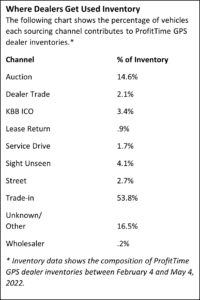 new vehicle production fell markedly below normal levels. That’s not saying late model vehicles aren’t available. The pool is simply smaller.
new vehicle production fell markedly below normal levels. That’s not saying late model vehicles aren’t available. The pool is simply smaller.
Second, demand among dealers for one-to-three-year-old vehicles is as robust as ever. For much of the past decade, one-to-three-year-old vehicles have effectively served as the sweet spot in used vehicles for dealers. The cars are prime candidates for factory certified pre-owned programs, and they also appeal to buyers who, due to availability, budget or some other factor, want an almost-new used vehicle.
Third, wholesale values for one-to-three-year-old vehicles are sky high. In the past week or so, these vehicles are selling at auction for more than their current retail prices. Earlier this week, Cox Automotive analysts noted that 2019 vehicles, as a whole, sold at auction more than $50 above current retail prices.
Given this backdrop, I’ve asking a question: Where’s the opportunity?
I found at least a partial answer through inventory acquisition data from ProfitTime GPS dealers. The data comes from the solution’s Global Acquisition System, which helps dealers know the number/type of vehicles they source from specific channels (e.g., auctions, trade-ins, lease returns, service drives, etc.), the average investment value of vehicles in each channel, retail performance of cars in each channel, appraiser performance in each channel and other operational insights.
Generally speaking, the ProfitTime GPS dealers are like everyone else. They’re getting most of their one-to-three-year-old vehicles from the sourcing channels they’ve relied on for years. The data shows that 46 percent of vehicles less than five years old in dealer inventories come from trade-ins, and 19 percent come from auctions.
As you might expect, the profit potential these vehicles are able to produce is dramatically different. With trade-ins that are less than five years old, 36 percent arrive in dealer inventories as “Gold” vehicles and 18 percent are “Platinum.” (ProfitTime GPS ranks the investment value of each vehicle on a scale of 1-12, classifying them progressively as Bronze, Silver, Gold or Platinum vehicles.) Meanwhile, auction vehicles that are less than five years old consistently enter dealer inventories as Bronze (63 percent) and Silver (20 percent) vehicles, which represent the lowest investment values on ProfitTime GPS’ scale.
This data leads to another question—what other sourcing channels might offer dealers the opportunity to bring in more late model vehicles with better overall investment value potential?
To answer the question, I looked at inventory data to determine other sourcing channels where current volume and investment values suggest an opportunity. Some might readily point to lease returns as a solid option for dealers to get near-new inventory. The supposition is true—dealers take in almost 70 percent of lease returns as Gold and Platinum vehicles. However, lease return volume amounts to less than 1 percent of dealers’ total inventories, and current conditions see many lease owners choosing to keep their vehicles.
Meanwhile, there’s another sourcing channel that stands out as offering what might be regarded as untapped potential for late model inventory—the service drive. ProfitTime GPS dealers currently source about 2 percent of their used vehicle inventory from the service drive. When they bring in these vehicles, the profit potential on late model units runs strikingly close to trade-ins—35 percent are Gold and 20 percent are Platinum. This data affirms a comment I’ve heard from more than one ProfitTime GPS dealer: “There’s gold in your service drive if you go after it.”
As I’ve talked to dealers, most acknowledge that there’s ample room for improvement in the way they source from their service drives. Many have made this sourcing channel a higher priority this year. I’ve been collecting best practices for service drive sourcing, which I’ll share in a future post.
In the meantime, my quick study of dealer inventory data offers a key take-away for every dealer: Once you know the investment value and type of vehicles you might expect from individual sourcing channels, the better able you’ll be to profitably acquire the cars you really need to sell and satisfy today’s near-new-minded buyers.
The post A Closer Look at Where Dealers Can Acquire Late Model Vehicles More Profitably appeared first on Dale Pollak.
An Encouraging Start for Cox Automotive’s Upside/Upside Direct Wholesale Experience 28 Apr 2022 9:26 AM (2 years ago)
This past Monday marked the end of the first Upside Direct auction in Atlanta.
The digital sale, which started Friday and ended Monday, was notable on several fronts:
Keen buyer interest. “We saw 270 bids in the first five minutes,” says Derek Hansen, vice president of wholesale for Cox Automotive. “Historically we haven’t seen dealer bids that strong so early in a sale.” The inaugural sale featured almost 90 vehicles, which saw an average of 23 bids/vehicle—more than three times the number of bids the average vehicle earns in more established auction settings.
saw an average of 23 bids/vehicle—more than three times the number of bids the average vehicle earns in more established auction settings.
Through the course of the sale, more than 8,000 dealers logged into Upside Direct to view cars. A sizable number submitted a single bid—ostensibly to see if the sale itself was for real. My take: Such interest flows from two factors—Upside Direct is new and buyers appreciate that Upside Direct starts vehicles for sale at 50 percent of their Manheim Market Report (MMR) values.
Solid profits for sellers. When dealers use Upside to put cars for sale in Upside Direct, they are guaranteed a minimum profit, plus the lion’s share of the upside a vehicle earns above the guarantee when a vehicle sells. The end result for sellers: Upside’s minimum guarantee and the lion’s share of the upside from sales meant that dealer sellers averaged about $1,500 in wholesale returns in the first Upside Direct sale. The figure compares favorably to wholesale profits public retailers like CarMax and Carvana reported in their latest earnings reports.
Independent dealer Jeremiah Mowry of Atlanta Auto Brokers sold four cars in the sale. He also plans to put more in future Upside Direct sales. “We sold our cars and made really good money,” he says. “I’m super-satisfied with the results.”
Proof of the Rule of 200: In my latest book, “Whole Truth: A Fresh Money-Making Method to Wholesale, the Most Misunderstood Side of Your Business,” I share the Rule of 200, a strategy smart dealers use to measure how well their wholesale vehicles perform at auction. The Rule of 200 dictates that a dealer’s wholesale vehicles should achieve 100 percent of MMR in total, and 100 percent first run sales efficiency (meaning the cars sold the first time they ran). Dealers who use the strategy add the two strategic goals together to see if the sum of their performance equals 200.
The Upside Direct sale met those critical performance benchmarks: Overall, the vehicles achieved nearly 100 percent of MMR when they sold. Some cars sold for more than MMR (a pick-up went for 122 percent of MMR), and some sold for less. But the cumulative total of the vehicle sales met the first leg of the Rule of 200.
Only six of the nearly 90 vehicles available for sale did not receive bids – in these cases, the dealer will be paid the full Upside Guarantee and Upside bears responsibility for reselling the cars. In this regard, the Upside Direct sale came close to achieving the second leg of the Rule of 200. I view the performance as a solid start that will only get better as Upside Direct brings in more buyers and vehicles
A good mix of vehicles. The first sale featured a varied mix of vehicles. The average age of the vehicles was nine years, with some older than 21 years. The average mileage was 117,000; some cars had less than 10,000 miles and some had more than 200,000 miles. Across the vehicles, MMR values ranged from less than $5,000 to more than $50,000. The take-away: Upside Direct’s first sale offered vehicles that would appeal across the full spectrum of potential buyers.
As one might expect, the initial sale also offered some lessons learned the Upside teams will apply going forward. All in all, however, the debut of Upside and Upside Direct, Cox Automotive’s new wholesale experience for buyers and sellers, stands out as a winner for both.
The post An Encouraging Start for Cox Automotive’s Upside/Upside Direct Wholesale Experience appeared first on Dale Pollak.
Signs of a Softening Retail Market in Used Vehicles 22 Apr 2022 9:17 AM (2 years ago)
Earlier this month, I noted how retail used vehicle sales in April might be a stage-setter for the remainder of the year. Like many dealers, I was hopeful that sales would take a positive turn—that a shower of sales in mid-to late April might bring flowers in May and beyond.
Well, it’s starting to look like we won’t see the “bounce” in retail sales everyone hoped would materialize. The hope was based in part on the fact that,  as of a few weeks ago, a smaller share of consumers had received their federal tax refunds than usual. The arrival of those delayed checks, the thinking went, would hopefully cause retail sales of used vehicles to pick up.
as of a few weeks ago, a smaller share of consumers had received their federal tax refunds than usual. The arrival of those delayed checks, the thinking went, would hopefully cause retail sales of used vehicles to pick up.
Unfortunately, as many dealers know, retail sales of used vehicles haven’t increased substantially as April has unfolded—despite the arrival of more (and larger) Internal Revenue Service refunds than the same time last year. The upshot: Tax refund dollars are out there but they don’t seem pointed toward used vehicles.
The end result is that while retail demand remains relatively strong, dealers are experiencing a far more muted spring selling season than many expected this year. At Cox Automotive, analysts had projected April to be one of the best months of 2022 for retail sales of used vehicles. Today, analysts are revising their retail sales forecasts for the calendar year. Cox Automotive chief economist Jonathan Smoke believes we’ll see 500,000 fewer retail sales of used vehicles this year compared to last year.
As I’ve talked to dealers in recent days, I’ve shared how the current rates of retail sales, combined with broader economic factors such as rising inflation and higher living costs overall, suggest the time has arrived for more stocking and pricing discipline. At some stores, inventory investment fundamentals have gone soft as dealers have enjoyed two consecutive years of record-setting used vehicle sales and profits.
Across the country, dealers have a roughly 45-days supply of used vehicle inventory on their lots. Given the current conditions, I’ve been reprising my guidance that dealers should balance their inventories to their rolling 30-day total of retail sales. If you’re long on inventory right now compared to your rolling 30-day retail total, the time has arrived when tempering acquisition efforts, particularly in the higher-cost sourcing channels like auctions, makes good sense. It’s also a time that when you need to make doubly sure that your appraisers and buyers understand exactly how much your inventory needs the vehicle they’re considering.
The current conditions also suggest that dealers will need to mind their retail used vehicle pricing more earnestly than they’ve needed to in the recent past. A few months ago, some anticipated that a spring sales bounce would cause price appreciation in the wholesale and retail markets—the best of both worlds for dealers.
While we’ve seen some appreciation in the wholesale market in recent weeks (about 2 percent, roughly half of typical spring value appreciation), retail prices aren’t moving up in any significant way. Some anticipate retail prices will trend down as dealers realize spring buyers aren’t coming as quickly, or in the numbers, that they expected.
Perhaps the best news of the current used vehicle market environment is that we’ve all been here before. We know how to optimize used vehicle profitability when market conditions aren’t fully in our favor and margin compression risks are on the rise. It’s time to restore your focus on inventory investment management fundamentals to stay ahead of what appears to be a softer used vehicle market.
The post Signs of a Softening Retail Market in Used Vehicles appeared first on Dale Pollak.
Will April Bring a Bounce or Bump for Used Vehicle Sales? 11 Apr 2022 8:27 AM (2 years ago)
All eyes, it seems, are on the used vehicle sales rate for April. Why? Because the month appears to be shaping up as a touchstone of where the market’s headed.
First, a quick bit of background: Overall, dealers closed the month of March selling 15 percent fewer vehicles than they did in March 2019. Compared to March of 2021, used vehicle sales were off even more.
March of 2021, used vehicle sales were off even more.
To be sure, some dealers didn’t have this experience. They sold record numbers of vehicles in March. If you were among this group, you were fortunate. You benefitted from what analysts might consider the start of the “spring bounce” in used vehicle sales.
Other dealers, meanwhile, have started to question if we’ll have a spring bounce at all. Their March sales didn’t meet expectations, and they’re now seeing (and selling) fewer customers looking at their cars online and on the lot.
March’s slower-than-anticipated sales appears to owe largely to delays in federal income tax refunds to consumers. As of March 22, the IRS had issued about 45 percent of tax refunds. At the same time last year, the IRS had issued 71 percent of tax refunds. The difference means we had fewer people with fresh tax refund money looking for used vehicles last month.
Now comes April. Cox Automotive chief economist Jonathan Smoke shared this outlook last week:
“We anticipate the second quarter – and particularly April – will be the strongest part of the year for used vehicle sales and values. Once we get through the spring, we expect demand to wane somewhat and should see closer to normal price depreciation patterns for the rest of the year.”
The key element of Smoke’s analysis is whether April will bring the bounce to used vehicle sales the industry wants to see or a bump that signals a rockier road in the months ahead.
Smoke and other analysts note several economic factors that might slow sales in April. Gas prices are high. Groceries are more expensive. Rents are up. Interest rates for mortgages and used vehicle loans are also on the rise. In other words, household budgets face some strain, which could suppress retail demand for used vehicles.
Like everyone else, I’m hoping that Smoke’s forecast for a strong April proves true. If we see a bounce, it’ll validate the fact that retail demand remains relatively strong. Plus, a bounce would give dealers the opportunity to sell through the average 45 days’ supply of used vehicle inventory that’s built up as spring sales so far haven’t met expectations.
The post Will April Bring a Bounce or Bump for Used Vehicle Sales? appeared first on Dale Pollak.
ProfitTime GPS in Practice: Elevating Appraiser Accuracy, Consistency and Performance 24 Mar 2022 12:32 PM (3 years ago)
It’s been an eye-opening experience as I’ve taken part in early training sessions for dealers who are adopting the new ProfitTime GPS (Global Profitability Solution).
The training sessions typically address two main elements—how dealers can use ProfitTime’s 1-12 scoring system to establish the strategic start/end points for  every appraisal (your “target” and “threshold”), and how the system helps dealers and managers know how often, and how well, individual appraisers bring in cars that fit the strategic objectives dealers establish.
every appraisal (your “target” and “threshold”), and how the system helps dealers and managers know how often, and how well, individual appraisers bring in cars that fit the strategic objectives dealers establish.
Broadly speaking, the feedback from dealers, managers and appraisers in these sessions has been extremely positive. I was worried that some might view ProfitTime GPS’ strategic appraisal baselines, and its recommended appraisal and pricing amounts, as too restrictive. Similarly, I was concerned that the system’s reporting tools, which provide a greater level of detail (and accountability) on appraiser performance, would make individual appraisers uncomfortable.
Instead, it’s been gratifying to hear exactly the opposite. Everyone seems to understand that ProfitTime GPS’ strategic objectives serve as efficiency-minded guideposts, not hard-and-fast rules. Appraisers appreciate seeing the potential open and end points for a vehicle when they start a new appraisal. They also appreciate the system’s built-in logic, which automatically adjusts appraisal amounts and retail price recommendations to help bring in vehicles to meet their dealer’s objectives and give them flexibility to step up or back on a vehicle when they need to. I suspect the overall understanding that ProfitTime GPS is intended to help everyone do a better job contributes to the positive feedback we’re hearing about the appraiser performance page. What’s to fear if you’re set up for success, right?
But the sessions have also revealed what might be described as two fault lines in the current processes many dealers use to appraise vehicles. The fault lines aren’t new or unknown. They are, in fact, appraisal fundamentals that, due to the hectic nature of appraising cars and making deals, often get forgotten or overlooked:
- Pencil-sharp reconditioning estimates. Over the years, vAuto Performance Managers have been helping dealers and their teams do a better job of assessing each car’s condition and getting as close as they can to actual costs when they estimate the reconditioning work needed to get a vehicle ready for retail. Even so, it’s an area of appraisals that could be better. On the training calls, I’m hearing dealers emphasize to their teams the importance of getting the estimates right. Why? Because any variance—which anecdotally I’ve heard can range from $300 to $600, depending on the dealership—means you’ve got less money to apply toward acquiring the vehicle and customer in front of you and, if you buy the car, you don’t have a clear view of a vehicle’s investment return or profit potential if the recon estimates are wrong.
- How much you need the car, and the market likes it. On the training calls, appraisers shared how they liked the way ProfitTime GPS’ Global Acquisition system “pivots” to recommended appraisal and pricing amounts based on how much a dealer’s inventory needs a car and how much the market likes it. As one appraiser put, “it’s sometimes hard to know how much we need the car.” The comment’s honest, but it also reveals a big risk. If your buyers and appraisers don’t know how much you need a car, or whether the market likes the car, they really don’t know how much they can or should pay for it. This age-old truth has become even more critical as dealers are putting more people, in more places, to acquire inventory from anywhere and everywhere.
A final point: Perhaps the most telling aspect of the training calls came via the realization among dealers that as ProfitTime GPS gives them a way to strategically guide and measure appraiser performance, their used vehicle departments will ultimately see better, more consistent outcomes. As one dealer noted, “there’s always been thousands of dollars of difference between appraisers and more consistency will only help us.”
The post ProfitTime GPS in Practice: Elevating Appraiser Accuracy, Consistency and Performance appeared first on Dale Pollak.
NADA Follow-Up: Two Things That Occurred While We Were Away 15 Mar 2022 11:40 AM (3 years ago)
One of the nice things about an in-person NADA convention is its all-consuming nature. The convention is the center of the universe for a few days. When you’re there, in the moment almost every moment, it’s not as easy to keep up with what’s going on everywhere else.
But while we were away, two fairly significant things did occur in the used vehicle market.
The first came in the form of a slight, overall increase in  wholesale values—what analysts like Kevin Chartier of Manheim take as the first sign of the spring selling season. The increase marked the first rise in wholesale values in 2022, and it arrived a few weeks later than usual. Analysts believe the lag owes to delays in processing of federal tax returns.
wholesale values—what analysts like Kevin Chartier of Manheim take as the first sign of the spring selling season. The increase marked the first rise in wholesale values in 2022, and it arrived a few weeks later than usual. Analysts believe the lag owes to delays in processing of federal tax returns.
The second notable development came in the form of a new record for the national average price for gasoline. The per-gallon gas price topped $4, following a rocket-like rise over the course of a few days. With gas above the $4/gallon threshold, analysts expect it’ll spur demand and interest for more fuel-efficient vehicles. Indeed, if you look at wholesale vehicle values, compact and mid-size cars and entry-level SUVs gained in value, while full-size and luxury SUVs, and trucks, suffered the most in the past week.
Some dealers were aware of the market dynamics at NADA. “We’re already getting more aggressive with truck prices,” a used vehicle manager for a Chevy store told me. “I’ve been nervous that my average investment has been north of $30,000 for a while now.”
The manager’s point has relevance for all dealers who have aligned their inventories to meet rising retail demand for SUVs and trucks in the past year or two. Those are the segments that’ll likely face the most value volatility if gas prices continue to climb.
There’s also another looming issue that could weaken retail demand for used vehicles across all segments—interest rate increases, which the Federal Reserve has essentially promised but hasn’t enacted yet.
As analyst Chartier noted in an e-mail this week: “Are we having fun yet in 2022? We’re 11 weeks into the year and we’ve already seen things that would have been unimaginable a couple of years ago… a giant spike in Omicron Covid cases to start the year, a Canadian trucker protest shut down Detroit auto production for two weeks, highest inflation rate in more than 40 years, geo political events that are further stressing supply chains and financial markets, empty shelves at grocery stores, gas prices up $0.79 in one week and the Fed hasn’t even started raising interest rates yet. Buckle up, 2022 is shaping up to be just as turbulent as 2020 and 2021, unfortunately.”
It’s good to be back from NADA so we can all get back to business.
The post NADA Follow-Up: Two Things That Occurred While We Were Away appeared first on Dale Pollak.
NADA Dispatch 2: Trust, Transparency, Inventory Efficiency and EVs 13 Mar 2022 10:11 AM (3 years ago)
Beyond the record-setting profitability dealers achieved in the past two years, there’s another blessing that hasn’t received anywhere near the same level of attention. The blessing came in the form of record-setting customer satisfaction.
Earlier this year, Cox Automotive’s Car Buyer Journey study  showed that after reaching a high of 72 percent in 2020, buyer satisfaction related to their shopping experience dipped to 66 percent due to inventory shortages and high purchase prices. Meanwhile, 75 percent of survey respondents said they were highly satisfied with their dealership experience.
showed that after reaching a high of 72 percent in 2020, buyer satisfaction related to their shopping experience dipped to 66 percent due to inventory shortages and high purchase prices. Meanwhile, 75 percent of survey respondents said they were highly satisfied with their dealership experience.
These numbers likely result from the pandemic-related push among dealers to more fully embrace digital retailing tools and transparency as they worked hard to capture and engage customers, and make deals. The high satisfaction ratings also illustrate the growing understanding among dealers that doing business their way, instead of the customer’s preferred way, isn’t necessarily the best recipe for long-term success in today’s retail market.
I was reminded of the Buyer Journey findings following several conversations with dealers at the NADA convention today about what might be considered a bit of backsliding among dealers in the current market. The backsliding relates to digital retailing and new vehicle prices.
On digital retailing: Some dealers shared that while they may want to satisfy and serve customers who engage their digital retailing tools looking to purchase vehicles, they also have customers effectively “bidding on cars in the showroom” or “waiting to buy cars when the transport arrives” with more inventory. In some cases, the customer on the lot gets more attention than the customer online, and the latter doesn’t get the opportunity to buy the car they want.
On new vehicle pricing: There’s a debate among dealers as to how much they can rightfully mark up new vehicle prices beyond the MSRP in the current environment of relatively strong retail demand and constrained inventory supply. Is a 5 percent mark-up OK? 10 percent? 15 percent? Dealers selling vehicles above MSRP share that the practice is OK because customers are aware supplies are limited and they’ll get top dollar for their current vehicles if they sell or trade them in. Meanwhile, other dealers want no part of the debate, and refuse to ask for more than MSRP. The dealers include Adam Arens at Patriot Subaru in Saco, ME, John Bergstrom of Bergstrom Automotive, Neenah, WI, and Rick Niello of The Niello Company, Sacramento. Each told me at NADA that they disagree with the position of their markup-minded peers.
The conversations about digital retailing and MSRP markups give me pause. Together, they strike me as threats to the buyer satisfaction gains dealers achieved over the course of the past two years—gains that ultimately arrived because dealers gave customers reasons to trust them. Maybe the opportunism of the current moment will pass quickly. Maybe buyer satisfaction won’t suffer. I hope that’s the case. I also know that, if satisfaction sags, dealers who kept the press on digital retailing, and avoided the MSRP mark-up temptation, will be in the best place.
Two other quick take-aways from the convention floor:
Inventory inefficiency. A dealer visited the vAuto booth looking for help to right the ship in his used vehicle department. The department holds a five-month supply of used vehicles and the inventory water level is on a steady rise. Our Performance Managers at NADA helped the dealer understand what he already knew—you’ve got to get out of those cars quickly and take the pain. The dealer’s situation wasn’t necessarily unique, but his level of inventory inefficiency was higher than I’ve seen in some time.
EVs. NADA offered multiple workshops and sessions to help dealers prepare for what one industry analyst dubbed a “tsunami of supply” of EVs that will eventually arrive at dealerships. EVs are certainly on the minds of many dealers, particularly as their factory partners pledge to commit varying levels of EV production capacity. Nonetheless, I’d submit that for many dealers, EVs aren’t necessarily top of mind. “We’ll worry about them when we start seeing the cars,” a fixed operations director for a three-store group in the Southeast told me. “Right now, I’m more worried about keeping my customers happy today so we can expect them tomorrow.”
All in all, it was another great day at NADA. Like most everyone here at the convention, my feet and I are looking forward to the finish line.
The post NADA Dispatch 2: Trust, Transparency, Inventory Efficiency and EVs appeared first on Dale Pollak.
NADA Dispatch 1: A Buoyant, Busy Day on the Exhibit Hall Floor 12 Mar 2022 7:52 AM (3 years ago)
It’s good to be back at an in-person NADA convention. No. Check that. It’s great to be back, and it’s a sentiment I heard over and over throughout the opening day of the exhibit hall at the convention.
I could sense anticipation and positive energy as I arrived  before the exhibit hall opened. Dealers were lined up, waiting for the doors to open—a sign, I thought, of their desire to find better ways to move their businesses forward and connect with partners they haven’t seen in person for two years.
before the exhibit hall opened. Dealers were lined up, waiting for the doors to open—a sign, I thought, of their desire to find better ways to move their businesses forward and connect with partners they haven’t seen in person for two years.
Handshakes gave way to hugs as I met with dealers to talk about their businesses and where they plan to take them in the months ahead. There is absolutely no question that dealers are in a very good place. They know that while the market, and especially the used vehicle market, won’t be like last year’s rocket ride, there is still plenty of opportunity to sell more cars and make more money.
No surprise, used vehicle inventory acquisition was top of mind for many dealers. Most of the dealers I met were keen on plans to do an even better job sourcing inventory directly from customers. A handful shared that they plan to return to buying auction vehicles after sidelining themselves from the lanes because they thought prices were too high.
I especially liked the term a manager who oversees preowned operations for a 25-store group in the Northeast used to describe his acquisition and pricing strategy—“calculated courage.” The manager explained the calculation starts with a clear-eyed view of a vehicle’s competitive set, overlayed with an understanding of “what we can do with a car that’s different from other dealers.”
Here are a few other take-aways from the exhibit hall floor:
A return to discipline. More than a few dealers shared that in recent weeks they realized they are “out of round” with sizable shares of their inventories as wholesale values have softened in recent weeks. “We had about 20 cars that were priced at 100 percent of the market, and the market changed. We’re working our way out of the cars and my guys are back to pricing cars more than once a week,” a Southeast dealer shared.
A focus on decision-making efficiency. The new Cox Automotive solution, Upside, garnered positive interest from dealers for its promise of informing dealers, at the moment they acquire a vehicle, of the money they could make if they choose to wholesale a vehicle. “I don’t want my managers to spend time trying to decide if what to do with a car,” an Atlanta-area dealer shared. “We need to be in the business of acquiring every customer vehicle that comes our way and making the right decision faster.”
In a similar vein, several ProfitTime dealers were excited about the new Global Acquisition system’s ability to help them analyze and optimize how well and right they acquire inventory across multiple sourcing channels and manage their outcome as retail units.
An eye on growth. I can’t recall a convention where so many dealers noted that they either recently acquired another dealership, or they were actively pursuing stores to purchase. The stories affirmed all the recent headlines about more stores changing hands as growth-minded dealers look to capitalize on the economies of scale and profitability they’ve enjoyed in the past two years.
A concern about comp plans. Expense reduction remains on the minds of dealers—particularly as it relates to compensation plans in sales, where record-high gross profits are yielding substantial paychecks for top sellers and making some dealers worry that they’re paying their people too much. The view isn’t universal, though, as several dealers noted that they increased take-home pay for their teams last year and have seen less turnover.
That’s all for now. I’m off to the NADA exhibit hall. I’ll share more here tomorrow.
The post NADA Dispatch 1: A Buoyant, Busy Day on the Exhibit Hall Floor appeared first on Dale Pollak.